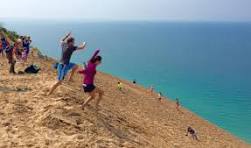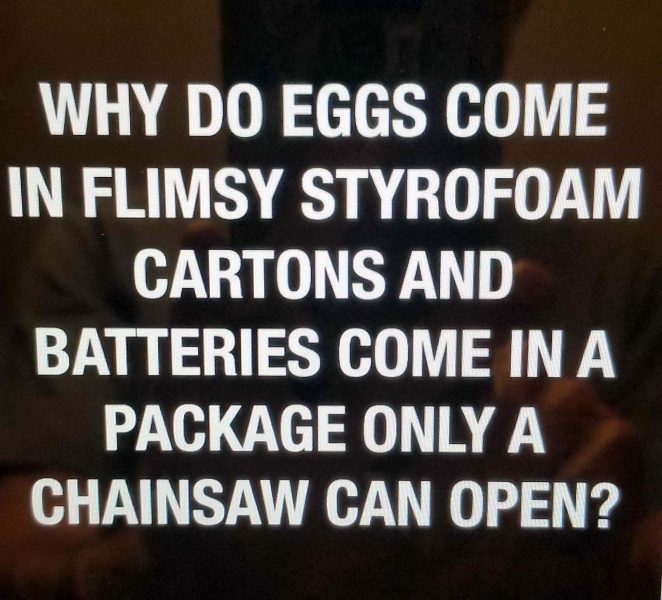


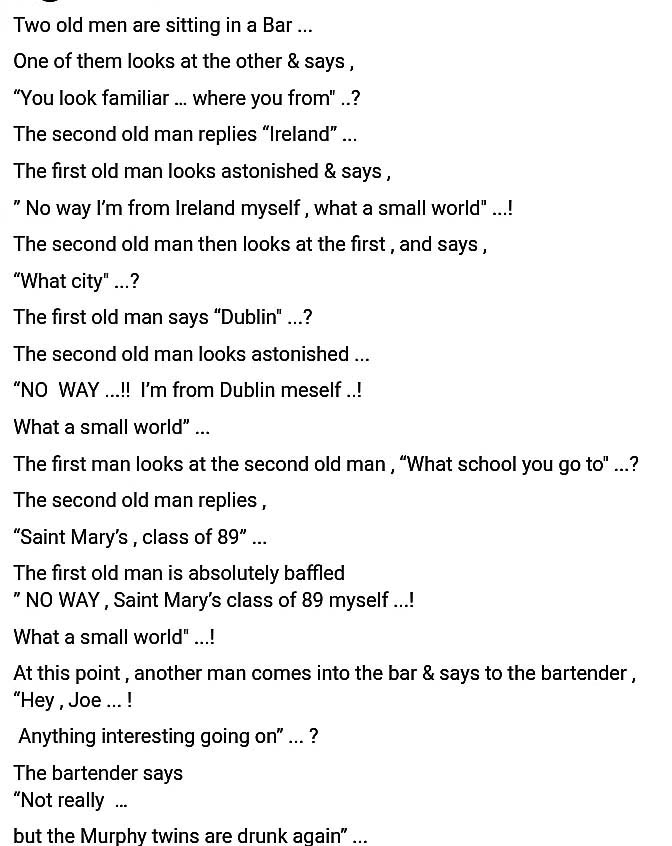








The word “recession” keeps appearing in the news these days. Will there be a recession or not? Here are some recession indicators to guide us.




Theo and I both like to bake. We’ve talked about baking something together for a long time and we finally set a date to do it during his summer vacation from school. Theo wanted to try baking something with a yeast dough, so we made caramel-pecan rolls. They rose beautifully and looked great going into the oven.

They looked even better when we took them out of the oven.

Kari and Ted were also at our house, and the four of us all thought it would be a good idea to have a warm caramel-pecan roll, fresh from the oven. It was a great idea, and they tasted delicious!

It was fun to do this with Theo, and we want to do it again. Next time, I’ll go to his house and Theo will teach me to bake something he likes that I’ve never tried. Yummy!
I ordered a birthday gift from Wal-Mart for Hadley’s birthday. As usual, I received shipping updates. I was surprised to see an update telling me that the package would arrive at 2:59 pm local time. I texted Thom to watch the porch and let me know what time it came. Thom and I were both impressed when it arrived at 2:59 pm!

The Pizza Hut near our home offered take-out pizzas during the COVID pandemic, but did not open for indoor dining until mid-2024. Business must be slow, if my photo of this sign, taken several months ago, is any indication.
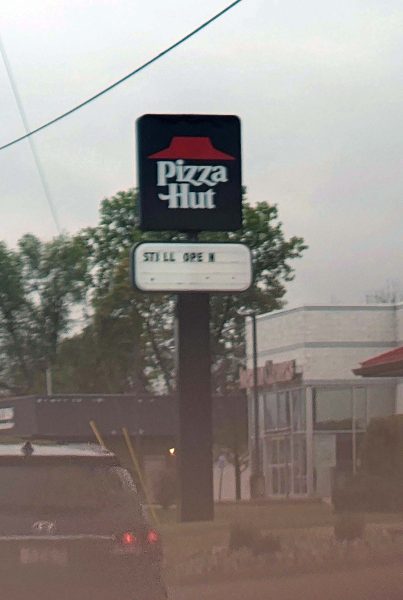
Our across-the-street neighbor, Paul, has (now, had) two 75- to 80-foot tall oak trees in the front yard. There were a lot of galls on the trees, and he didn’t like all the wasps that were hanging around his yard. Galls form when gall wasps lay their eggs on the branches of the tree. The galls girdle the branch and are basically the tree’s reaction to the presence of insects. Here’s a picture of what the galls look like.

Paul decided to cut down both trees. He told us that he and his son were planning to take the first tree down last week. He said they’ve rented equipment and taken down trees in the past, and would do it again. After our conversation with Paul, Ted and I went home, figuratively scratching our heads. That was a mighty big tree to fell unless you’re a professional, so we hoped Paul knew what he was doing. He did. He called a professional tree service to do the job instead.
It took the four-man professional crew four days to do the work. On Day One, they roped one guy and sent him up the tree to cut off the limbs. Before cutting, each limb was roped to the other oak tree so it could be eased down, rather than dropped. The limbs were huge!! I’m not sure what they’ll rope the limbs of the second tree to when Paul takes that one down later this summer. The cutter guy and his chainsaw worked upward until only a few smaller limbs were left at the top. That took all day.
On Day Two, the guys took down the tree trunk in large chunks, beginning at the top. After felling the final piece of the trunk, the second day’s work ended. Ted and I were not at home to watch the process, but that evening, we met our next-door neighbors as they were leaving the restaurant we were entering. The first thing they said to us was, “Hi, neighbors!” The second thing was, “Did your house shake when that tree trunk came down?” Because we weren’t home when it happened, they described it to us. They said the last portion of that huge, heavy trunk fell so hard, it was like an earthquake, and shook all the walls and floors in their house!
The tall tree in the photo below is the other one Paul is going to remove. It’s smaller than the now missing tree. Look at the size of those trunk pieces! The stump doesn’t show in my photo, but it was more than three feet in diameter. And Paul thought he and his son could handle that??!! It’s a good thing they opted out of the do-it-yourself method.
On the next day, Day Three, the crew came back with a claw, a piece of heavy equipment with jaws, to pick up the chunks and put them into a dump truck.

Here’s a closer look at the pieces of the tree trunk. For scale, there’s a tree crew member cleaning up debris at the garage door.

On Day Four, a guy came with a stump grinder. It took him between two and three hours to grind the huge stump. Now, this is all that’s left of the over 40-year-old, tall, oak tree.

Kathy and Annette arrived at our house for lunch on Father’s Day, and Kari and Theo arrived a bit later to spend the afternoon with us. We had lots of fun and good conversation (with scotcheroos) until dinner time. Then we headed for pizza at Dewey’s. Because of the different arrival times, we traveled in a caravan of four cars–ours, Kari’s, Theo’s, and Kathy and Annette’s. I was the leader and managed to set a pace that allowed all of us to stay together on the roads, because not everyone knew the way to Dewey’s from our house. Dean met us at the restaurant, giving us seven people who came in five cars. Wow!
The girls’ families treated Ted and me to dinner and we enjoyed more group conversation as we ate. Too soon, it was time for Kathy and Annette to start their (roughly) three-hour drive home, but it was a good day with our family and a great way to celebrate our dads. Dean and Ted, you two guys are the best!

Ted and I celebrated our 56th wedding anniversary with a two-day event this year.
A number of years ago, when we didn’t know what to buy each other for birthday and anniversary gifts, we realized that we’ve reached a point in our lives that allows us to buy what we want when we want it, rather than waiting to receive it as a gift from each other. We decided to skip birthday and anniversary gifts and to treat ourselves three times a year to dinner at our favorite restaurant–Bentley’s, at the Lake of the Ozarks. It’s nearly a three-hour drive to Bentley’s and we drive, eat, and drive home on the same day (we’re night owls). It’s not fun to drive that far in crummy weather, so we check the forecast to see which day near our anniversary date will have the nicest weather. This year, it was Tuesday. We had our usual delicious meal and, as always, as we were driving home, we told each other that the meal and the staff (who we know well after all these years) are worth every minute of the drive.
Usually, that’s the extent of our anniversary celebration, but this year was different. Our anniversary fell on the same day as the “No Kings” nationwide protests, and we decided to attend our first protest. I never attended a protest in the 1960s because I am far less brave than those who did. I did not want to go to jail (do not pass go; do not collect $200), nor did I want to be beaten with a billy club, fired on with a fire hose, or corralled by a martial dog. The “No Kings” protest at our local mall looked much safer than the Vietnam and civil right protests, so we went. It was a large, happy crowd that stretched about a half-mile along the sidewalk, but the traffic was backed up farther than that. We picked a good protest for a starter. Nationally, an estimated 5 million people participated.



Later, I saw this protester in my news feed and, if I’d made a sign for the protest, it would have had a picture of Elvis with a caption that said “the only American king.” (Long-time Elvis fan here.)

The protest ended at 1:30, so Ted and I ran a few minor errands and then had hot fudge sundaes to celebrate our day.

Even though we’d had a fantastic anniversary dinner at Bentley’s earlier in the week, we didn’t think we should cook or do dishes on this special day, so we ordered a carry-out pizza, lit our anniversary candle (a wedding gift from our florist with instructions to burn it every year on our anniversary, which we’ve done), and watched the PBS movie of the week–Alfred Hitchcock’s “The Man Who Knew Too Much.”

We had a great anniversary and we’re looking forward to the next 56 years together. 🙂
My friend, Liz, and a friend of hers have season tickets to performances at Stages, the theater at the Kirkwood Performing Arts Center. Unfortunately, Liz’s friend was ill and could not attend the June performance. She generously told Liz to gift her ticket to someone else, and Liz asked me if I’d like to join her for lunch and the play. I said “yes.”
We started with lunch at Café Provencal. Liz promised me a “very European experience” with delicious food. I enjoyed it so much, I can’t wait to take Ted there so he can enjoy it too. The restaurant has lots of outdoor dining, and the weather was nice, but the restaurant sits at the side of a very busy street with lots of traffic noise, so we opted for indoor seating. The decor was very French. We each had a salad and (are you ready for it?) French onion soup. We agreed that it was the most delicious French onion soup either of us has ever had. The best word we could think of to describe it was “depth”–a depth of flavor that provided a taste of substance far beyond water plus the usual ingredients. (I should be a food critic.) I’m going to order the soup again when Ted and I go there, just to repeat that gastronomic experience.
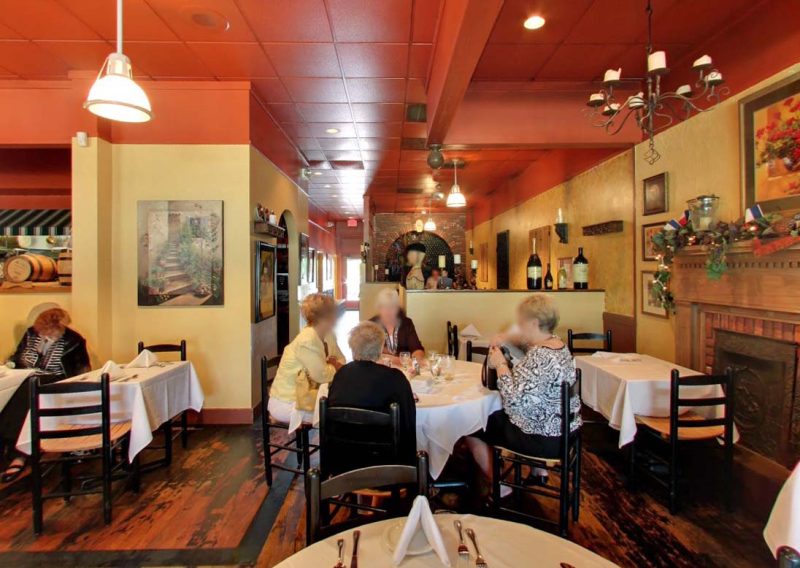
Stages is only a few blocks from the restaurant and we had time to enjoy ourselves in one of the lounge-type seating areas before the doors opened for the performance. It’s an intimate theater (read “small”) with free adjacent parking and only 529 seats. (529? Really? One more seat would make a nice round number.) Our seats were in the first row, center, of the balcony.

The play was titled “Murder for Two.” The “two” refers to the fact that there are only two performers–and they were both outstanding. Together, they play 13 roles and the piano. The plot is a musical farce about a small-town police officer who dreams of becoming a detective. When a Great American Novelist is murdered, the officer jumps at the chance to prove he has the skills to be promoted to detective. He works with his partner (the other actor), and they discover who the killer is–more by accident than skill. It was fun. The two men played the piano throughout the performance–sometimes individually, sometimes together–and sang songs that provided plot exposition.

The restaurant was charming, lunch was delicious, the play was fun, and time with Liz?–priceless. That’s what friends are for.
Our family has five birthdays, plus Mother’s Day in a 23-day period, so we often celebrate our birthday “season” with group events. This time, we celebrated three birthdays at Kari’s house.
The custom is to open gifts in the calendar order of the birthdays, so Dean was first. One of his gifts was a bag of his favorite candy.
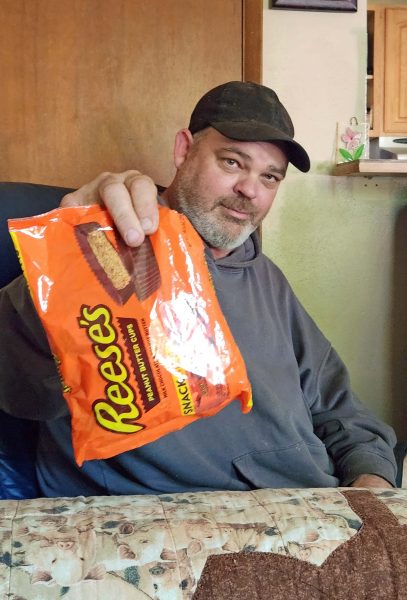
Theo received a sketch pad so that he can continue to amaze us with his artistic pencil drawings.

Kari has been wanting to make her own vanilla, so my gift to her was a jar, vanilla beans, and rum. She’s so happy, it looks like she’s already enjoying the rum instead of saving it to make vanilla!

Theo made the birthday dessert: a chocolate cake with mousse and ganache. “Delicious” doesn’t begin to describe it. It was a chocolate lovers’ dream–and Theo and his Grandpa Ted have always been choc-o-holics.

Don’t you love birthday parties?!
I love it when I accidentally run across photos and other things I’ve forgotten about. Those items give my spirits a lift with the memories they bring to my mind.
I recently found this photo of Kari and Dean, leaving to celebrate MORP–the opposite of PROM and, technically, an anti-prom culture activity. I don’t remember where they went that evening, but it wasn’t to the prom.

On another day, I found a picture of Jeff and La, taken at their wedding reception. They look so young! It’s hard to believe they are now expecting their second grandchild.
Author’s note: This is one of the few pictures in which Jeff resembles me. Face-on, he’s such an image of his dad that, at his son’s wedding, another wedding guest introduced himself to Ted and remarked, “You must be Jeff’s dad. He’s the spitting image of you.”
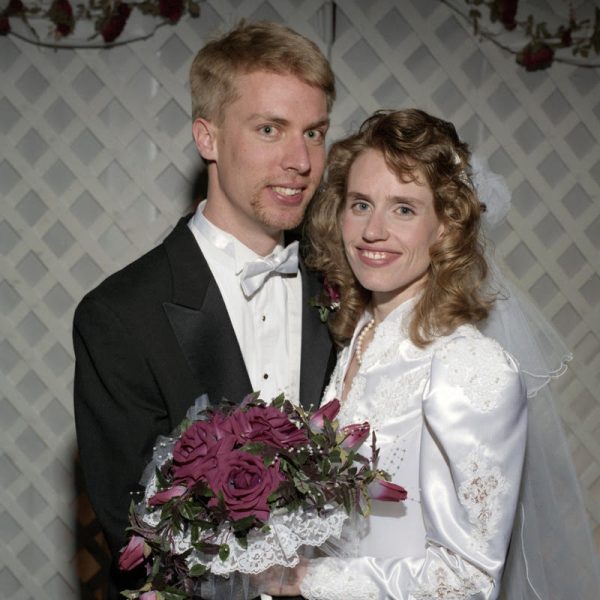
Finally, I found this object in the back of a drawer. My uncle Gibby was a typesetter. When I was a child, he set type and made print blocks for his children and his nieces and nephews. If I press mine onto an inkpad, it still “prints” my name.
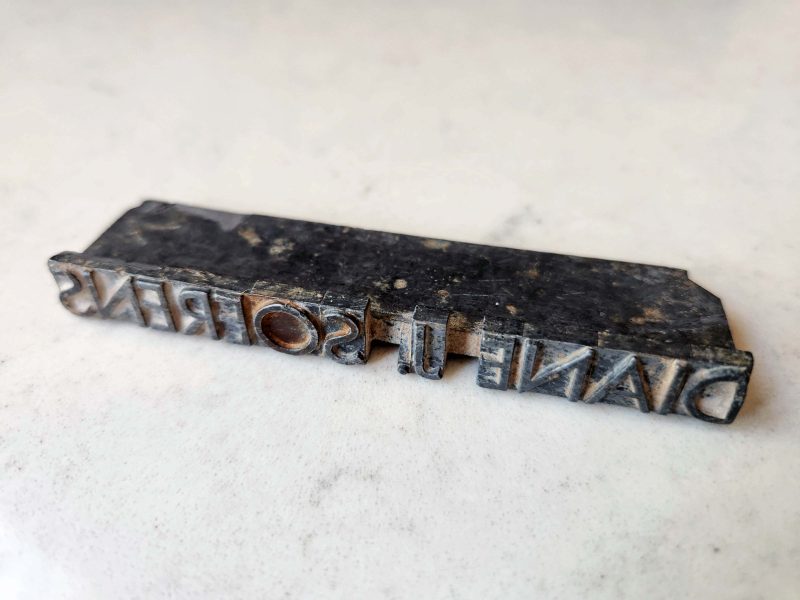
My surprise finds are unpredictable. I wonder when and what the next one will be.
I think it’s been five years since Kathy and I spent a day together in Columbia. We’ve been together regularly during the intervening years, including some meetings in Columbia, but always with other family members. In May, Kathy invited me for a mother-daughter day in Columbia again, and it was wonderful to have nearly 11 hours of each other’s exclusive company. Including family members is a good thing, but so is one-on-one time.
Over the years of our “Columbia Days,” we’ve established a routine for our get-togethers. Columbia is a halfway point for each of us, and we meet at the intersection of our routes–US 63 and I-70. There’s a Bob Evans restaurant at the intersection, where we begin our time together with lunch. The restaurant is not usually crowded, so we eat and talk for about two hours before heading to downtown Columbia.
The next part of the routine is to walk Broadway, the main street through the downtown area, stopping at our three favorite stores: Blue Stem, Peace Nook, and The Candy Factory. Blue Stem offers a variety of unique and beautiful artistic creations made by Missouri artists. Peace Nook is an eclectic store that reminds me of the 1960s and 70s, describing itself as “a non-profit store . . . with all proceeds supporting our educational work to promote peace, social justice, sustainability, and a liveable climate.” The Candy Factory crafts gourmet chocolates and other candies. We sometimes buy something at Blue Stem; we always buy something at Peace Nook; and we always buy our specific chocolate favorites (and sometimes others) at The Candy Factory.
After our time downtown (usually late afternoon), we head for the mall food court where we purchase beverages and eat some of our chocolates while we talk for several hours. Then it’s time for a late dinner at Shakespeare’s Pizza, where we eat and talk for a few more hours before going home.
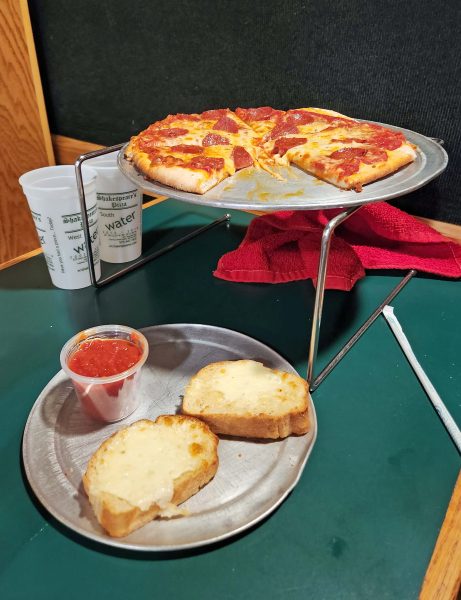
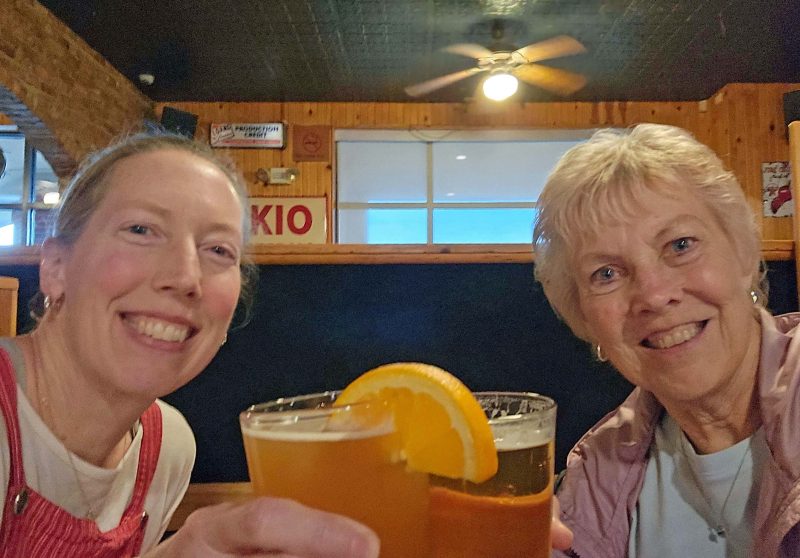
The real purpose (and my treasure) of our mother-daughter day is our personal conversations. It’s always hard to leave for home after our Columbia Day, knowing that this special day is over, but we each face a 90-minute drive, so we reluctantly go back to Bob Evans (where we’ve left one car for the day), get into our cars, and go home. Until next time, . . . .
Ollie has some news for us.

Ted and I have greatly enjoyed the friendship that has developed over the past seven months with our friends, Mike and Mary Jane, and the feeling is mutual. It was bittersweet to share our last get-together in early May during the final days of their mission in St. Louis as they prepared to return to their home in Utah. As always, we had a great time together.
For our farewell evening, Ted and I invited Mike and Mary Jane to dinner at our house. On a previous visit, the four of us had talked about the wonderful things you can make with rhubarb: sauce, pie, jam, etc. I asked if they’d ever had rhubarb kuchen, and they said, “No, what is it?” I know a lot of people who don’t like rhubarb (or have never eaten it), but the four of us all admitted to growing up with and liking rhubarb. Early May is rhubarb season so, as long as I was freezing rhubarb, I set some aside to make a rhubarb kuchen for our final group dessert.
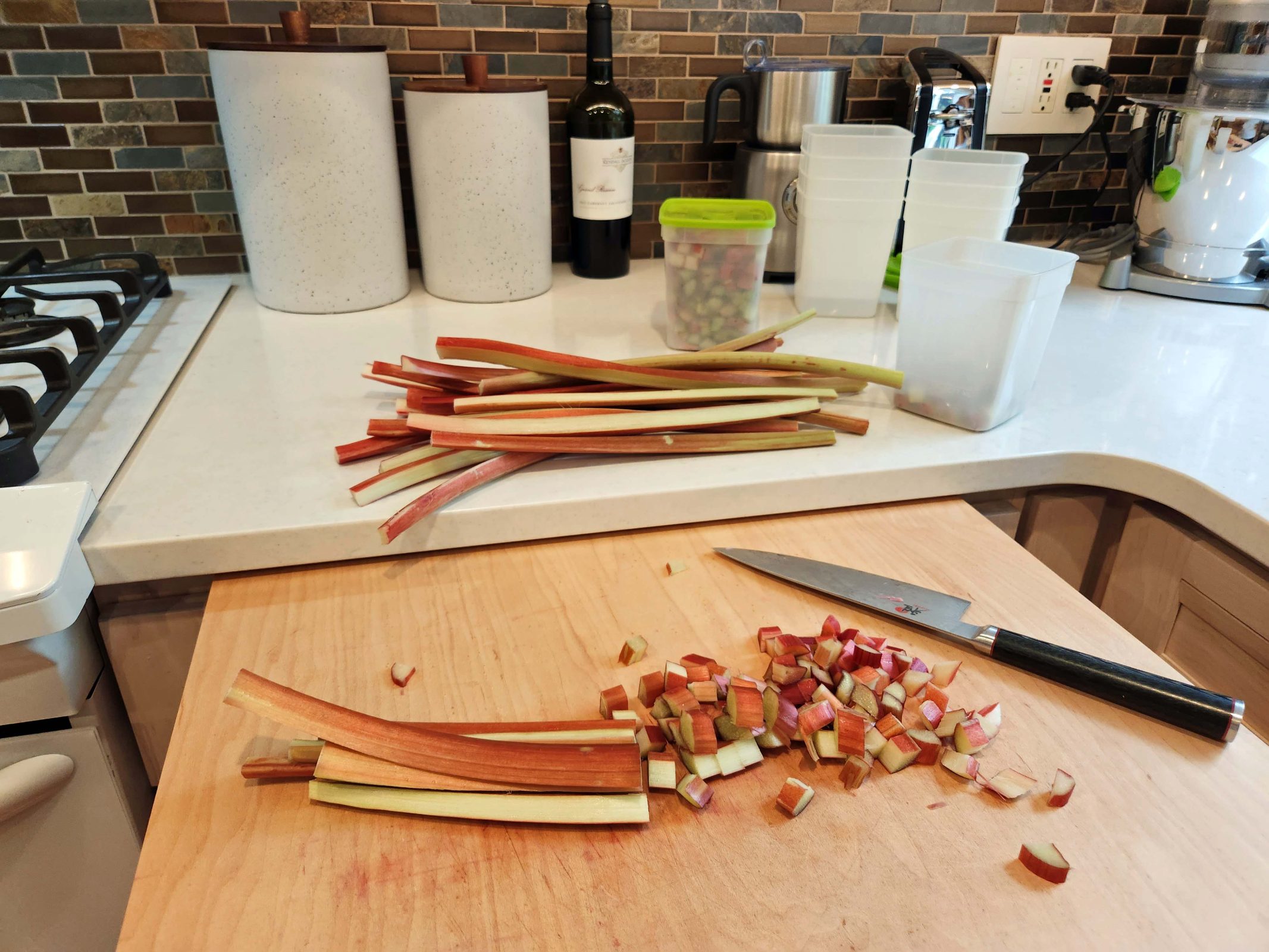
Mike’s reaction was totally unexpected. I can honestly say that I’ve never seen anyone’s eyes light up like Mike’s did when he saw the kuchen. “Is that rhubarb?!” he asked, in a tone of disbelief. It was extremely flattering to the person who baked it for Mike. (Ahem. Me.) Mike ate two pieces and smiled through every bite. Mary Jane asked for the recipe so she could make it in the future.
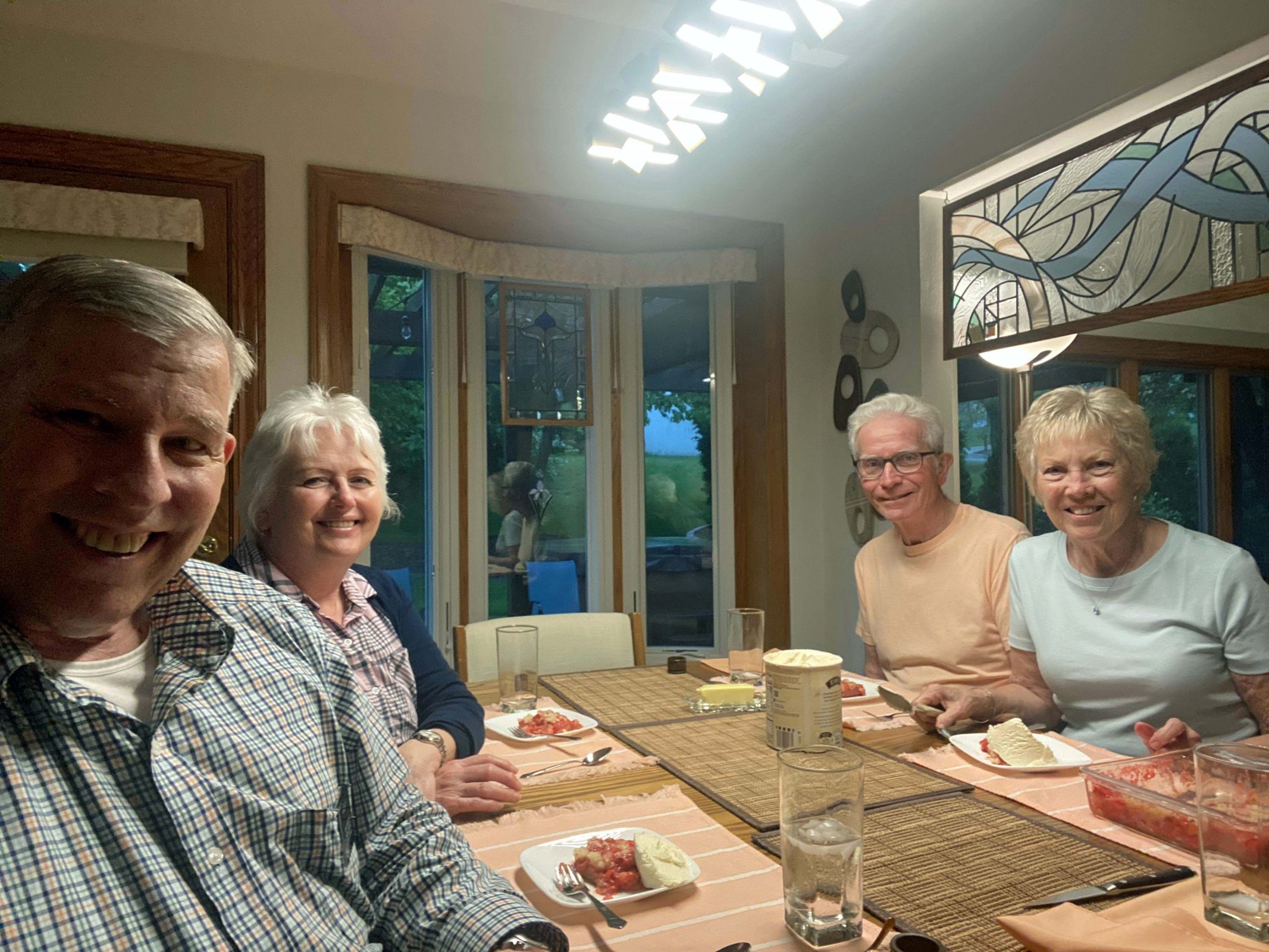
Our evening together stretched out a little longer than usual because none of us wanted to say good-bye. When it was finally time for Mike and Mary Jane to leave, there were hugs and then repeated hugs. We’ll keep in touch and we hope to see each other again in the future, but it won’t be regularly like it’s been over the past seven months. Bittersweet is real: wonderfully happy friendships with emotionally difficult partings.
P.S. My rhubarb kuchen recipe is from my grandmother. Our son, Thom, liked it so much, he always ordered it for his birthday cake. Luckily for him, his birthday falls in rhubarb season.
Fall 2024 was so warm that our daffodils sprouted in November. They grew to almost 4 inches tall before it became cold enough to discourage them from getting taller. At the time, I assumed they were a lost cause for spring blooms. “If the bulb has sprouted and then the weather becomes too cold for it to keep growing,” I reasoned, “it probably won’t re-sprout in the spring.” I resigned myself to missing our cheerful row of daffodils in Spring 2025. Happily, I was wrong. When the weather warmed up, the daffodil leaves started growing where they left off in November and produced full-sized plants with full-sized blooms. Conclusion: Daffodils are extremely hardy!

While we always look forward to the daffodil blooms, Ted and I are tired of deadheading and pruning the many roses a 2010 landscaper planted around our property. Last fall and this spring, Ted dug out all but four of those rose bushes, ran them through his wood chipper, and replaced most of them with annuals. The remaining roseless area was a large. empty bed at the garage corner of the house. We had curbing and landscape rock put into that bed several years ago, and we didn’t want to remove it, so we needed to replace those prickly roses with something big to fill that space. We chose a lilac bush. It won’t need nearly as much care as roses did, and the blooms smell wonderful when we walk near them. You can see in the photo that it has lots of room to grow before it will need pruning.
The redbud tree we planted a few years ago started dying late last summer and gave up the fight over the winter. The nursery folks were greatly surprised to hear that a redbud tree didn’t survive, since redbud trees are indigenous to Missouri. We like seeing the redbud blooms in the spring, so we decided to try another one. We had a few blooms from it this spring and we look forward to lots more in the coming years. The new redbud is the little one behind the landscaper on the right. It has some growing to do to catch up with its dead predecessor.
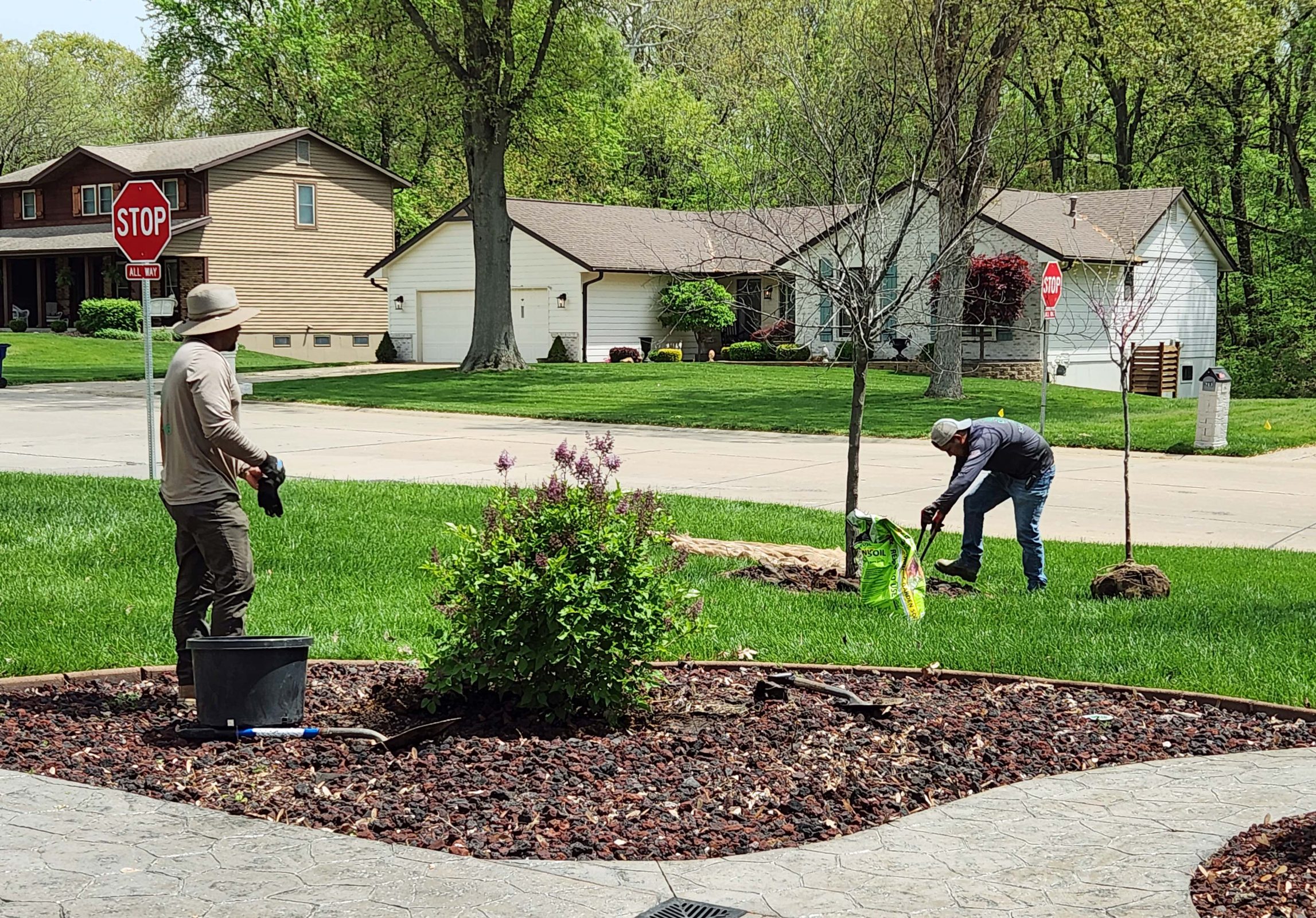
As I was talking my daily walk on May 5, I saw this pretty cloud. Someplace east of us, thunderstorms were forming.

On May 15, I was driving to the mall to do some shopping and saw this huge cloud. I stopped to take a picture of it and to call Ted, telling him it would be worth his time to go to the top of the hill behind our house (less than a half-mile away) to give his meteorological heart a thrill.

From near our house, the above cloud looked pretty amazing but when I got to the mall, which is on high ground with a big parking lot and no trees to block the view, I was awestruck. I couldn’t believe what I was seeing! This cloud extended 180 degrees from north to south on the eastern horizon. I have never seen a cloud that covered half of the horizon! Obviously, a line of thunderstorms was developing–probably in Illinois.
About an hour later, when I finished shopping, the sun was setting and it cast a rosy glow on the same cloud formation. The cloud still covered 180 degrees of the horizon and the thunderstorms were still developing. When I got home, Ted and I checked the radar and saw a solid line of severe thunderstorms stretching from just southeast of St. Louis to Chicago. Wow!

The next day, May 16, I needed to do some shopping at the Galleria in the Central West End area of St. Louis. There were some weather watches posted, but the storms were not expected to reach our area for another two hours–more than enough time for me make the trip and to be home before the storms hit. When I finished shopping, I checked the radar again to see if I should run some errands in our home area or if I should go straight home. It looked iffy, so I decided to make the call when I was closer to home.
The skies were gray when I left the Galleria, indicating an impending storm, but the weather didn’t look dangerous. As I drove farther west, the sky became very dark for a while but then became lighter when my route turned to the north. About halfway home, the rain hit. It was pretty heavy, so my wipers were working rapidly. I made the call to go straight home and to finish my errands after the storm. When I was about two miles from home, the wind hit, blowing sheets of rain across the roads. About a half mile from home, the hail started falling. It was pretty small hail–about 1/4-1/2 inch in size–but I didn’t want hail damage on my new car. With no other cars in sight, I admit that I exceeded the speed limit for the half mile from that point to our garage, where I could put my car under a roof, safe from the hail. It was a good call to skip my home-area errands!
Here’s how the hail looked in our pool. It fell hard enough that some pieces of hail bounced when they hit the surface of the water, then fell back down into the water. It looked like white jumping beans. Our largest hail was 1.5 inches, in flat pieces. Hail covered our lawn, but not completely.
After the storm, I went to Target (I had a lot of errands to do that day) and I overheard a lady and her husband telling a salesperson that they lived only a few miles south of Target and had an 18 to 24-inch accumulation of hail on the ground! The lady said she had gardening buckets outside that were filled and then covered with hail! Their 5- or 6-year-old daughter piped up and said, “It was really deep!” Their largest hail was baseball-sized.
When the hail stopped falling, the wind became apparent. Fortunately, we live in a valley between two hills–one behind our house and one across the street from the front of our house, so we tend to be sheltered from wind. Today, however, the wind blew the pool water surface as if it were a lake (without the whitecaps).
Meanwhile, east of us, a tornado struck very close to the Galleria Mall, where I had been shopping 30 minutes earlier. Looking at the radar when I got home, I saw that I basically drove around the tornado development area (where the skies became very dark) and, thankfully, didn’t need to take cover during my drive home. These are photos of the wedge tornado that struck St. Louis, taken by a camera in the Gateway Arch. The lower photo is darker because the tornado is closer and the air is filled with more debris. The red arc-shaped structure in the lower left corner of the photo is Busch Stadium.
A wedge tornado has a width equal to its height. This one was an EF3 tornado a mile wide, moving at 55 mph, with winds of 152 mph. It traveled 8 miles through the Central West End of the St. Louis area, destroying a 20-block area and damaging roughly 5,000 buildings. It struck along the north side of Forest Park and caused extensive damage to the St. Louis Zoo, which is temporarily closed as a result. The tornado initially touched down in Clayton, then tracked 23 miles to the northeast into Illinois. Sadly, there were 5 fatalities in St. Louis due to the tornado.

An EF4 tornado struck Lambert Airport in April 2011, and the damage in that area was visible for years. This tornado struck a more commercial and more densely populated area, so I suspect the recovery will, again, be a lengthy process. A few weeks ago, Jeff wrote a mission letter suggesting that we all look for the small miracles that occur in our lives each day. Today, my pretty big miracle was leaving the Galleria Mall when I did and arriving safely at home.
Tonight, Ted and I went out for dinner. The restaurant parking lot had only a few empty parking spaces, so I picked one and pulled in between two pickup trucks. My Hot Mama car looked more like Baby Car.

I buy all of my spices from the Spice Shop where they are fresh and less than half the price of the grocery store offerings. The Spice Shop buys the fresh spices in bulk and puts them in clear plastic containers for sale to customers. When I switched from grocery store spices to Spice Shop spices, I saved my empty grocery store spice bottles and filled them with Spice Shop spices.
We updated our kitchen in 2023 and I ordered a built-in spice rack in the cabinet door over the countertop where I cook and bake. With my spice jars obviously displayed whenever I opened the cabinet door, I wanted some uniformity, so I bought new jars.

Those jars were a disappointment. They were plastic, and my labels didn’t stick very well. They also warped for no apparent reason and became oddly shaped, with large dents on the sides. I searched all over for the kind of jars I wanted (clear glass, square, spice-size, removable shaker caps under the lids) in the quantity I needed (25-30 jars) online and ordered them.
After washing the jars, I started transferring my spices to my new jars. That little blue funnel came with the jars. The containers of spices on the right are from the Spice Shop.
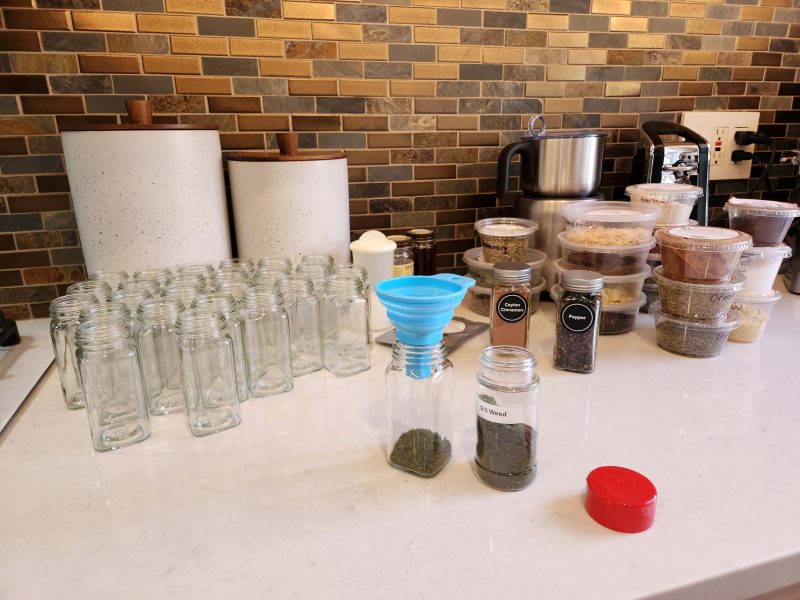
Now I have what I wanted when the spice rack was installed in 2023: an attractive and uniform array of spices.
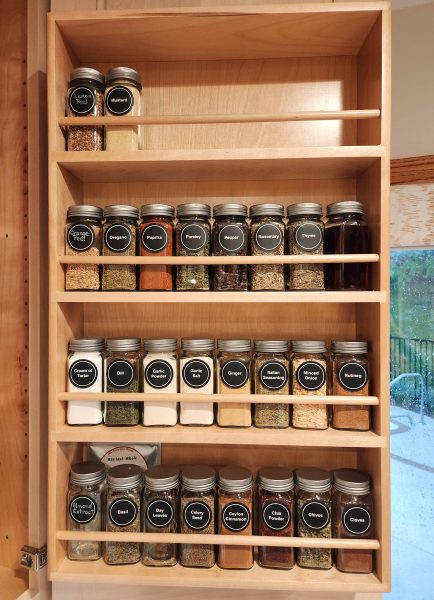
One day in early March, Ted decided spring was coming, and he thought it was a good time for him to clean the solar lights that we put around the pool. It was a raw, cold, rainy day (see his puffy winter jacket and the wet driveway beneath his car). He backed his car into the driveway so that he could work in the relative comfort of the garage. If it had been up to me, I’d have waited for a warm, sunny day, but he’s a hard, dedicated worker, and he got the job done. That’s my man.

For my 60th birthday, Kyra made a special picture of her and me and she attached 60 Hershey’s Kisses around the edges to form a frame. I’m the one with the short hair. 😉 Note that, in the picture, she and I are holding hands, indicated by the single extended arm. ♥

Ever since Kyra gave me the picture, I’ve kept it on display on the top of the “grandchildren toy cabinet.” Kyra was surprised to learn that I still have the picture. I shared the candy kisses instead of saving them for posterity, but I treasure the picture.
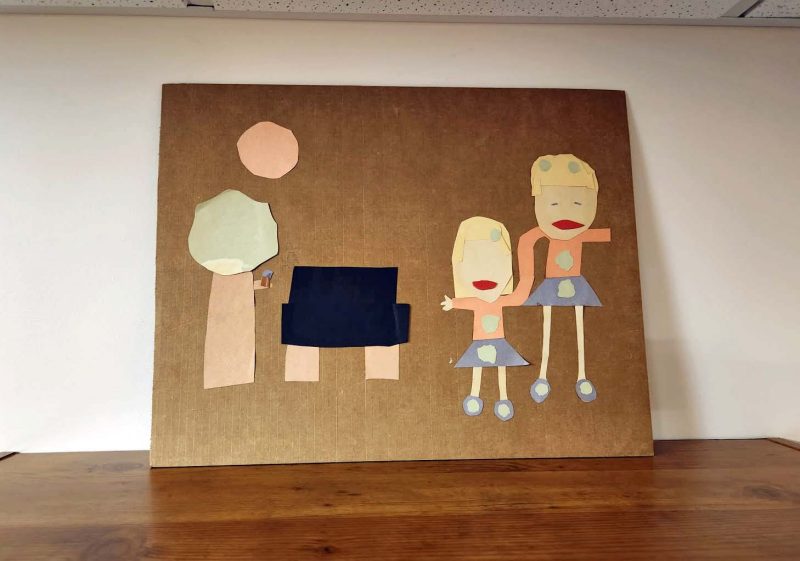
When our two sons were little, they loved playing with Lego. In fact, Thom still does. Among other things, he builds Lego flowers and mini-figures and he and I still exchange a Christmas Lego set every year.
Lego has changed over the years. When our sons were little, Lego came in a variety of individual pieces–red, white, black, blue and yellow bricks in a variety of sizes. Now, it’s hard (impossible?) to find simple Lego pieces like that unless you order them online (order the exact number of pieces you want of each type/color) or have a nearby Lego store that sells pieces in bulk. Everything else is a set of Lego that builds an individual item or a small community of related items. Following directions has become more important than imagination.
We still had a box of Lego pieces in our basement. It’s bits and pieces of lots of things, but there are quite a few pieces. Ted and I have kept the Lego because our grandchildren always liked playing with it. One year, we bought a Lego box to store the pieces. When Jeff mentioned that our great-grandson, Ollie, loves Lego and that he (Jeff) was trying to think of some kind of Lego Ollie would like, Ted and I told him we could send our entire box of Lego to Ollie as our gift for his fourth birthday–after all, some of that Lego was originally Jeff’s (Ollie’s grandpa), making it what would now be called “heritage” Lego for Ollie.
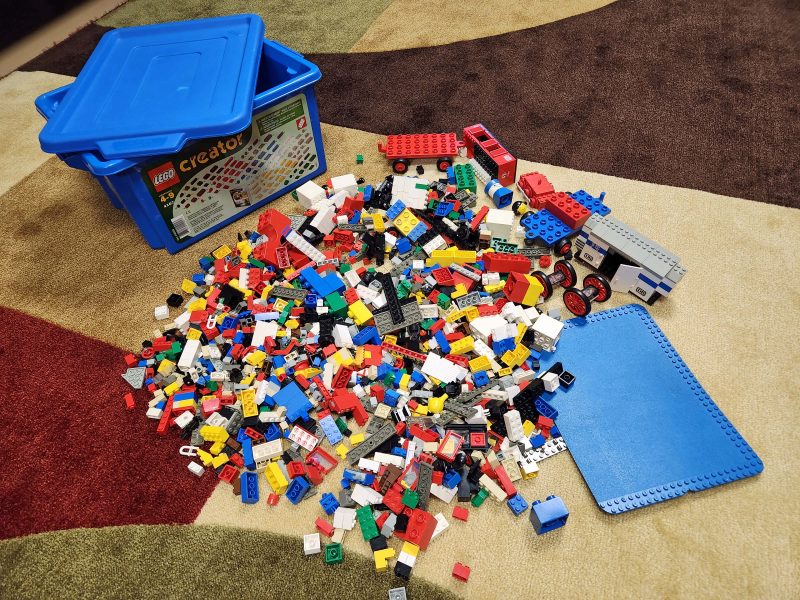
That turned out to be a great idea. A four-year-old can swish piles of Lego pieces around with his hands, pick out what he likes, and stick some pieces together.
After Ollie’s birthday, Alex (his dad) texted the photo below to me. He said Ollie thanks us for the Lego and wants us to see the boat-plane he built. Lego. The perfect gift, filled with imagination.

Author’s note: Lego will probably never die. It’s plastic, so it won’t decompose and, even if you step on it, there’s more pain inflicted on your foot than on the Lego piece.
Tornado watches and warnings are normal in our area in the spring. Most of the time, we don’t get anything worse than a thunderstorm, possibly with some minor hail and/or strong wind. One time, we had tennis ball-sized hail, and one time an F1 tornado blew some shingles off several roofs less than three miles from our house. Every two or three years, the threat might be dangerous enough that Ted and I go to the basement to be close to our shelter and to watch the basement TV in order to stay aware of where the storms are.
So far, we’ve never gone into our shelter because of a storm, but we came very close to doing that on March 14 this year. On that evening, an unusually powerful storm system passed through our area with devastating severe thunderstorms and tornadoes, destructive winds, dust storms, and wildfires, causing 25 tornado-related deaths.
Prior to the storm, we moved our lawn furniture against the house to keep it from blowing around in the wind, and we weighted our hot tub cover with firewood because the wind was trying to lift it off the hot tub. An EF2 tornado moving southwest to northeast entered the Greater St. Louis area and crossed a runway at Lambert Airport, but we are were lucky. We are roughly 15 miles west of the airport and only had severe thunderstorms, nickel-sized hail, and high winds (60 mph gusts). Our only damage was a few 1.5-inch-thick tree branches that were blown off our trees and fell into our yard.
Our record stands: We’ve never actually huddled in our tornado shelter, but it’s always ready for us. Our go-to place for a tornado is the basement closet beneath the stairwell. The stairwell is in the center of the house (no nearby windows) and the basement walls are underground, so it’s our safest place. We keep that closet empty of storage items, except for our survival things. Survival items include some old quilts that we can put on the hard, cold, concrete floor, or cover ourselves with, or take to the community shelter if our house blows away.
Author’s note: My mom made this patchwork quilt for me when I was in college. I remember many of those fabric pieces from clothes she sewed for herself and for me. The orange/pink blanket she used for batting (look at the worn front edge of the quilt) was a wedding gift to her and my dad. The quilt is worn out from use, but I’ll never throw it away. Maybe it will even save my life someday if a tornado strikes our house.

Ted and I have a printed list on the bulletin board in the kitchen that tells us what to gather if a tornado is possible. The list includes things like our electronics and chargers, our glasses, cash, car keys, medications, my good jewelry, Ted’s hearing aid batteries, our bike helmets, etc. Everything else is already in the shelter.
The tote bag under the bottom closet shelf has clothing for both of us: a pair of jeans, two T-shirts, underwear, socks, and jackets. These are all clothes we don’t wear any more, but we might have to take shelter in our pajamas, and we’ll need something to wear when we start cleaning up the mess. We also store our hiking shoes in this closet because we’ll have to walk over a lot of broken stuff after the tornado passes. In addition, we have a weather radio, several battery-operated flashlights and lanterns (we check the batteries every spring), water bottles, and a first-aid kit. Our bike helmets will protect our heads, but we have old pillows in the shelter to cover the helmets and to (hopefully) break the impact of anything that falls on our heads.

Since we moved to the Midwest 47 years ago, we’ve never needed to make use of our shelter, and I’ll be happy if we never do, but we’re ready. Climate change is increasing the severity of storms around the world. This year, we came uncomfortably close to putting on our bike helmets and crouching in the shelter with the door closed.
Ted and I saw this display in the mall one day last winter.
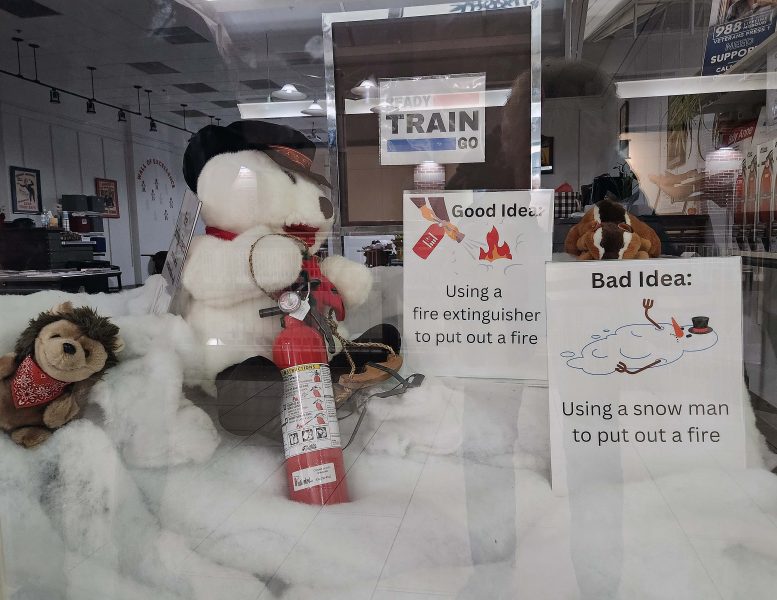
Over the weekend, Kathy came from Kirksville, and Kari’s family members–including Sky, who was in town for a few days–came from nearby to spend some time with Kyra and Hannah. The “Secret Hitler” game produced so much raucous play for most of the afternoon that it seemed like a shame to break it up for dinner.
Theo brought along one of his sketch books and we all had a chance to ooh and aah at his many drawings and witticisms. I requested that the artist gift his grandmother with a drawing. I didn’t give him any specifics beyond that, but he seemed agreeable, so I’m looking forward to seeing what he draws for me.

Kathy’s birthday is coming up, making this weekend a good time to celebrate with her and to save the shipping costs for her gifts. Her favorite birthday cake is funfetti angel food with a Dream Whip / instant pudding frosting. It’s an easy dessert, so I made a birthday cake for her.
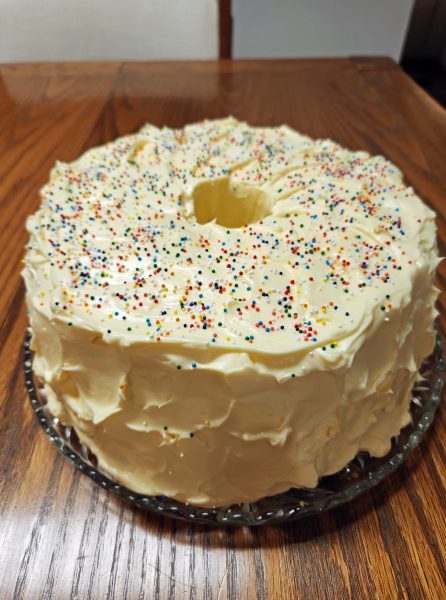
Everyone who wasn’t scheduled to work (we missed you, Dean and Dylan) joined us for a birthday dinner for Kathy, and we all had a piece of cake for dessert.
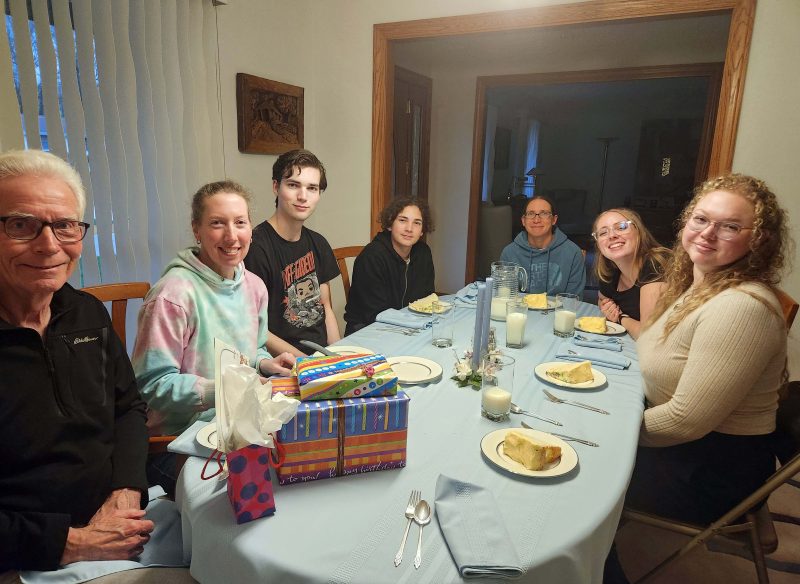
Kathy thought this piece was a good size for her. The story behind that is years old, but it always makes Kathy and me laugh at the memory. Another time, in the long ago, Kathy was here for her birthday, and I made this cake for her. A few pieces were eaten, but most of the cake remained. We were both hungry for a snack, so we decided to have a piece of cake.
That piece was so good, we decided to have another piece. That piece was just as good, so we kept going–one piece at a time for each of us–until the entire cake was gone. We ate nearly a whole cake for an afternoon snack–and we enjoyed every bite! In our defense, it’s an angel food cake, and everyone knows you can squish an angel food cake into a tiny little ball, so we didn’t really eat as much as it sounds like. At least, that’s what Kathy and I choose to believe. We’ve never done that again, but the memory it is still one of our favorite shared times.
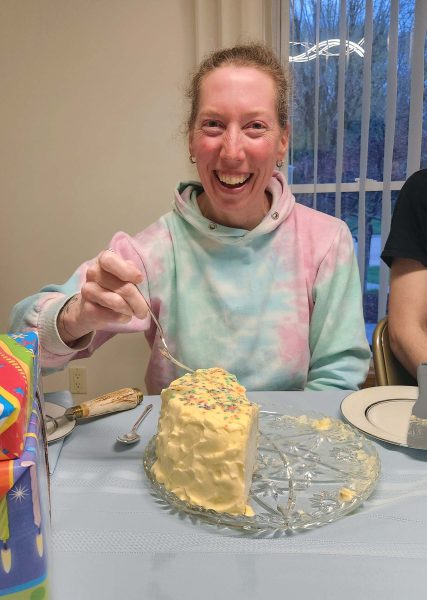
After Kathy and Sky left to go back to their homes, we had one more day to spend with Kyra and Hannah before taking them to the airport for their flight back to Montana. The weather was nice, so we decided to go to Historic Downtown St. Charles for a walk through Kister and Frontier Parks along the Missouri River. After that, we walked through the downtown area with its boutique shops. Kari had the day off from work, so she joined us.

Spring is here and the redbud trees (background) and tulips are blooming.
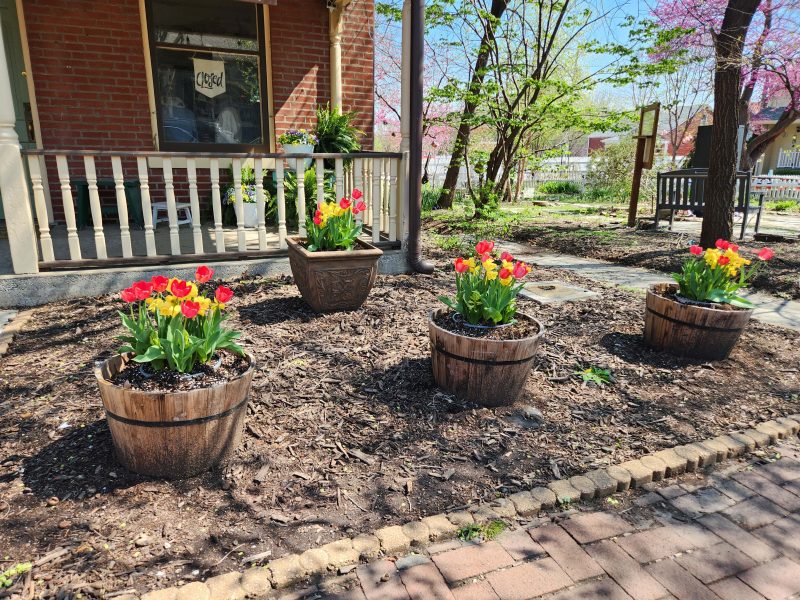
Hannah asked Kyra to take a picture of her sitting in the park.
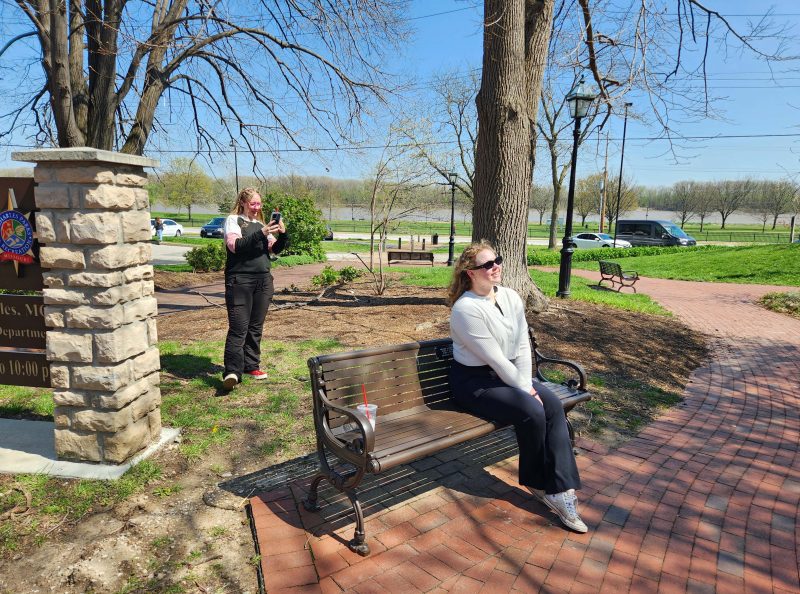
After that, I took a picture of the two girls sitting together, showing off their long hair. Kyra said her hair has been growing for eleven years! The FedEx truck kind of spoils the mood of the picture, but, in spite of that, the girls look like good friends–which they are.
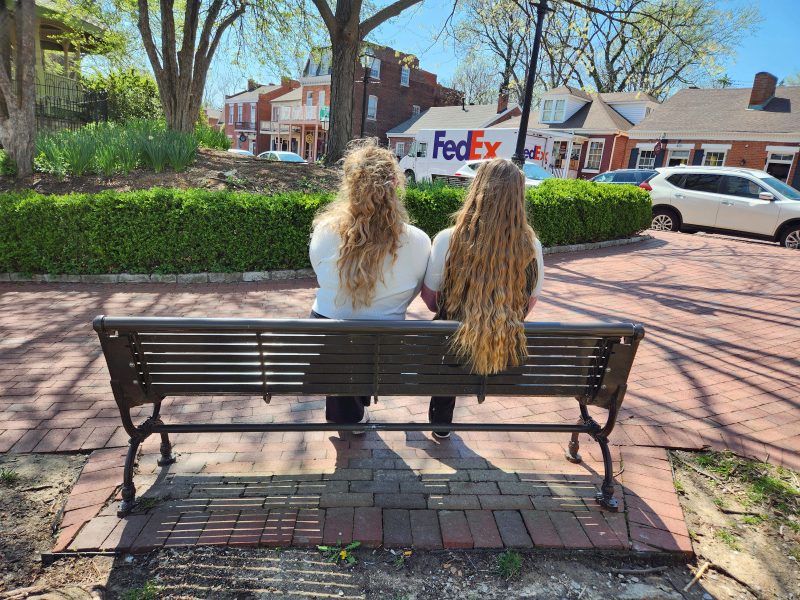
After our time in the park and downtown, the girls needed to pack up their things, so we went home. When they were ready to travel, we had dinner at Dewey’s–Ted’s and my favorite pizza restaurant–on our way to the airport.
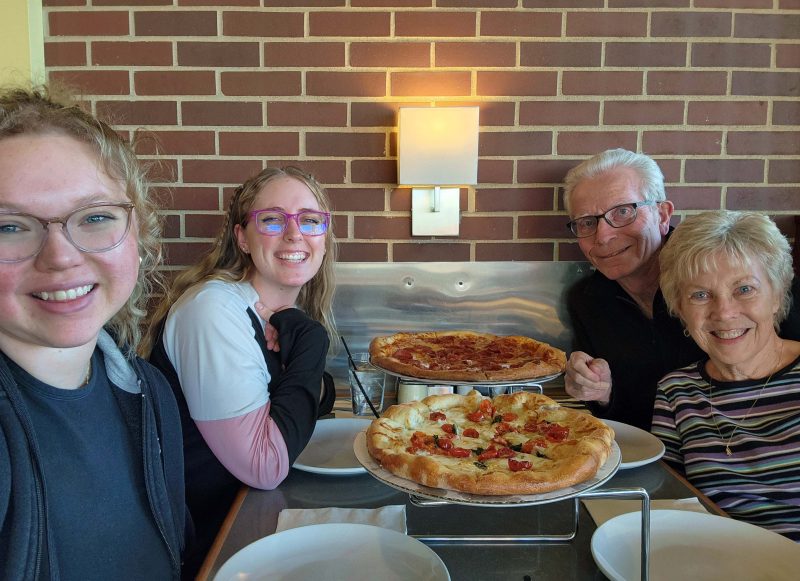
We had so much fun with Kyra and Hannah that we hated to see them leave. It was hard to say good-bye at the airport, but it makes us want to be together again soon for more good times.
Unfortunately, the adage “April showers bring May flowers” was true this week. The weather forecast for Kyra and Hannah’s visit to our area includes rain every day until they leave, when the weather will become warm and sunny. We lucked out with the rain today–most of the time. There was a pause in the light showers while we walked from the parking garage to the Gateway Arch grounds, so we had time to take a picture of Kyra and Hannah posing with the Arch in the background.
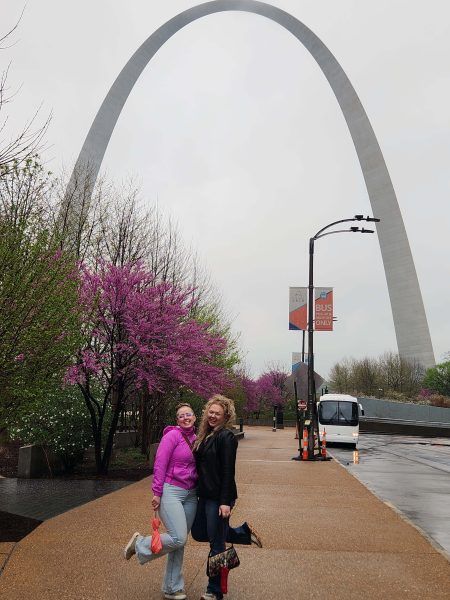
Then we took a group selfie, also with the Arch in the background.
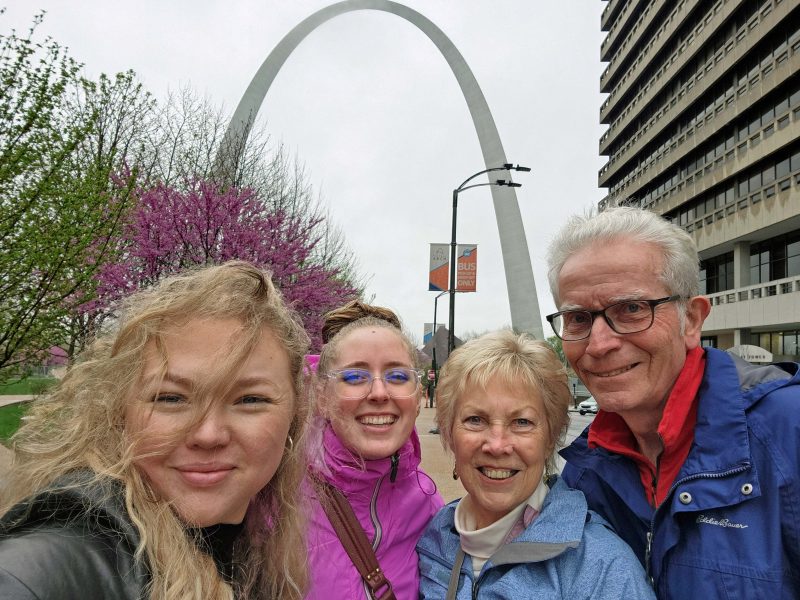
We had extra time before our Tram Ride to the Top ticket reservations, so we walked past the Arch entrance to the Mississippi riverfront. Hannah’s interest in fashion design inspired her to pose for Kyra to take some pictures. I like the bright red umbrella and Kyra’s purple jacket against the green and gloomy background.

The Arch grounds were in bloom. and looked very spring-like. The blooming trees, shrubs, and flowers would have looked even better in spring sunshine, but after winter, everything about spring is beautiful, rain or shine, right?
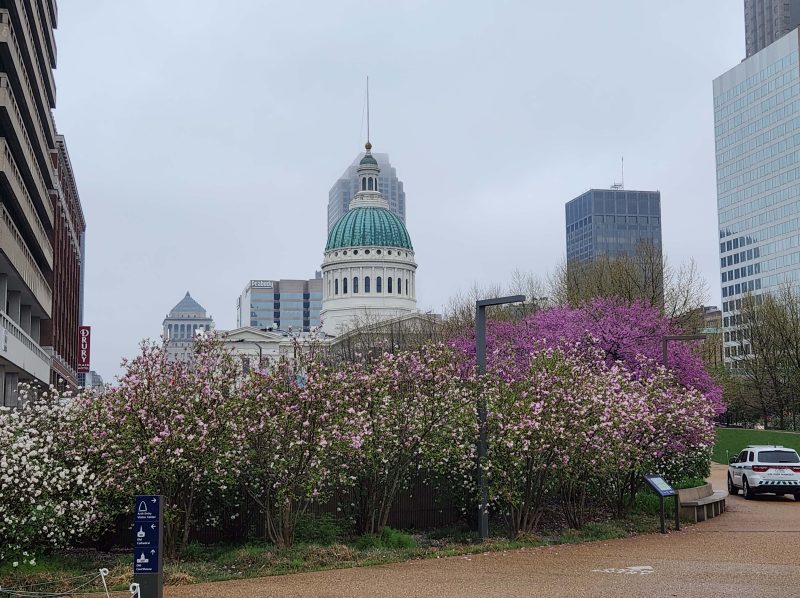
Here we are in our Arch tram car on our way to the top of the Arch–600+ feet above our starting point.
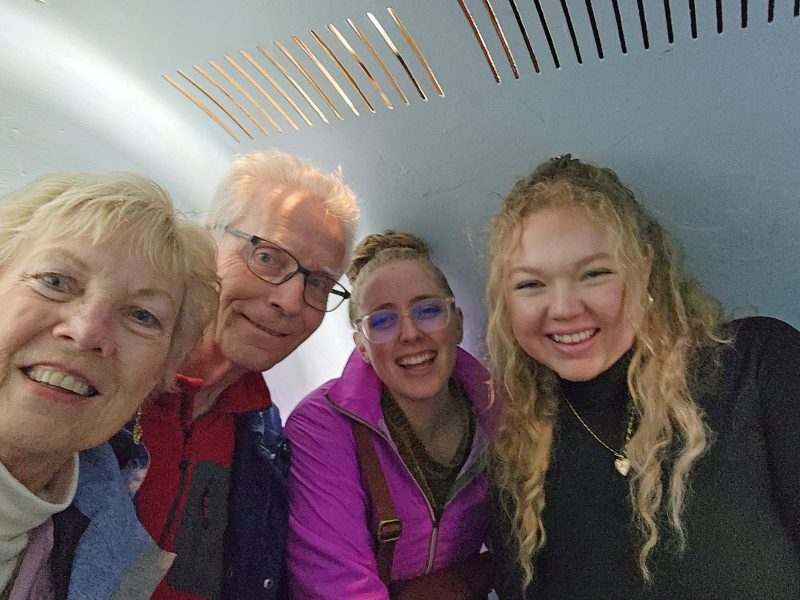
On a clear day, the view from the top extends for miles; today, we could see downtown St. Louis. The red curved structure in the left of the photo below is Busch Stadium, the home field for the St. Louis Cardinals baseball team.
The green-domed building in the center of the photo is the Old Court House. This was the site of the U.S. Supreme Court’s 1857 Dred Scott v. Sandford decision which held that African Americans, whether enslaved or free, were not and could never become citizens of the United States. If they were not citizens, they could not sue in federal court. The Court also ruled that Congress lacked the power to ban slavery in the U.S. territories, effectively invalidating the 1820 Missouri Compromise, which prohibited slavery in the Louisiana Purchase territory north of the 36o30′ parallel, except for Missouri–a decision that escalated political tensions leading to the Civil War.
All that green grass in the photo covers the Arch grounds. The 2018 update to the Arch included covering I-70 (the road running horizontally across the photo) and making it possible to easily walk from downtown St. Louis to the Arch. The light-colored semicircle around the fountain is the glass ceiling of the Arch entrance. The visitor center, museum, and tram access are all under the ground between the entrance and the Arch itself.

Two minutes after I took the photo above, the fog and the rain moved in.

Less than two minutes after that, the fog and the rain moved out again. Talk about quick weather changes!
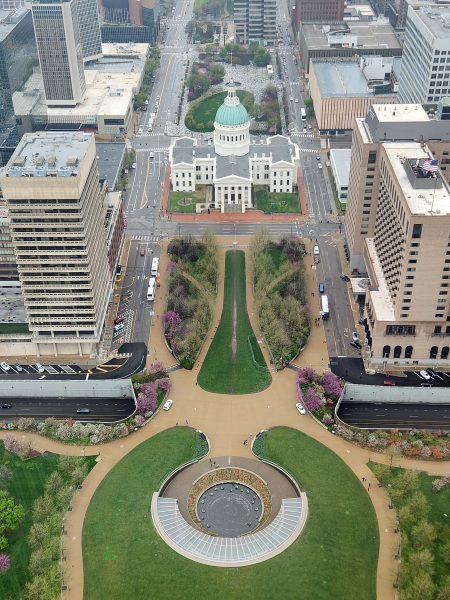
There are countless varieties of Arch souvenirs in the gift shop. This Arch is made of, not Lego, but 1,930 pieces marketed as “Mini Building Blocks.” Note the smaller Arches sheltered by the large one (not included with the 1,930-piece building set).
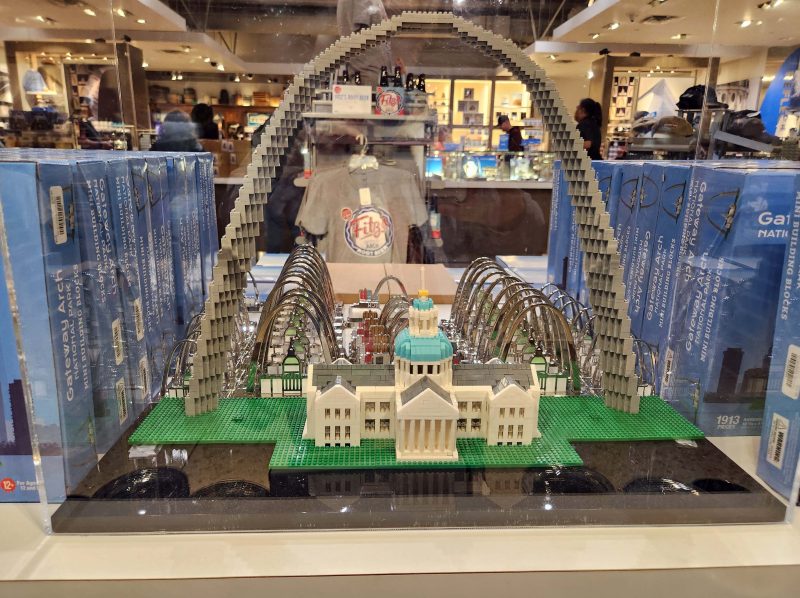
Here’s a close-up of the Old Court House which is no longer used as a court house. It houses a museum with a large Dred Scott decision exhibit among other things, and also serves as the ticket and tourist information center for the Arch and the Tram Ride to the Top. (We bought reserved tickets online in advance.)
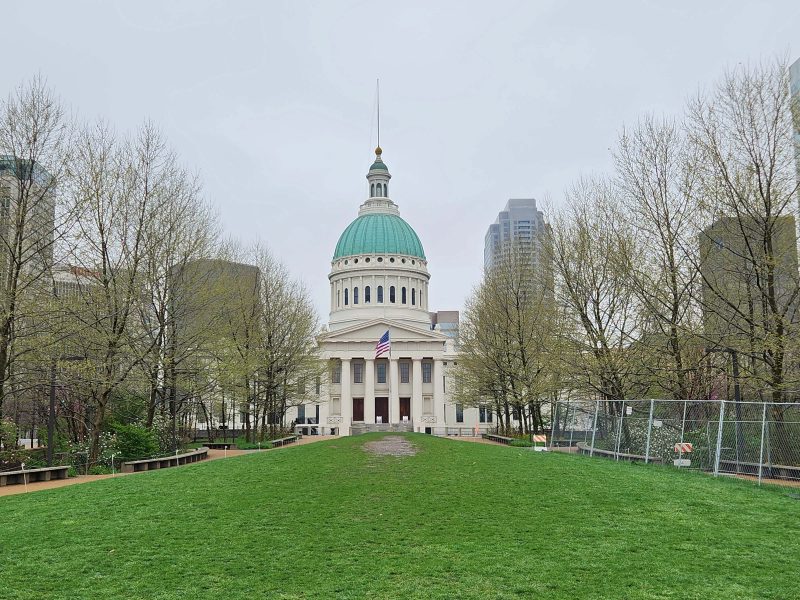
We lucked out again when we left the Arch and went back to the parking garage–it was still cloudy, but without even a drizzle of rain in the air! Our next stop was the Science Museum in Forest Park. Check the sign in the lower center of the photo below.
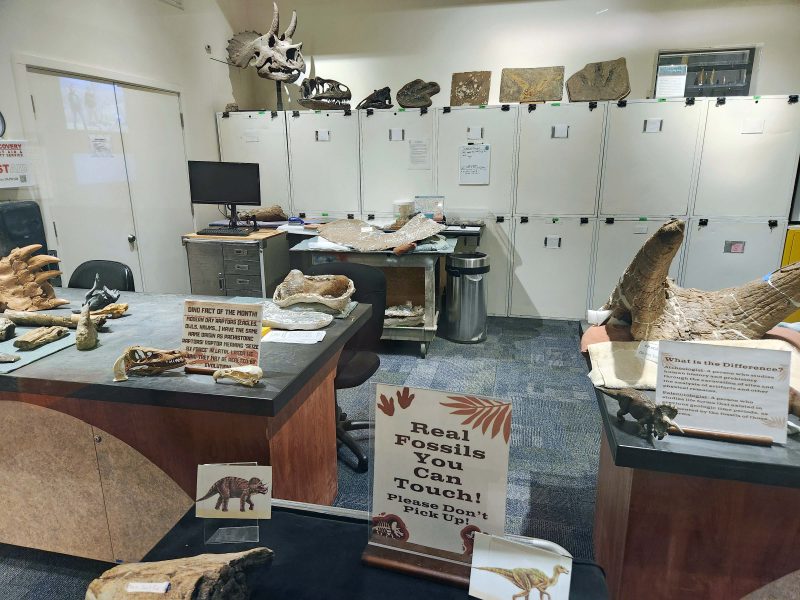
As we walked around the Science Center, we saw this chicken-and-egg riddle. The answer is at the bottom of this post, as calculated and agreed upon by eight of our family members the next afternoon.
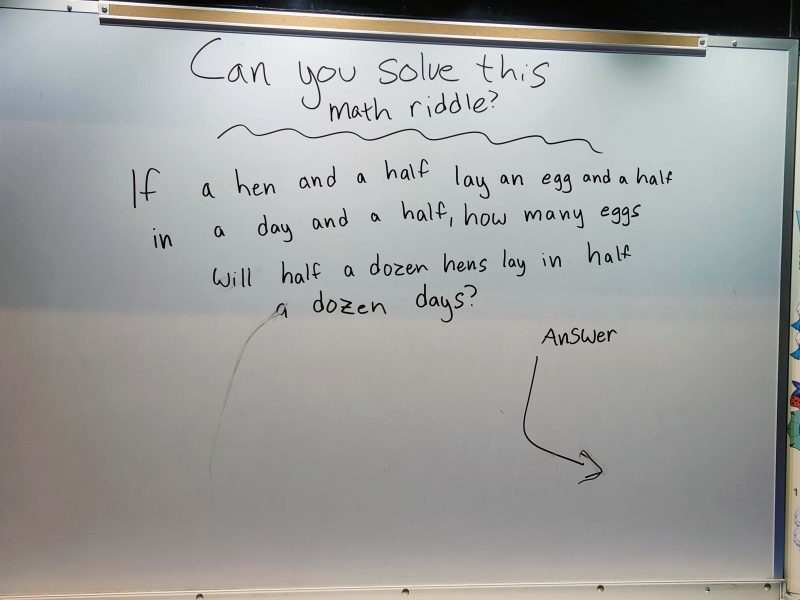
When we left the Science Center, we had just enough time for a quick stop at the Art Museum in Forest Park. At that point, our dry weather luck ran out. The heavy rain competed with our umbrellas and jackets while we walked from the car to the museum entrance. I think all of us were wet almost to our ankles from the puddles and spattered by rain to our knees.
We had some time to dry out on our way to dinner–authentic Italian food at Mama’s on the Hill in South St. Louis. It’s too bad this selfie is a little blurry, but you can tell we were all happy with our delicious meal and another great day together.

Riddle answer: 36 eggs–assuming the hens work around the clock and that each hen lays 3 eggs in 3 days–1.5 eggs/1.5 days.
Ted and I were excited when Kyra told us she’d finally saved enough money to come to our home for a visit–something we’ve all been looking forward to for quite a while. The event became even better when we heard that her BFF, Hannah, was coming too. The girls met each other when they were two years old and have been friends ever since. Ted and I have seen Hannah with Kyra so many times over the years that we think of her as another granddaughter.
Given the girls’ arrival time in St. Louis, and given the quality of airline food, we knew the girls would be hungry when they arrived, so our first stop was at Blueberry Hill for lunch.
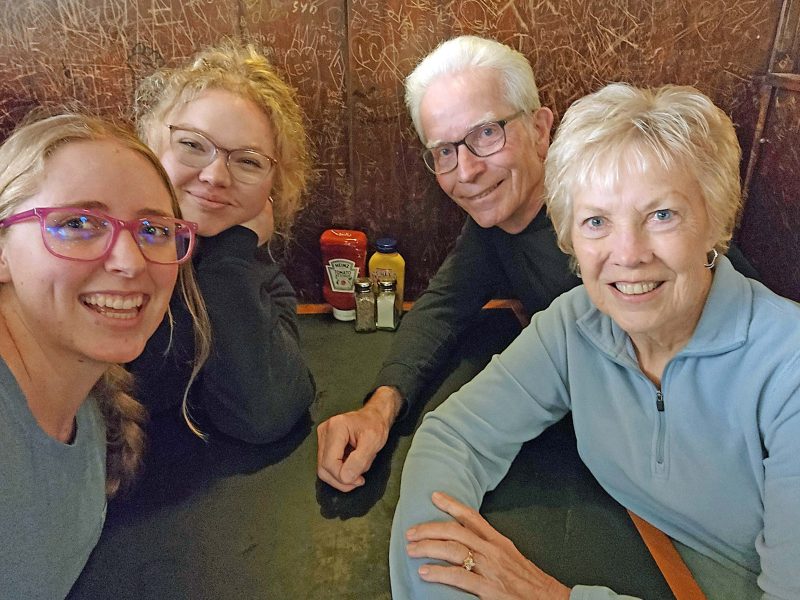
When Ted and I were at Blueberry Hill with the Bryans, we didn’t have time to look at all the displays in the restaurant. Today, we did.
Joe Edwards, the owner of Blueberry Hill, has his picture taken with every celebrity who visits or performs at his restaurant. The photos include four U. S. Presidents. The walls of the 10,000-square-foot building are covered with those photos and with Edwards’ collections. We saw photos of three Presidents: Bill Clinton, George W. Bush, and Barack Obama. On this wall, you can see Obama, Hillary and Bill Clinton, and Snap, Crackle, and Pop. It would have been fun to be there when the cereal trio showed up!

Edwards began collecting things when he was seven years old. He started with comic books, records (he has over 30,000 records in his collection and alternates them in the jukebox), and baseball cards. At 10, he started collecting toys, sheet music, and oak furniture. (Oak furniture?! At 10?!) At 12, he says, it was vintage lunch boxes; at 16, Wurlitzer juke boxes. Now he has collections of Star Wars, the Simpsons, Howdy Doody, Elvis, PacMan, Pez dispensers, etc., etc. and the largest collection of Chuck Berry artifacts and historic memorabilia on display in the world. The center boxes in this display are some of Edwards’ vintage Pez containers. (There were many, many more in other displays.)
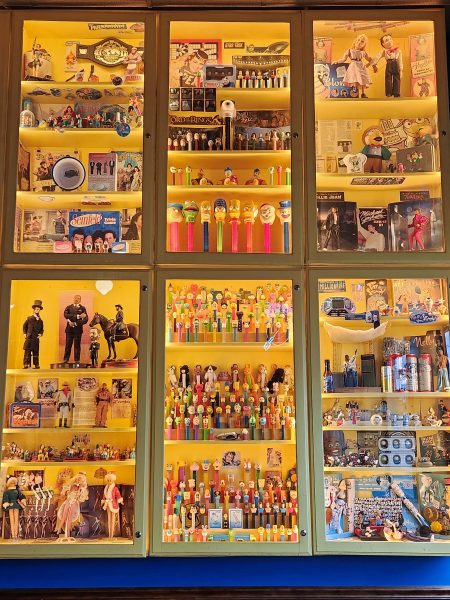
These are some of Edwards’ Howdy Doody memorabilia.
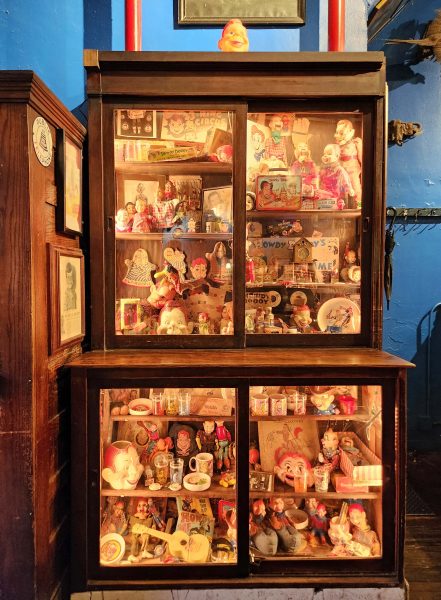
There are two live performance venues within the restaurant. One is the Elvis room. Although every wall in the restaurant is covered with displays or photos, there may be fewer individual celebrity photos than you think. Throughout the restaurant, we saw duplicate photos of a number of people, and the left wall below has the same arrangement of photos as the wall in the photo above, with Obama, the Clintons, and Snap, Crackle, and Pop in the same positions with the same adjacent photos. Oops!
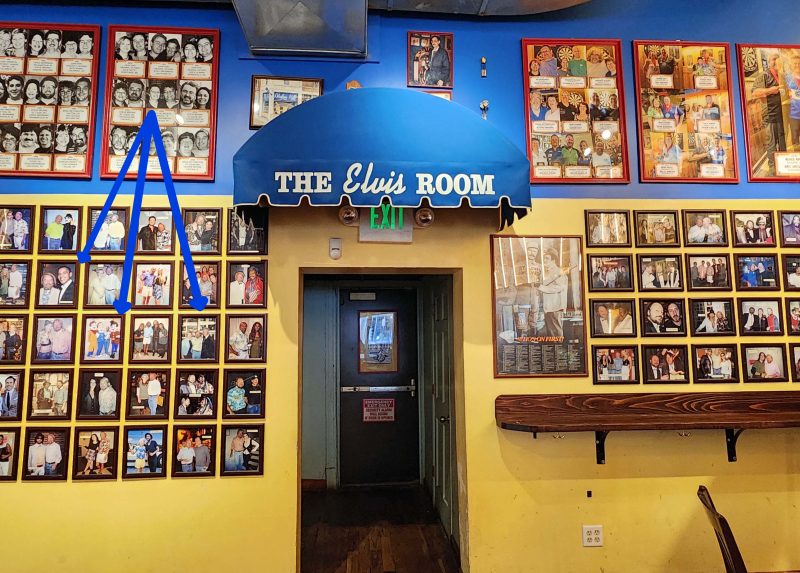
The Duck Room, named for Chuck Berry’s famous “duck walk,” is the other live performance venue at Blueberry Hill. Chuck Berry was the first pop music star to perform at Blueberry Hill, and he made 209 consecutive monthly appearances. Chuck’s home was in this area, and he has a star on the St. Louis Walk of Fame which passes in front of Blueberry Hill. Check out the chimeras near the ceiling on the right in this photo.

Remember this old video game? At Blueberry Hill, it’s a wall decoration.

I couldn’t tell if this giraffe lamp was carved out of oak and therefore qualified as oak furniture for Edwards’ collection; if not, maybe it was part of a “giraffe lamps” collection.
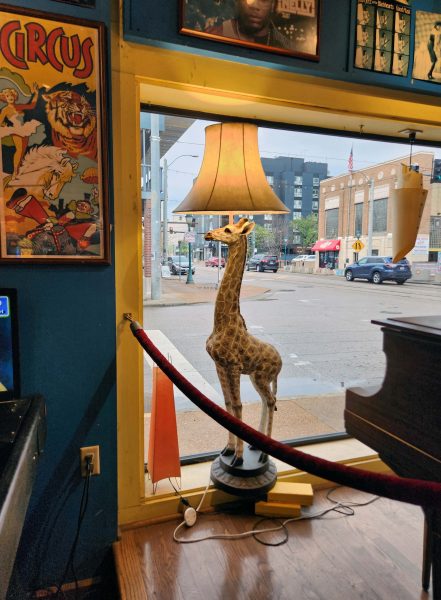
Kyra and Hannah sat on planes (two flights) for over three hours, plus a two-hour layover, and then in our car and at lunch. When we finished eating and looking at the restaurant displays, we were all ready to take a walk around the Delmar Loop, where Blueberry Hill is located. As we walked, we saw some outdoor murals. If you look closely at this photo, you can see that the gray blocks on the sidewalk have St. Louis Walk of Fame stars on them.
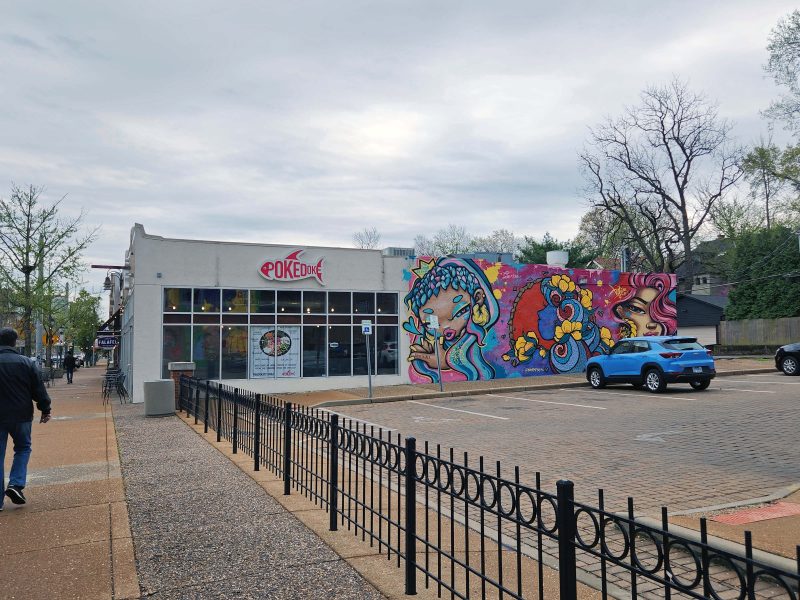
I especially like the Maya Angelou quotes in this mural. The quotation with the yellow background on the left is from Angelou’s book, I Know Why the Caged Bird Sings. It says, “A bird doesn’t sing because it has an answer. It sings because it has a song.” The quotation on the right says, “If you are always trying to be normal, you will never know how amazing you are.”

Kyra and Hannah needed to wake up very early to be at the airport for their flight(s) to St. Louis. Then they had hours of travel followed by a lengthy lunch and a restaurant tour so, after our walk, we went home where they could unpack and chill out before we had dinner together. You can tell by the outdoor photos that it was a gloomy day, but not for us. For us, being together made it as much fun as a sunny day!
Today, after Jeff and La returned from church, the four of us had a lengthy and interesting discussion related to solving several national and world problems. Jeff has a unique idea for getting rid of daylight saving time (in which no daylight is actually saved) as well as standard time. Ask him about it.
When we felt the world was in order, we had lunch and headed for Salvation Mountain.
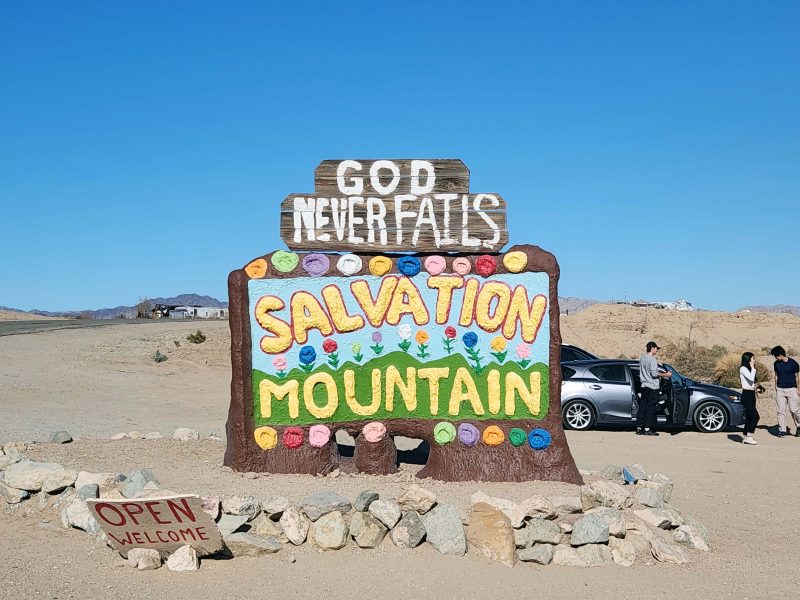
According to the handy brochure, Leonard Knight began creating Salvation Mountain in 1989 in Niland, CA, near Slab City. His building materials included adobe clay, straw, tree limbs, tires, windows, and lots of colorful paint. All of these items were found lying in the desert or at the local dump. Leonard’s plan was to paint the mountain twice a year, hoping the thick layer of paint would keep the site in good condition so that many people could see it for many years. (That explains the plethora of paint cans around the displays.) Perhaps not surprisingly, Leonard’s first mountain collapsed. As he began rebuilding it, he proclaimed, “No, God, You build it.” Today, we saw the result.
In 1994, Imperial County attempted to have the mountain torn down, but members of the art community all over the United States and around the world united to save the monument. In 2001, Salvation Mountain was designated a National Folk Art Site; in 2002, it was named a National Treasure in the Congressional Record; and, in 2007, it was featured in the film Into the Wild. Leonard believed people need to start loving God more. He often said, “Love is universal. Love God, love one another, and just keep it simple!”
Salvation Mountain is a colorful sight in its brown desert surroundings. Notice the waterfalls, the rivers, and the Sea of Galilee.
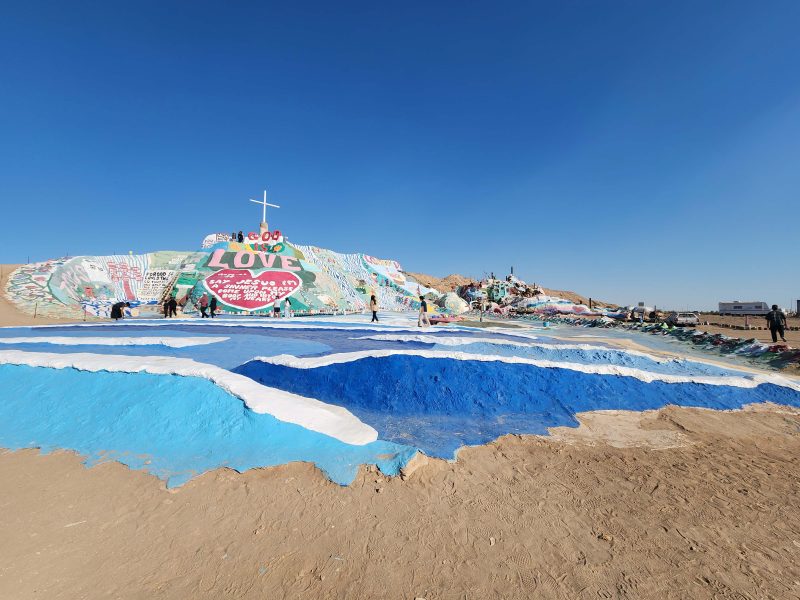
I don’t know how much mail God gets, but here’s a mailbox for it. The lumpy multi-colored blob on the right is the museum.

This is a close-up of the museum entrance. It’s closed because there is a danger that the top is going to cave in. The arrow in the photo points to one of many cracks in the dirt structure. If you look, you’ll see several more cracks. There are plans to repair the museum and to re-open it, but Salvation Mountain is dependent on donations and volunteers and cannot be repaired at this time. A public charity, Salvation Mountain, Inc., was established to continue maintenance on the site. No government aid is accepted.
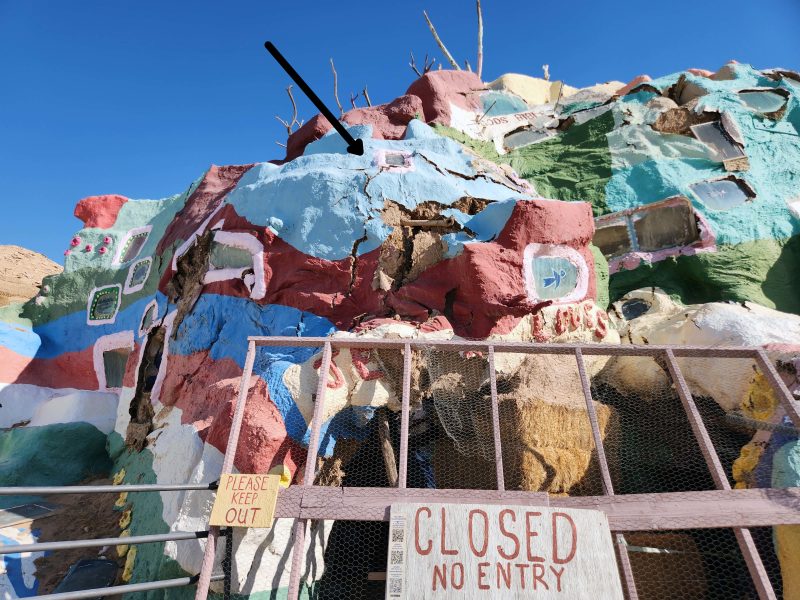
You can “follow the yellow brick road” to the top of the mountain. Jeff and La went all the way to the top via this route.

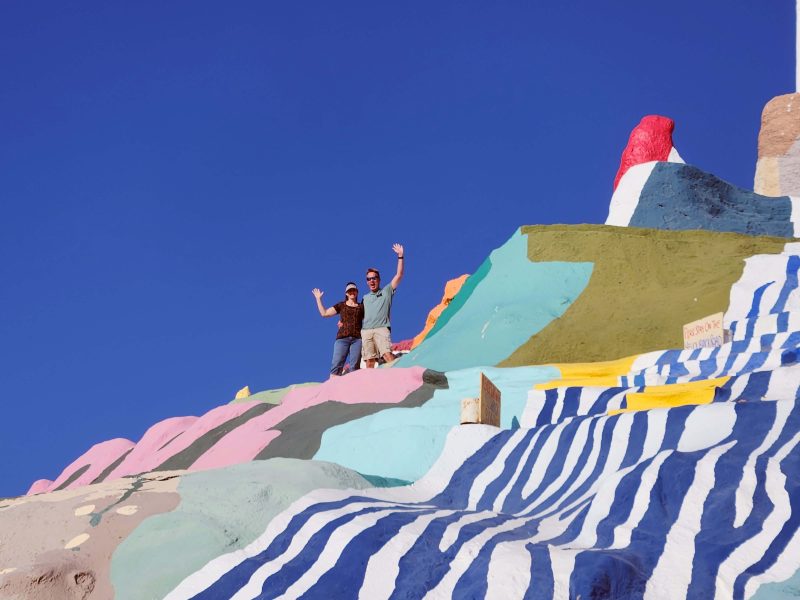
I made it across the first river before the edge of the yellow brick road came too close to the edge of the mountain for my comfort. I wasn’t in a Jack and Jill tumbling mood, so I chickened out and backtracked. I don’t like to be at the edge of high places unless there’s a large, firm platform under my feet with a protective railing around me. Luckily, on the other side of the mountain, there was a more gently ascending dirt trail to the top. Ted accompanied me to the top via that less scary route.
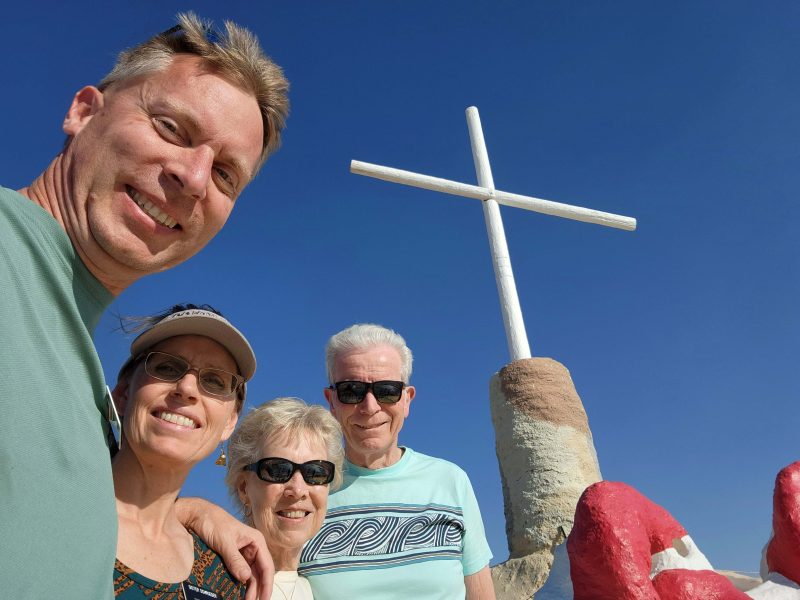
The Salton Sea was visible from the top of the mountain. It’s the flat, narrow light blue streak running across the upper center of this picture. The Salton Sea is a shallow, land-locked, highly saline lake that lies on the San Andreas Fault. In the 20th century, it was a resort destination, but contamination from fertilizers and clouds of toxic dust, plus evaporation, caused die-offs of fish and birds in the 1980s.
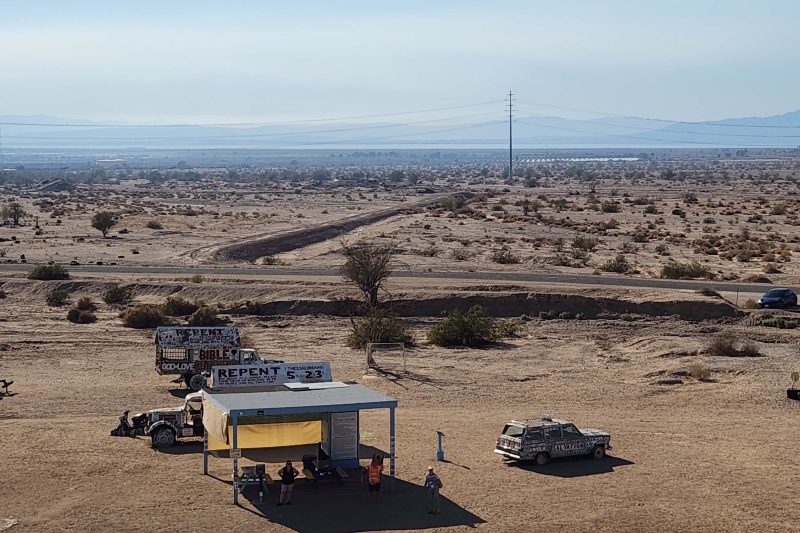
There are a number of vehicles–cars, trucks, farm machinery, a boat, etc.–on the grounds. All of them (except the boat) have flattened tires and all of them are colorfully painted with scriptural messages.
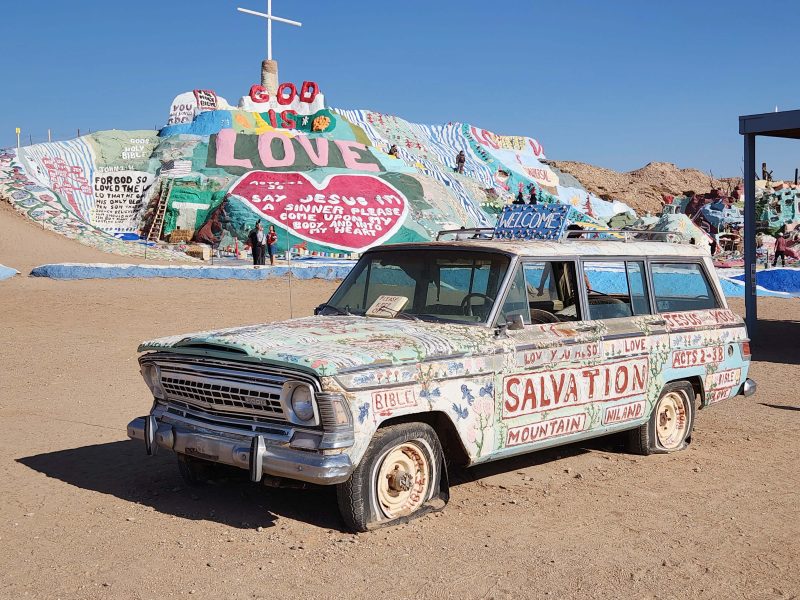

This is a view of Slab City, a community adjacent to and north of Salvation Mountain. Slab City took its name from the concrete slabs that remained after the World War II Marine Corps Camp Dunlap training camp was torn down. The community is known for attracting people who want to live outside of the mainstream society (i.e., off the grid).

The trailers and campers behind Leonard’s “flower garden” in this picture might be a southern suburb of Slab City. Some of the volunteers who maintain Salvation Mountain live here.
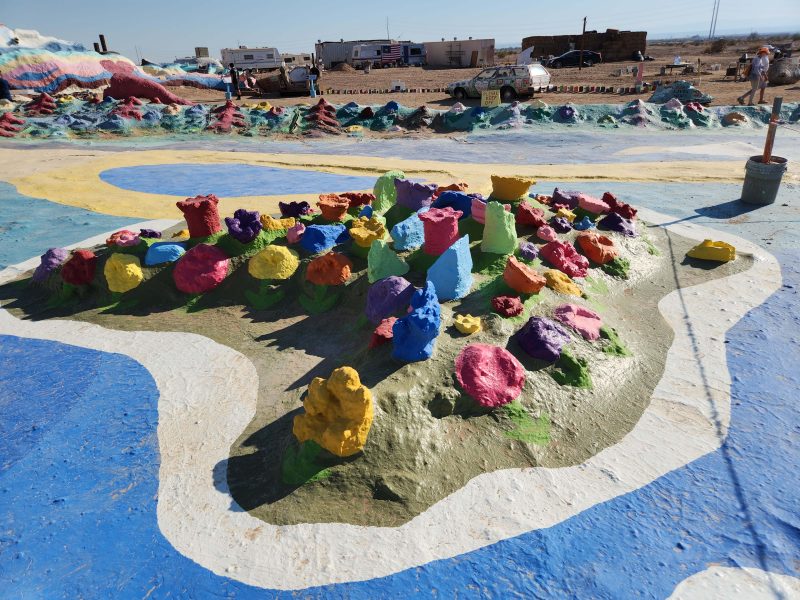
On our way back to El Centro, we stopped in Calipatria, a “low-down” town. At 184 feet below sea level, it is the lowest incorporated town in the Western Hemisphere. (Badwater Basin in Death Valley National Park is lower at -282 feet, but no one lives there.) The local joke in Calipatria is that its residents have to pray harder because they are closer to hell.
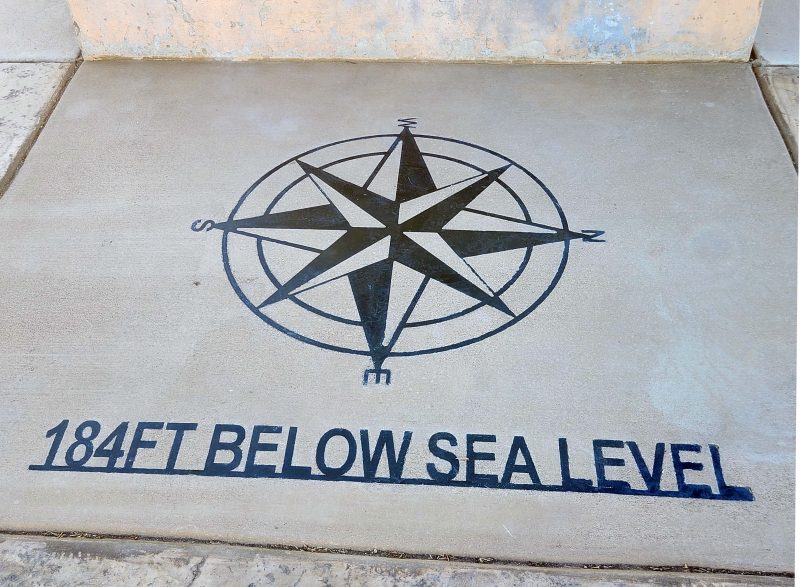
Calipatria’s claim to fame is its freestanding flagpole, at one time, the World’s Tallest Flagpole. At 184 feet tall, its flag flies at sea level. It can be seen from as far as three miles away and, as the sign says, it’s “Dedicated to good neighborliness”–a kind and friendly ideal.
Note: Calipatria’s flagpole is no longer the tallest flagpole in the world. Currently, the world’s tallest flagpole is 662.57-ft. tall and was built in Cairo in 2021. The 400-ft. tall Acuity Insurance Flagpole in Sheboygan, WI is now the tallest flagpole in North America. It is also one of the world’s tallest free-standing flagpoles.

Calipatria’s flagpole has an interesting backstory. The flagpole was built to honor Takeo Harry Momita and his wife, Shizuko Helen Momita. The Momitas were a Japanese-American couple who lived in Calipatria. They and their three children had been incarcerated at the Poston War Relocation Center in western Arizona during World War II under Executive Order 9066 signed by President Franklin D. Roosevelt. The order imprisoned 120,000 people of Japanese descent–two-thirds of whom were American citizens.
When Mrs. Momita was killed in a car accident and Mr. Momita was hospitalized for injuries he sustained in the accident, Calipatria residents operated his pharmacy for him and collected $500 for Mrs. Momita’s funeral. Mr. Momita said his wife would not want an elaborate funeral. Instead, he offered to donate an additional $500 of his own savings toward something the city wanted but could not afford: a flagpole reaching up to sea level.
The story made national news and donations poured in. President Richard Nixon sent a flag that had flown over the U.S. Capitol, and Pacific Southwest Pipe Co. of Los Angeles offered to erect the flagpole at cost (about $10,000).

What a nice way to end our visit with Jeff and La. In the past five days, they took us to all the interesting places I’ve been writing about and they were outstanding tour guides. We had lots of good times together, good food wherever we ate, good family time, and loving hospitality. It was great to spend this time with them.
It was exciting to arrive in El Centro and to see where Jeff and La are living for a year. The temperatures in San Diego were in the upper 60s and low 70s, but in El Centro–located in the Colorado Desert (part of the Sonoran Desert) in the Imperial Valley, and 42 feet below sea level–the temperatures were in the 80s. I loved it! The Imperial Valley is very flat because it used to be an inland sea. I guess that explains why the area is now below sea level. 🙂
We spent the morning playing games. Jeff and La introduced Ted and me to “Cover Your A$$ets,” which was a fun game. We plan to buy it for ourselves after we get home. We went out for a late lunch at one of Jeff and La’s favorite local restaurants, Burgers & Beer. It was a hopping place, even after the usual lunch hour. Our server was very nice, and the food was delicious. Fortified by our burgers and fries, we headed for Pioneers’ Museum, about an hour’s drive away.
An important factor in the permanent settlement of the Imperial Valley was the building of one of the most impressive irrigation systems anywhere in the world. This made the area one of the most productive farming regions in California, with an annual crop production of over $1 billion. Pioneers’ Museum celebrates the many ethnic communities that settled in this area and made it the community it is today.
We arrived at the museum only an hour before closing, so the ticket master (the only person on duty) allowed Jeff and La to enter for half-price, which was the same as the senior discount for Ted and me. It’s an interesting museum. We each went our own way to look at the things that interested us in the one hour remaining before we had to leave.
This is a player piano. You can see the music scrolls above the pedals. Wouldn’t it be nice to have decorated pianos like these today? (I’m not sure, but the second picture might be a spinet harpsicord with horizontal strings.)
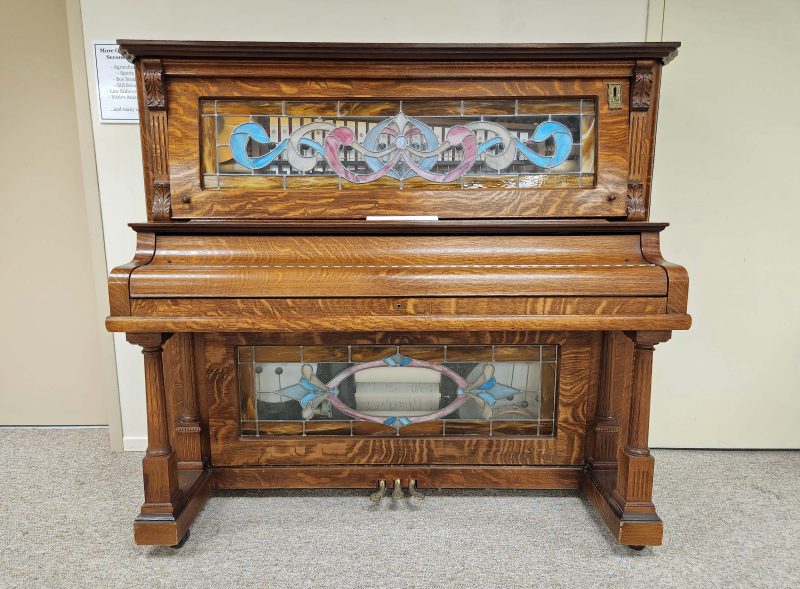
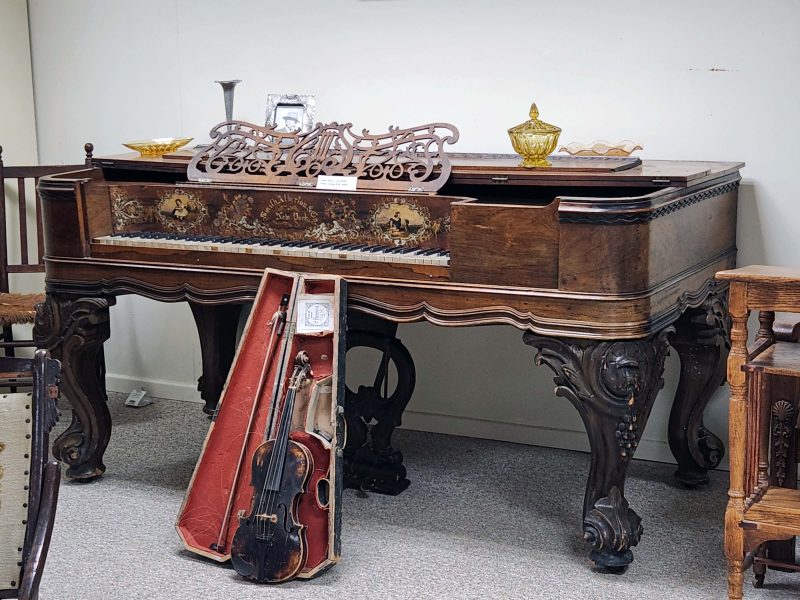
This car was part of a display about the people who came to the Imperial Valley during the Dust Bowl years. The yellow object on the right is a gas pump from the 1930s.
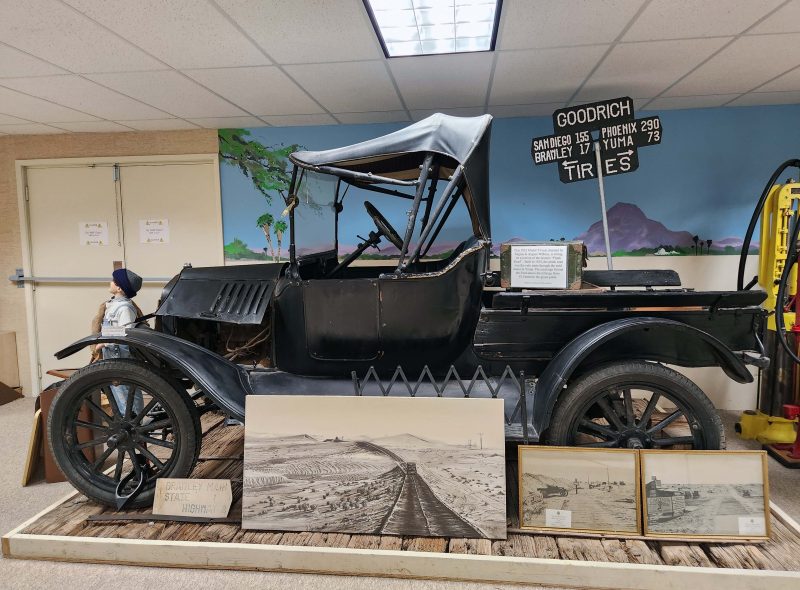
Here is a beautiful piece of tapestry. I think I’d enjoy making something like this, although I’d choose a different design.

Compare this to the cash registers we see in stores today. Which to choose: cash register beauty or computer speed?
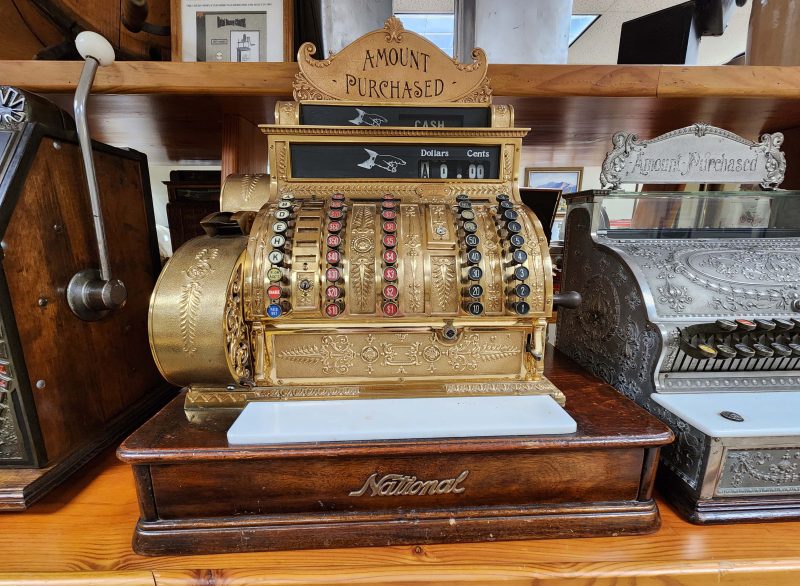
There were two cabinets filled with hatpins. This is one group of them in one of the cabinets. Women in the late 1800s and early 1900s carried hatpins for protection against men who harassed them. (That might still work, judging by these hatpins.) Using hatpins as weapons led some cities to pass laws limiting the length of hatpins. You probably can’t get any of these past security at the airport today.

When I entered the second floor of the museum, this cabinet was directly ahead of me. My first thought was, “I’ll bet it’s a sewing machine cabinet.”
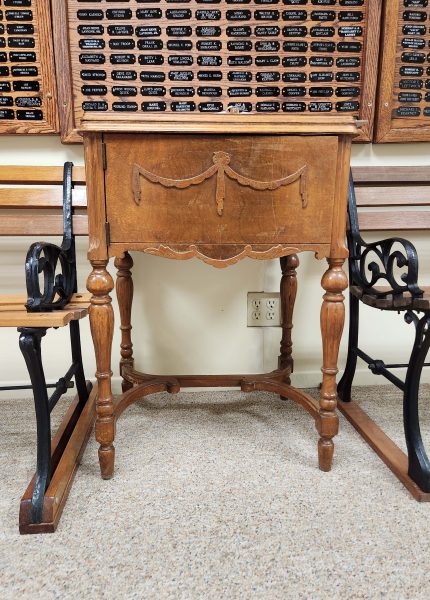
I carefully opened the top and there it was–the drop-down sewing machine hidden in the cabinet when it’s not in use.
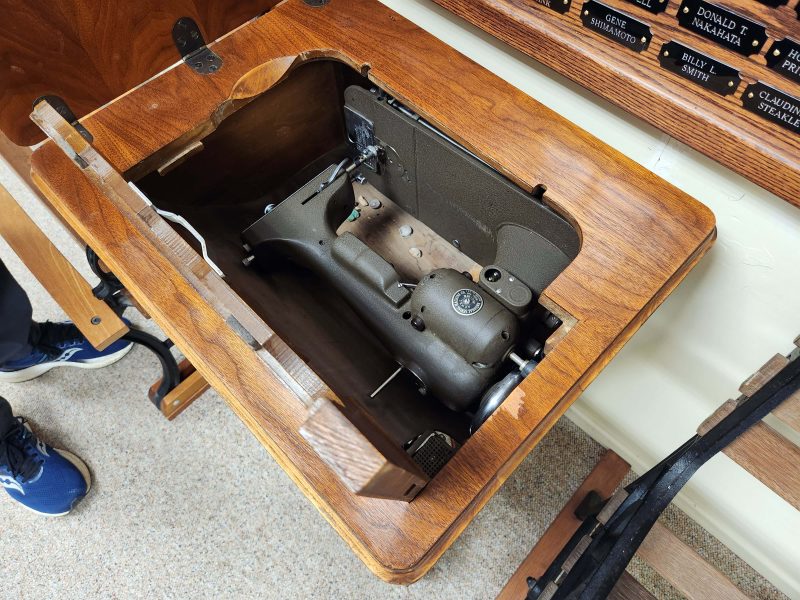
The first sewing machine I bought had a drop-down cabinet. I had the cabinet retrofitted for my new sewing machine, but the new model is too large to fit the cabinet if it’s dropped. I store the sewing machine in a closet and set it into the cabinet when I use it.
This antique sewing machine is like the one my mother had when I was a young child. Mom started teaching me to sew when I was nine years old. (I made a sleeveless yellow blouse). She must have replaced her treadle machine before that because I only remember sewing on her electric Singer sewing machine (exactly like the one I bought as shown in the link above), never on her treadle machine. Note the photographer, trying to get the perfect shot.
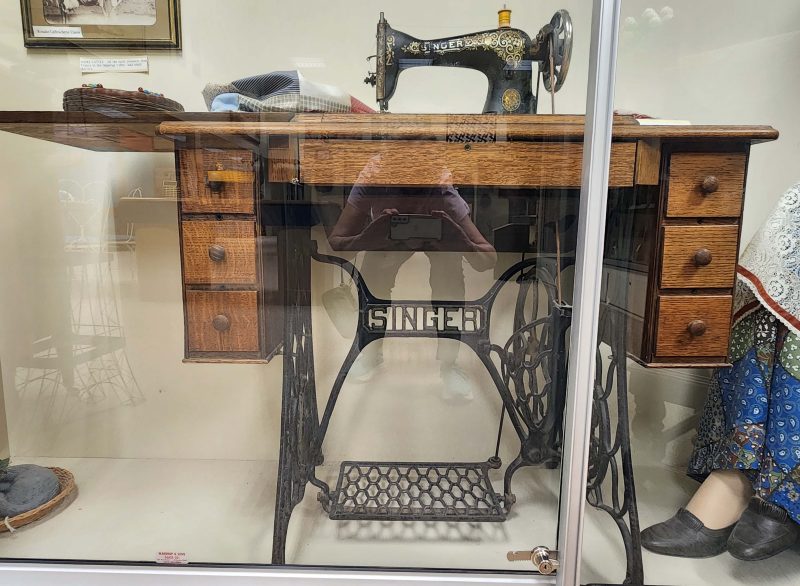
Holtville, CA, in the Imperial Valley, is known as the “Carrot Capital of the World” because of its annual Carrot Festival and its large carrot harvests. The multi-day festival is held in late January or early February and includes a parade, a carnival, cook-offs (of carrot-based foods, I assume), and other activities. Also included in the festival is the crowning of the Carrot Queen, the Princess, and the Junior Princess, as well as the crowning of the Citizen of the Year. Here are an historic photo of a carrot harvest and photos of festival memorabilia.

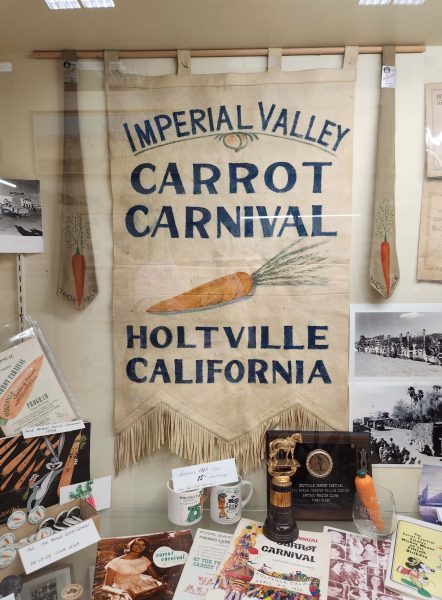


As we were driving home from the museum, we passed an open semi trailer truck nearly overflowing with a load of carrots. Really.
Another display that interested me was the picture brides. Most of the picture brides were Japanese, Okinawan, and Korean. Their pictures were paired with husbands selected by a matchmaker, similar to the concept of mail-order brides. Picture brides were often poor and hoped that marriage would provide economic prosperity for them, allowing them to send money back home to their families. It was not unusual for picture brides to be educated at the high school or college level, and thus more emboldened to seek out new opportunities abroad. By 1920, over 10,000 picture brides had arrived in the United States, and over 15,000 arrived in the then-territory of Hawai’i.

This photo shows a picture bride with her husband.
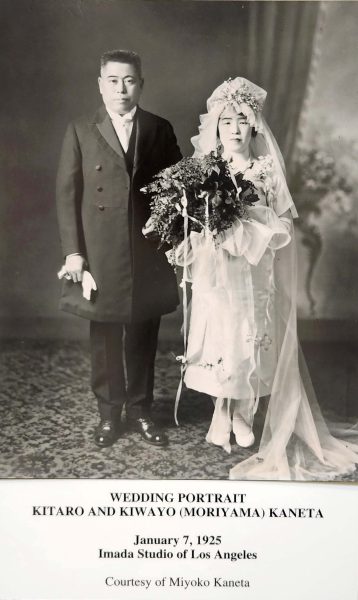
You can read the story about another couple below. They exchanged pictures of themselves with each other (corner pictures), and when the match was deemed satisfactory, they were married by proxy. The woman said that, at first, she was disappointed when she met her husband because he was much older than he looked in his picture. They settled in the Imperial Valley and were married for 50 years until the man died in 1964.

Coming around a corner in the museum and seeing a Holstein cow caught me by surprise. Even more surprising (and kind of funny) was the accompanying tribute to “The Cow” (below).


Before we left the museum, Jeff found himself in the Holtville Jail. He managed to escape and drove us home, where we took a late afternoon walk around the neighborhood.
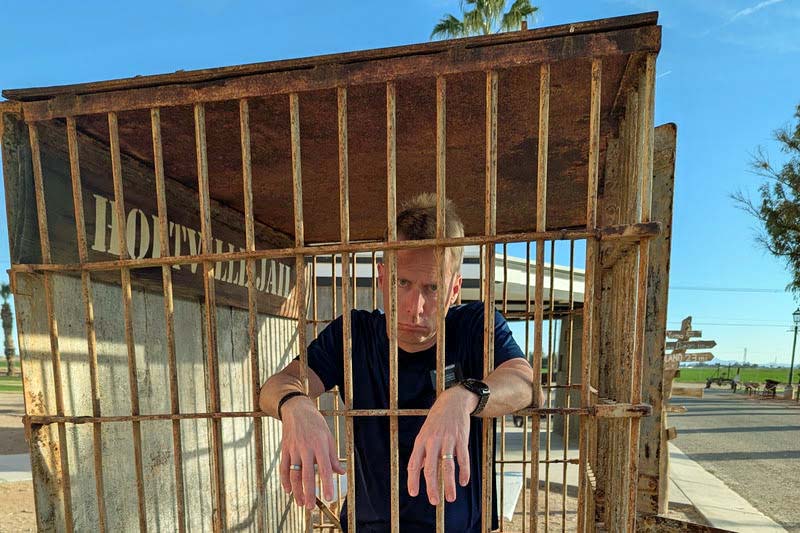
Our last sightseeing stop today was the Desert View Tower on our way to Jeff and La’s apartment in El Centro. Jeff and La notice the tower when they drive back and forth to San Diego, and they’ve been curious about it.
The 70-foot tall tower was built in the 1920s and was dedicated to the pioneers and to the highway and railroad builders who opened up this area. At first, it served as a roadside advertisement for a restaurant and bar located on the old road across from the tower. It currently houses a museum, has a hurricane (aka observation) deck on its upper level, and is listed on the National Register of Historic Places.
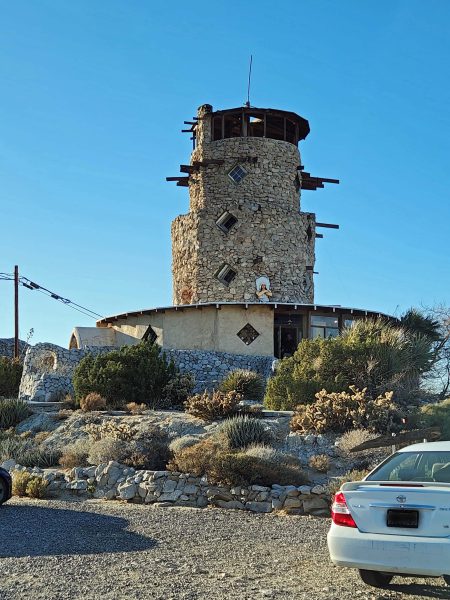
The museum is described online as a “collection of unique trinkets that you can purchase.” That’s exactly what we saw on the first floor. There were two older men sitting inside the tower on the first floor. They were very talkative as we walked around the circular room looking at the trinkets. None of the trinkets appealed to any of us and neither did the $6.50 per person admission fee to climb to the hurricane deck, so we walked around outside a little bit. There was, indeed, a desert view.

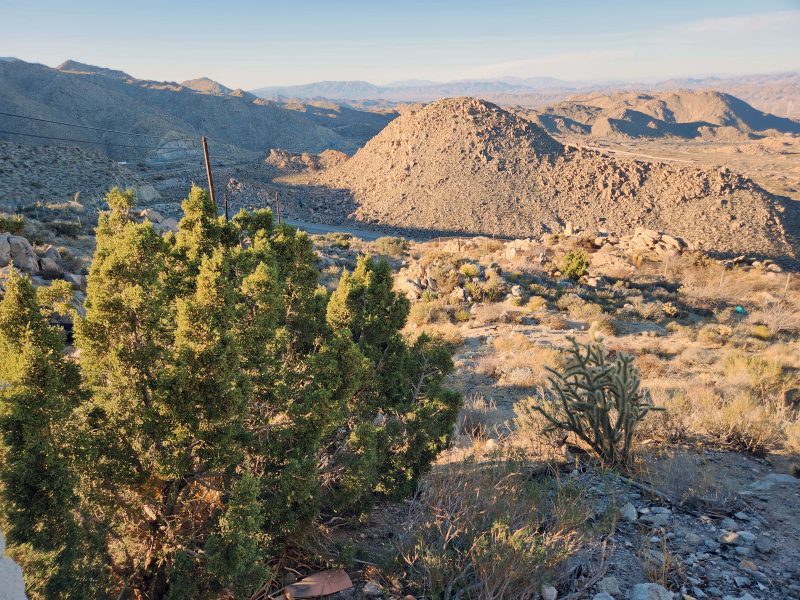
The cacti around the building were pretty in the late afternoon sunshine.
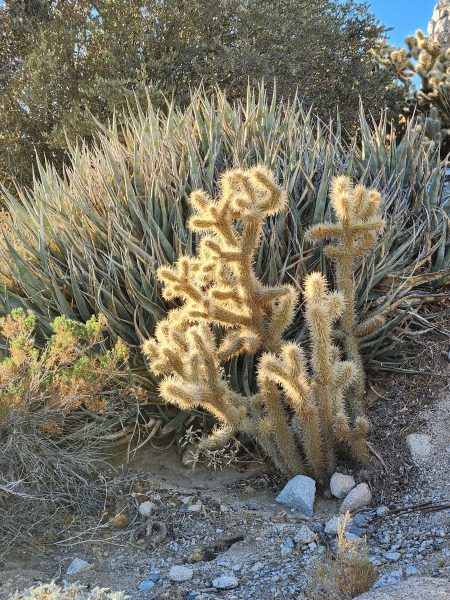

Are these desert wind chimes?

Here we are, ready to leave the historic Desert View Tower to go to Jeff and La’s house where we made individual mini pizzas for dinner. It was another day of fun together.

Jeff and La have tried several times to stop at La Jolla (pronounced “la hoya”) Beach to see the sea lions, but have been unsuccessful. The problem is parking. Only street parking is available within a reasonable walking distance, and lots of people want to see the sea lions. As a result, Jeff and La have never found a parking place and have gone home disappointed. Until today. Maybe Ted and I were good luck charms because we found a parking spot very close to the beach and here we are, happily spending time at La Jolla Beach with the sea lions.
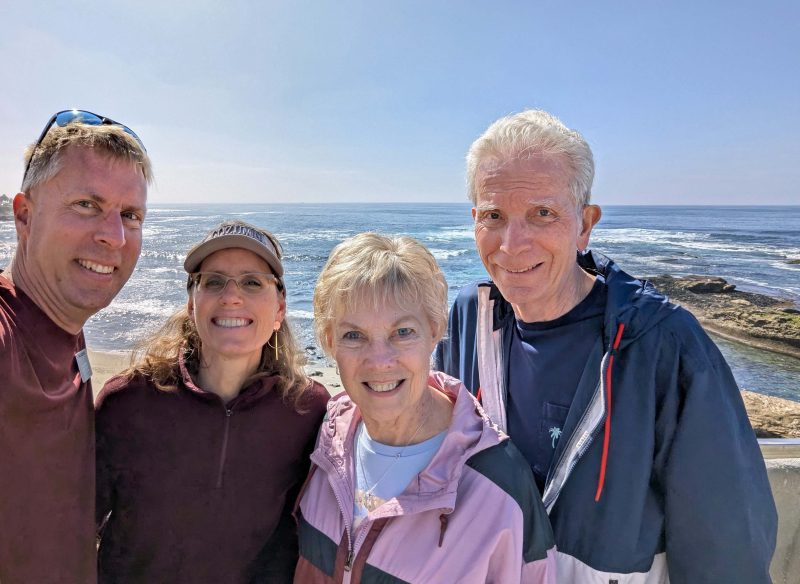
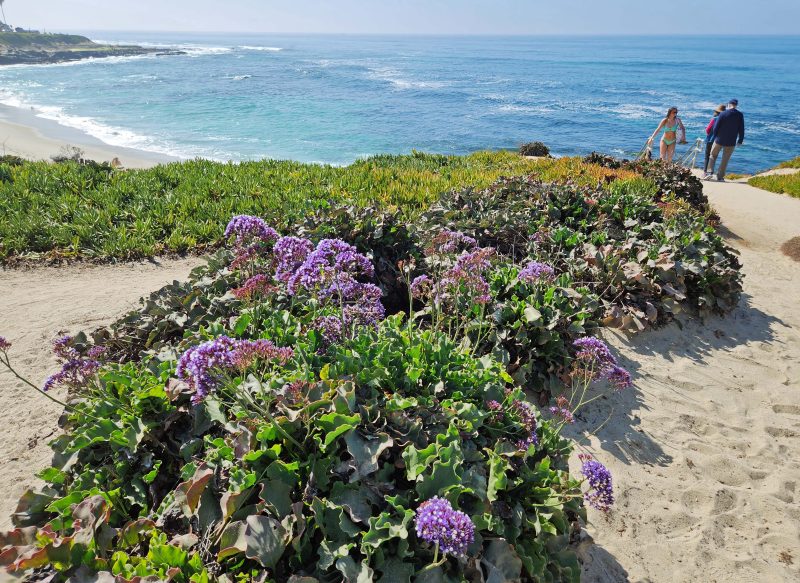
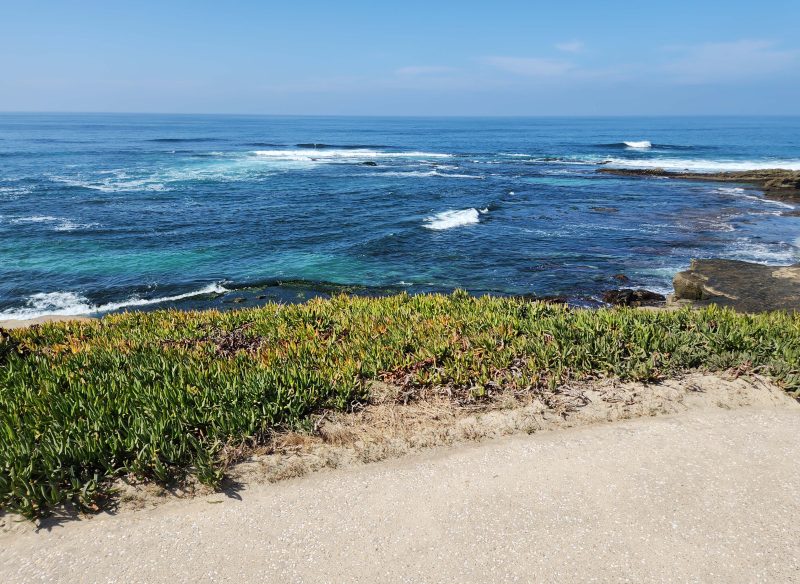
That’s Jeff standing at the sidewalk railing. It’s pupping season for the sea lions, so humans are not allowed on the actual beach at this time.

That lumpy dark line along the shore is a gathering of sea lions. When you watch the video, look at the right one-fourth of those sea lions. You’ll see a mama sea lion waddling out of the water with her pup behind her, then heading back into the water to follow her pup who wanted to play some more before sunbathing.
These sea lions have picked a prime spot for sunbathing. During the time we were here, you could see that the tide was going out because the rock in the photo below emerged from the water. As the water level dropped, more sea lions headed for this rock, but these had the best (i.e., highest, driest) spots for lying in the sun.

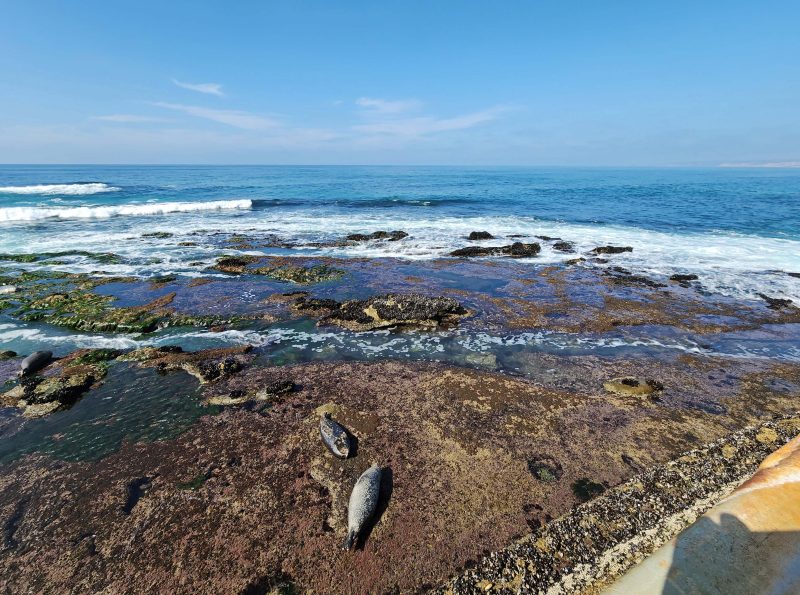
All those black things on this piece of rock are barnacles. The arrow points to a tern. He was pecking at and eating the barnacles.

It was interesting to see so many sea lions and pups go in and out of the water and roll around on the rocks, so we stayed to watch them for quite a while. Then it was lunchtime. Jeff and La pulled out their cell phones to search for a nearby restaurant. It looks like I’m hoping and praying that they find somewhere to eat soon.
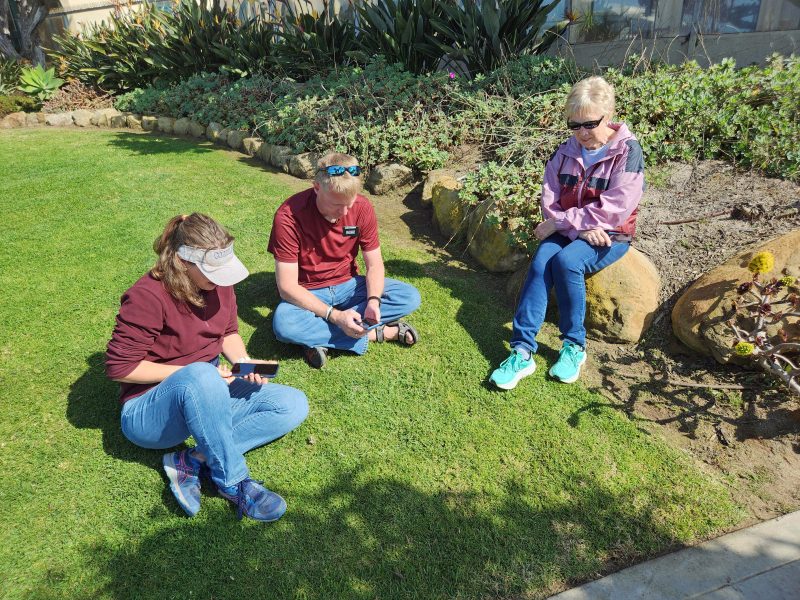
When I realized Ted was taking a picture of us, I looked up and smiled.
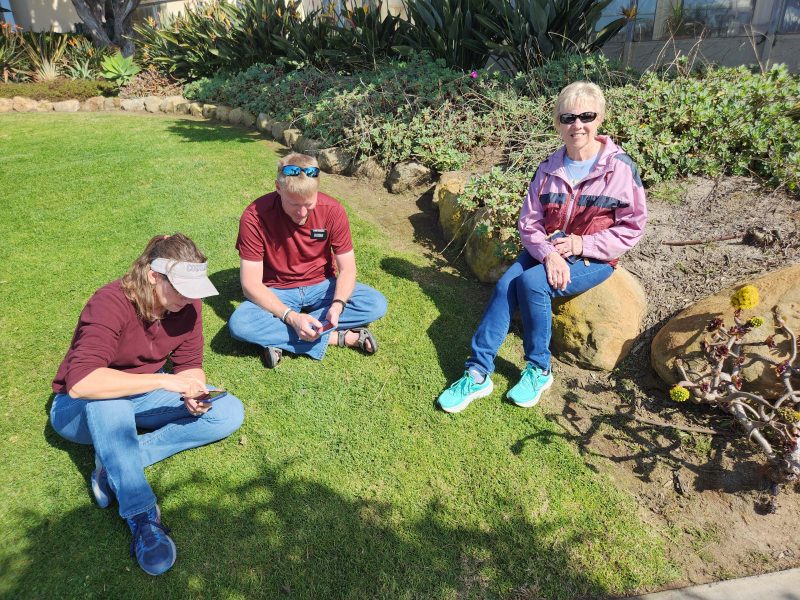
My prayers (?) were answered. We headed for one of Jeff’s favorite sandwich places and a new restaurant for Ted and me: outdoor dining at Cheba Hut. I told Jeff I prefer warm sandwiches, and he assured me that Cheba Hut toasts their sandwiches. It was the first time I’d ever had a warm PBJ. Yes, even the PB and J were warm! Good food for good times!
Before leaving our San Diego hotel this morning, Jeff posed with the restaurant’s giant waffle.
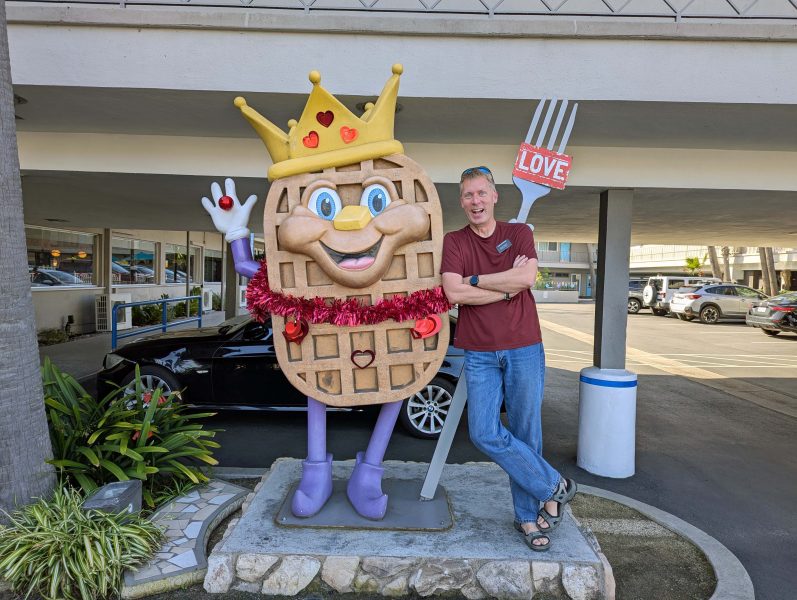
Our first sightseeing destination today was Annie’s Canyon Trail, which includes a loop through a slot canyon. The trail has a sign warning hikers that some of the trail is very steep. As we set off to explore the canyon, we hoped the steep part was the steps at the highest point of the trail. The photos below might look as if we’re deciding which way to go, but there was only one way through the canyon. We were just looking around and taking some pictures before moving forward again.
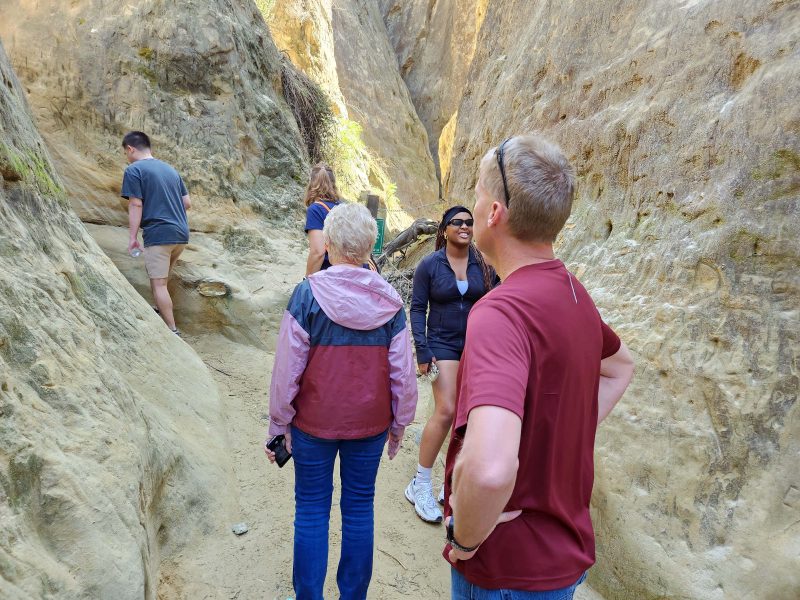


Ah, now we’re getting to the “slot” part of the slot canyon.
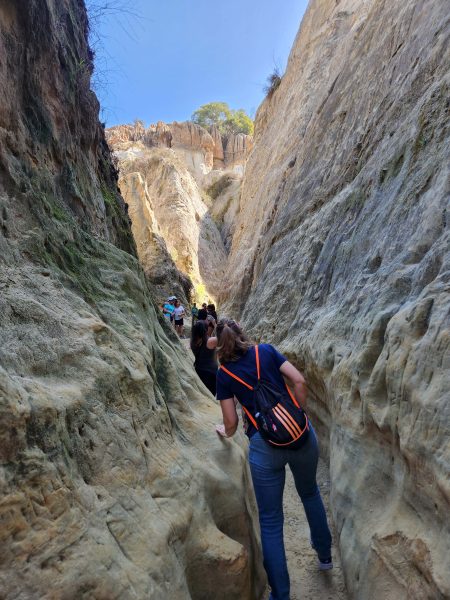
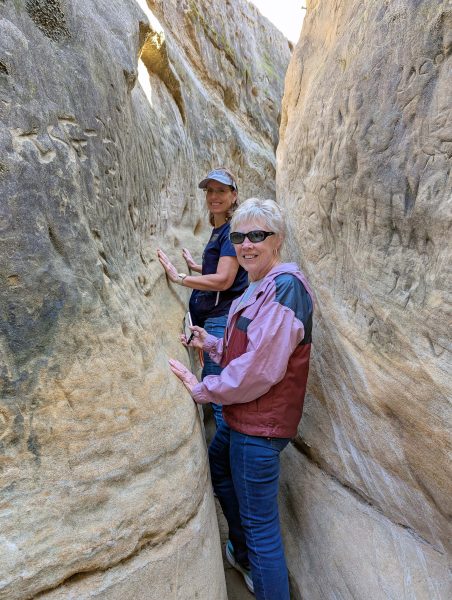
Unfortunately, my injured ankle is not yet completely healed. Walking on the uneven rock on an increasingly steep upward slope was making my weakened ankle hurt. I was having fun and wanted to see the rest of the canyon and the view from the top, but as the pain became worse and the trail became steeper, I decided I’d rather turn around than aggravate my ankle and miss out on the fun for the rest of the day and maybe even the next day because of continued ankle pain.
Turning around might be the smart thing to do for me and for those who discover that the slots are too claustrophobic for them, but it isn’t easy. As you can see in the photos, much of the trail is only one person wide and is essentially a “no passing” zone. That meant that, as I went down, other people needed to find a wide space, plaster themselves against the canyon walls, and wait for me wriggle past them on my way downward before they could continue upward. I was grateful that they were all very nice about it. I apologized for their inconvenience and got lots of “No problem” and “Don’t worry about it” responses, accompanied by smiles. Ted and Jeff both chose to go back down with me, although I was fine with the idea of going by myself while they enjoyed the rest of the hike. That left La to complete the loop trail by herself and then tell us about it later.

At the end of the loop, the trail continues along a marshy area. We saw this pretty flowering tree.

As we were admiring the view from the trail, we noticed an osprey sitting on a dead tree branch. One of the other people looking at the osprey noticed that he’d caught a fish. It’s the silver strip under his feet on the branch. A man in the crowd mentioned that where there’s one osprey, there are always two and, sure enough, his mate came back, circled, and cawed back and forth with him a bit before she flew away. I think she was telling him she could do without the crowd of people watching and would be back later after we’d all gone away.

The fish wriggled under the osprey’s feet for a few minutes. When it was still, the osprey enjoyed his lunch. It was kind of sad to watch the fish die and then be eaten, but that’s how all animals survive, right?
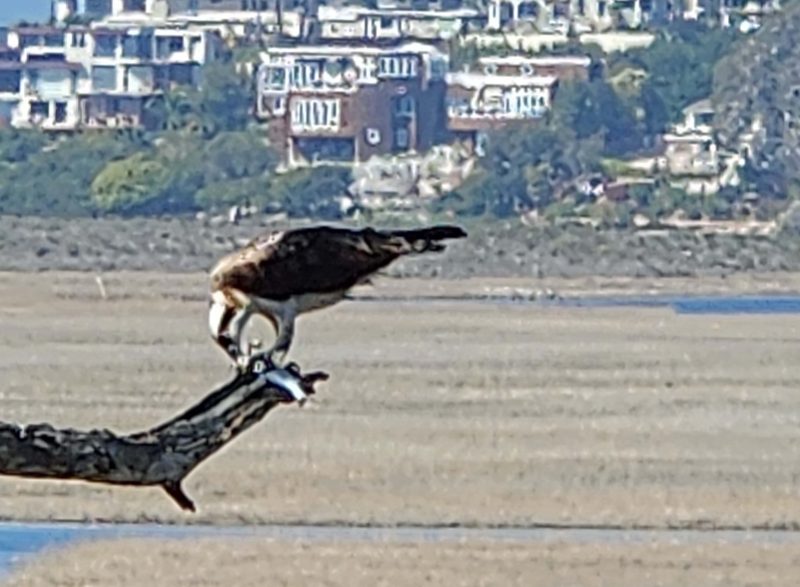
After a pretty hike with a survival-of-the-fittest ending, we headed for a happier experience with nature. Coming up: La Jolla Cove.
Our last tour stop of the day included a beautiful drive over the Coronado Bridge to Coronado Island, with a pretty offshore view of San Diego. Coronado Island is the home of the historic four-star Coronado Hotel, a rare surviving example of an American architectural genre: the wooden Victorian beach resort. It is the second-largest wooden structure in the United States. (FYI: The largest is Tillamook Air Museum in Tillamook, OR.) The Coronado Hotel was designated a California Historical Landmark in 1970 and a National Historic Landmark in 1977. The 1959 movie Some Like It Hot–starring Marilyn Monroe, Tony Curtis, and Jack Lemmon–was filmed here, highlighting the hotel.
In case you’re wondering, in summer, the lowest room rates begin at $500. In addition, there is a $50 resort fee, a $15 per day Historic Preservation Fund fee, and a $75 per day valet parking fee if you arrived in your private car. Rates drop as low as $350 for rooms in the off-season. Question: Which part of the year is the off-season in sunny, warm San Diego?

These colorful surfboards stood outside the hotel. I hope those hotel fees allow you to use a hotel surfboard without an additional charge.
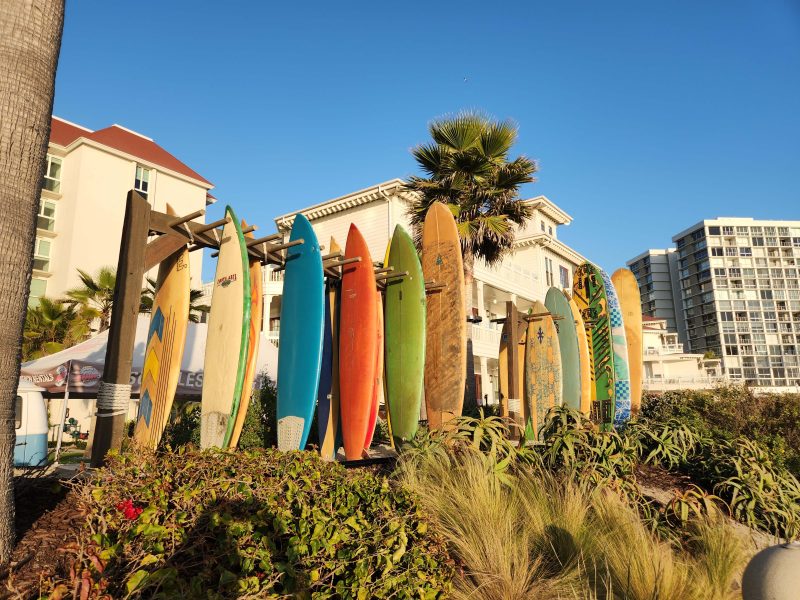
There was a (sand-covered) sidewalk along (guess what?!) Coronado Beach, so we followed it for a short way and passed this lifeguard station.
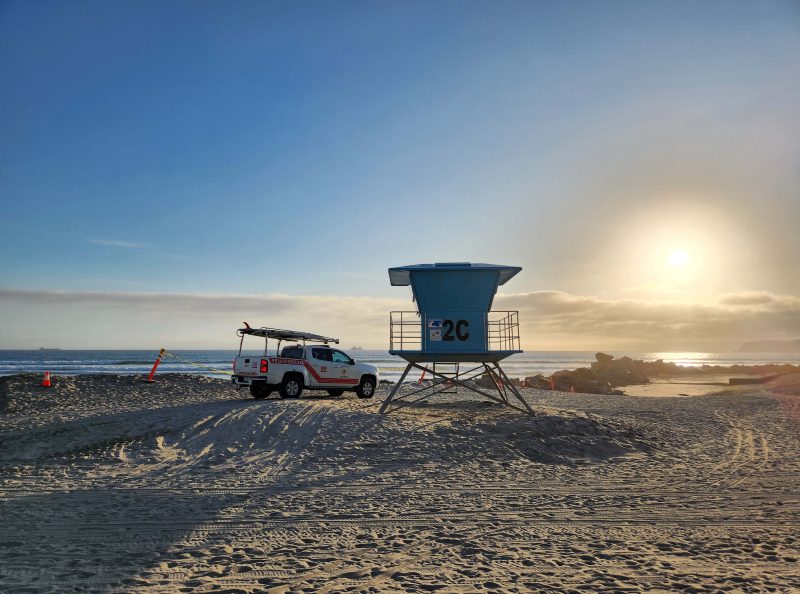
It was late in the afternoon, and the sun was shining over the ocean.
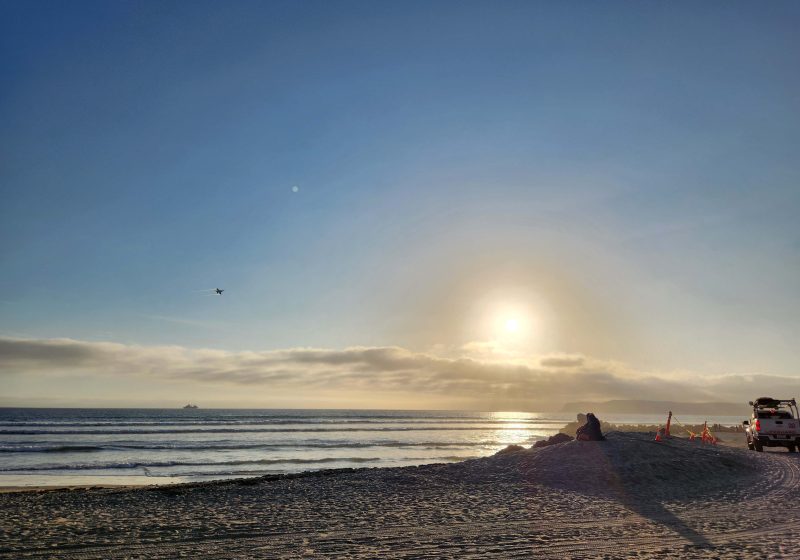
I’m guessing that a motorcyclist had fun doing a wheelie here on the beach.

On our way back to the car, I noticed this beachcomber. I hope he found a little treasure to brighten his day.
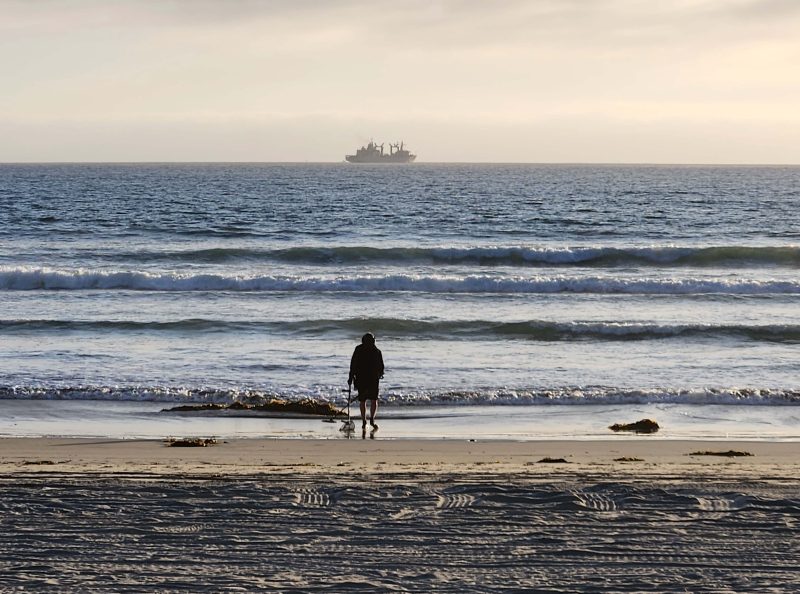
We ended our day with dinner at Outback to celebrate Jeff’s and La’s February birthdays. Happy birthday to both of you. ♥♥
After our pizza lunch at Phillipo’s, Ted and I and our tour guides, Jeff and La, headed for Balboa Park. This park is one of the oldest sites in the United States dedicated to public recreational use. It housed the 1915-16 Panama-California Exposition and the 1935-36 California Pacific International Exposition. What a beautiful place! The architecture is awesome, and the park setting is perfect for it. The park and its buildings were declared a National Historic Landmark and a National Historic Landmark District in 1977, and were placed on the National Register of Historic Places.
This building houses the San Diego Museum of Art, which features European, Asian, American, and Latin American art. It is best known for its collection of Spanish Old Master paintings.

Here’s a close-up of the sculptures over the main entrance to the art museum. The three central sculpted figures are Spanish Old Master painters Diego Velázquez, Bartolomé Esteban Murillo, and Francisco de Zurbarán–perfect choices for this museum.

This building includes the Visitor’s Center and restaurants, as well as banquet and wedding venues.

We didn’t go into these buildings, but I admired the decorative sculpting on them.


The park includes this large, unique greenhouse with a variety of plants on display.
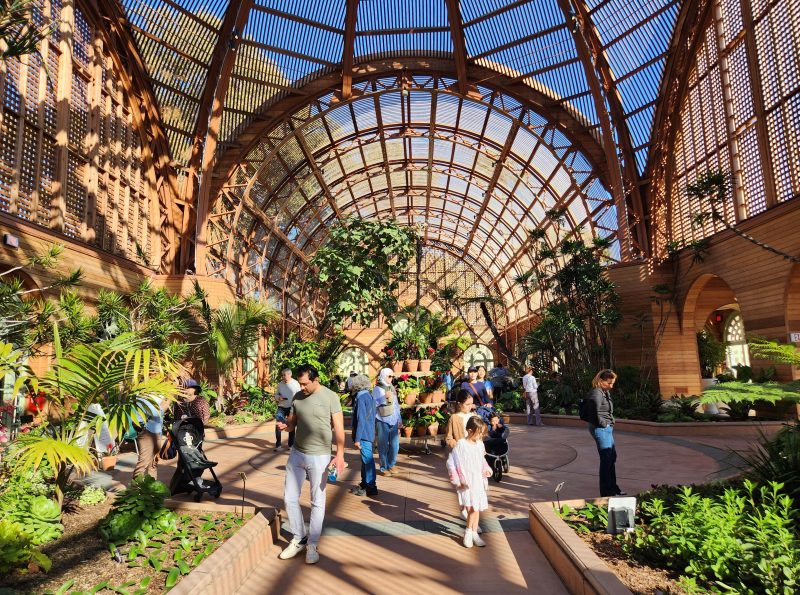


As we walked around the park grounds, we saw this Southwestern museum. It’s name translates to “Cultural Museum of the People.” With permission, I took pictures of some of the art on display.
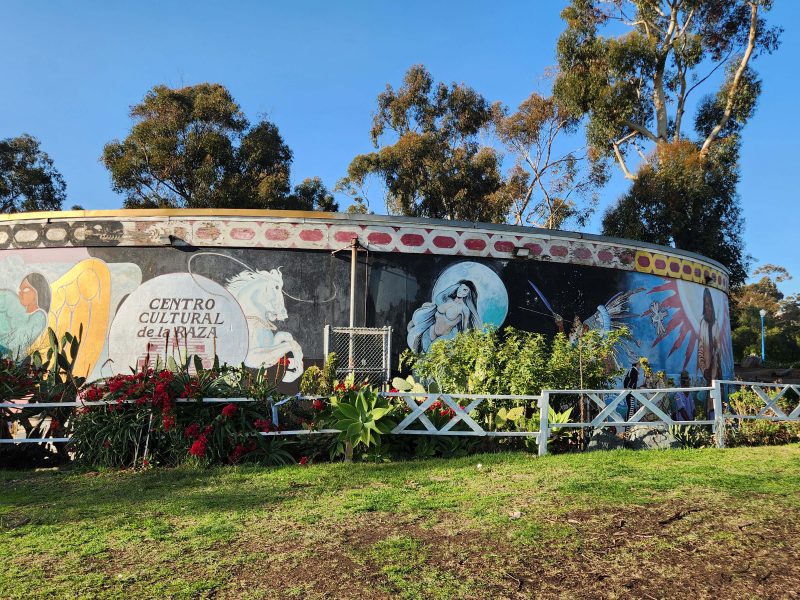


I don’t know the purpose of this building, but it’s definitely “eye”-catching! (Insert groan here.)
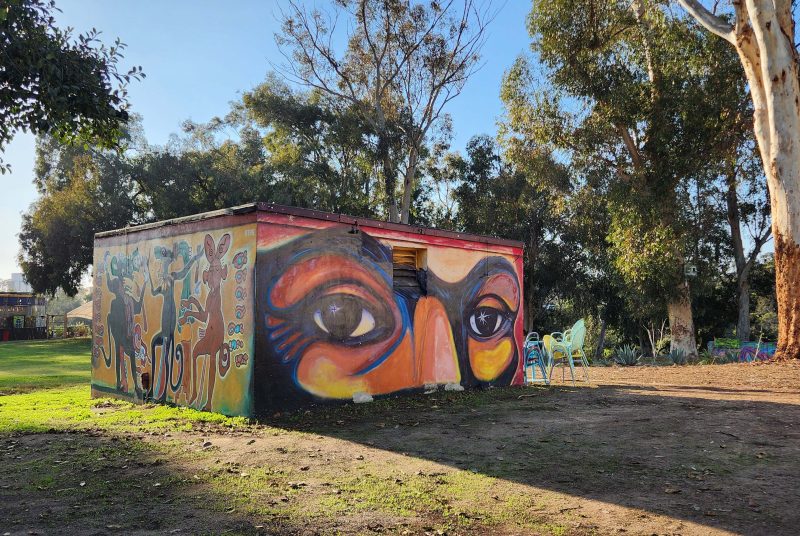
I am not knowledgeable about art movements and/or styles, but I’m sure these concrete picnic tables and benches represent a specific artistic period. I thought they were interesting to look at, but are they comfortable? Notice that no one is sitting on any of the benches.

Finally, here are the four of us, enjoying Balboa Park on a warm, sunny February day in San Diego.

Our first sightseeing stop with Jeff and La today was the Cabrillo National Monument. I’ve never heard of Cabrillo, but I’ve learned that Juan Rodriquez Cabrillo led the first European expedition to explore what is now the west coast of the United States. His contemporaries considered his expedition a failure, but Cabrillo’s writings provided a glimpse of the west coast of North America from a newcomer’s perspective.
Later Spanish explorers used Cabrillo’s records to navigate the Pacific. They learned from Cabrillo’s expedition that a wide, slow current flows from north to south along the Pacific coast of North America. Although this current provides a quick way to reach North America from Asia, it is nearly impossible to travel north, as Cabrillo and his crew found out.
There was heavy ocean fog when we arrived at the monument site. We were on a bluff at the edge of a peninsula, but we couldn’t see the water.

Here we are at Cabrillo National Monument, . . .
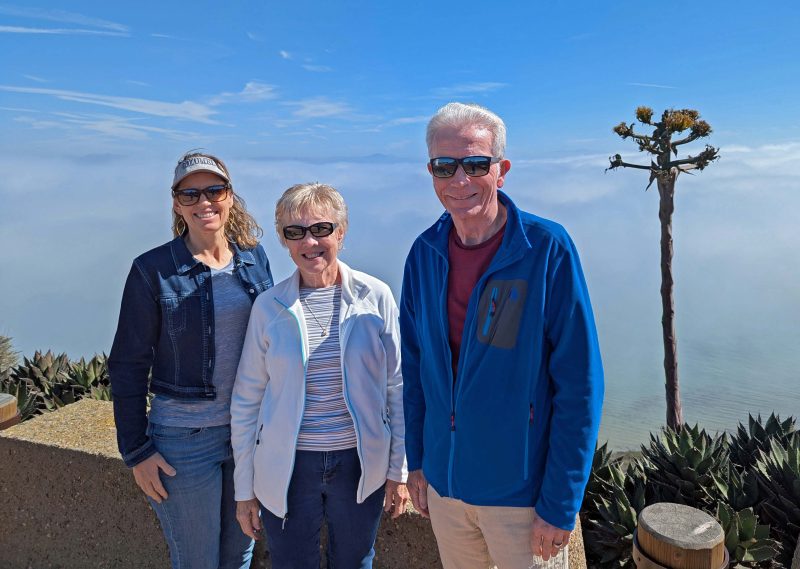
. . . and here’s the larger-than-life statue of Cabrillo, including fog in the background. La, Jeff, and Ted are standing on the left of the statue.

The historic Old Point Loma Lighthouse is near the statue of Cabrillo. It was one of the first eight west coast lighthouses to be constructed by the U.S. government. At 422 feet above sea level, its light could be seen from both the ocean and the bay sides of the peninsula.

We drove down the bluff to the beach to see tide pools. It was still a little bit foggy when we arrived.
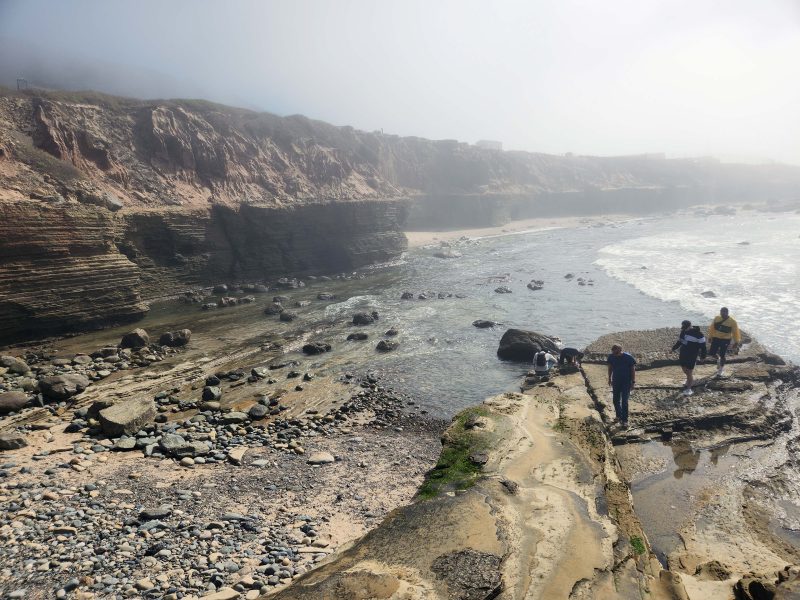
I love watching the ocean waves. Watch the white cap of the back wave move from left to right as it approaches the shoreline.
This isn’t a good beach for swimming, but it’s picturesque.
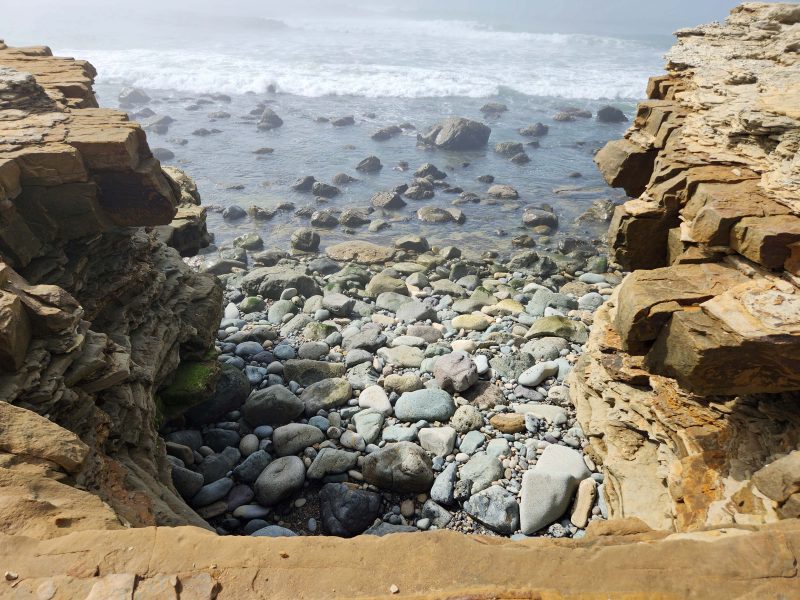
I took a geology course in college and learned about sandstone, so I knew the rocks at this beach were sandstone. These circular formations, however, fascinated me. Professor Google told me they are masses of mineral matter, usually cemented by iron oxide. They form in the sandstone layer and appear as rounded shapes when the surrounding rock erodes.
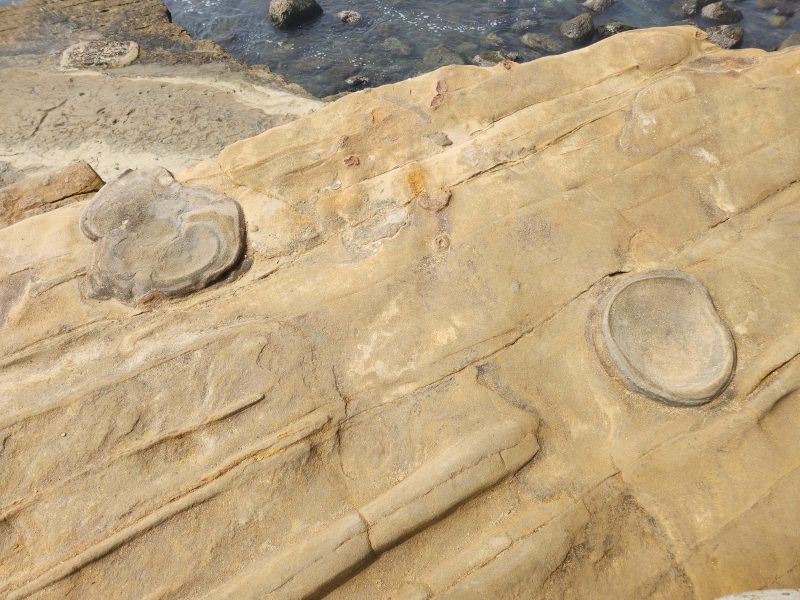
I thought these blocks of strata were interesting too.

The layered appearance of this sandstone is what I’m more familiar with. Jeff stands triumphant on the top of this bluff.
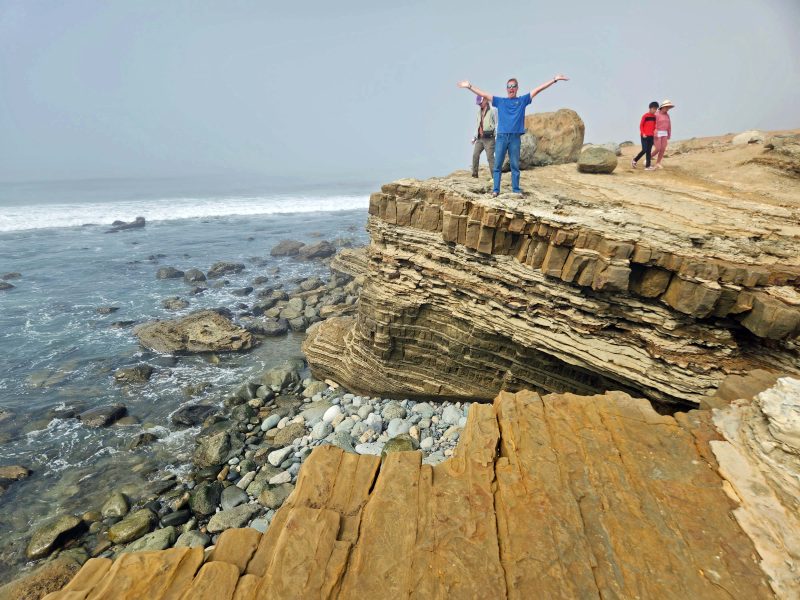
Jeff, La, and I are looking for sea life in the tide pools on this rock.
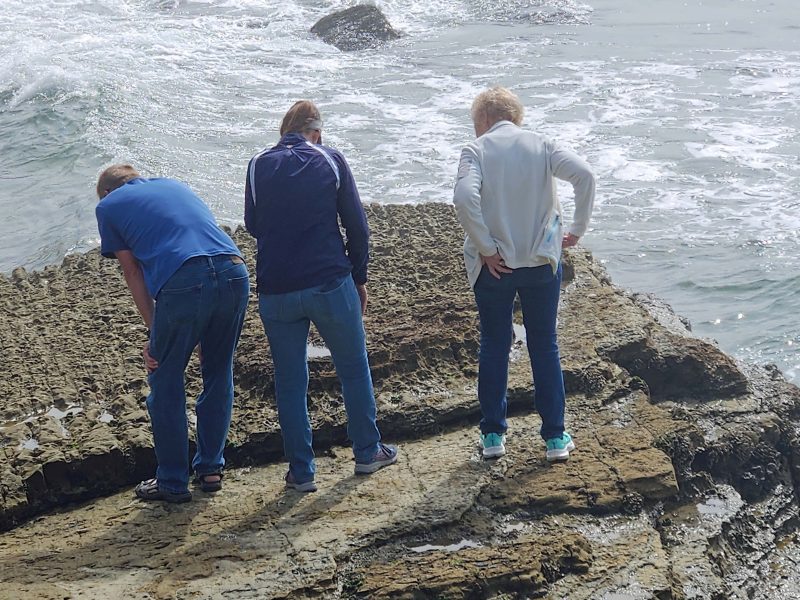
We found a wide variety of sea shells embedded in the rocks.

The arrow in this photo indicates a living, moving amoeba in a tide pool. I think the black objects to the right of the amoeba are barnacles.

These black circles look like shiny rocks, but look closer. They are pools of water. When you realize that, you’ll notice the upper edges of the holes the water is in; the reflections of those edges on the surface of the water; and–especially in the pool in the lower right–the smaller stones and sea life in the bottom of the hole beneath the water.
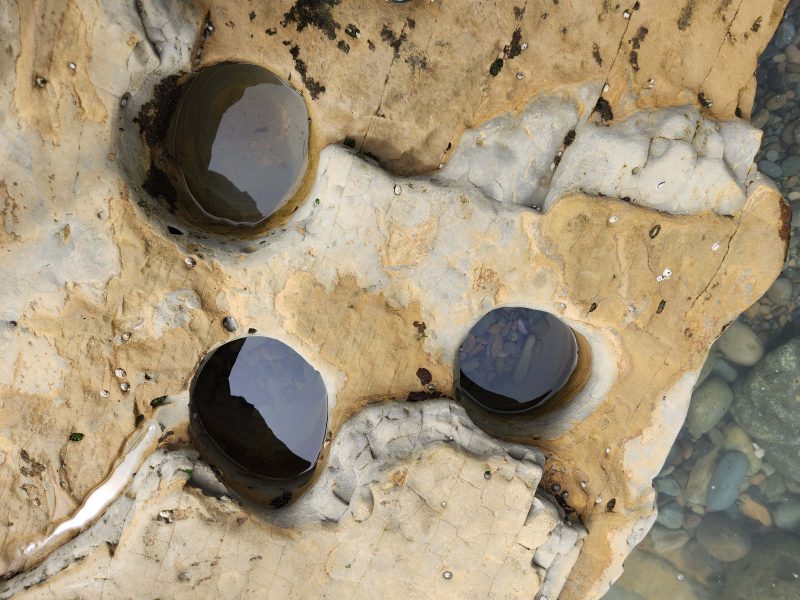
Here we are, having a good time at Cabrillo National Monument Beach.
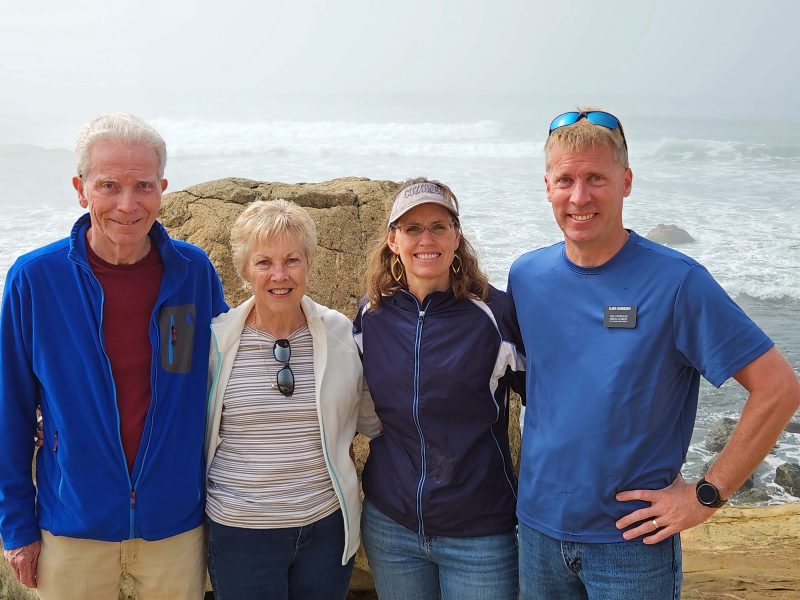
After Cabrillo, it was time for lunch. We went to Phillipo’s for pizza and salads. Does this make you think a slice of pizza would be good right now?

We all enjoyed it.

Outside of Phillipo’s, there was a chair on the sidewalk large enough to hold three of us. It begged us to climb aboard for a photo op, so we did. We did not need to hold anyone liable (see the warning on the front of the step to the chair).
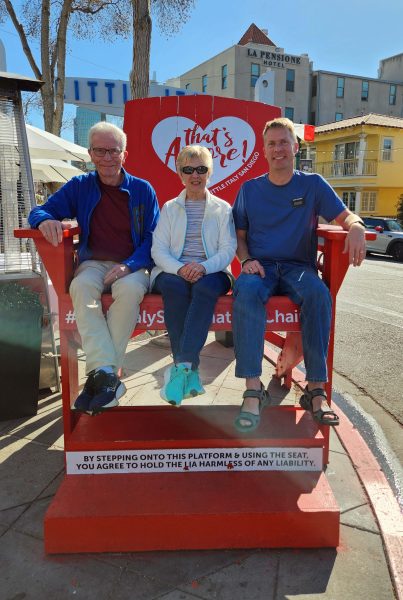
Wouldn’t you know it?! The day before Ted and I were scheduled to leave home to visit Jeff and La in warm and sunny San Diego, we had snow during the day and overnight. It was only 3 inches–nothing like the big January storm–but Ted cleared the first 2 inches from our driveway and sidewalks late in the afternoon, and the last inch in the early morning (7:00 a.m.) before we left for the airport. The roads on the way to the airport were slushy and a little slippery, but not too bad. The forecast low at our house today was 0 degrees; the forecast high in San Diego today was 68 degrees. Yes! I’m ready for some warm weather!
We boarded our plane on time, but then sat at the gate for about 90 minutes waiting for “paperwork,” as the pilot described it. It could have been stressful, but the pilot and co-pilot came into the cabin, and they and the flight crew chatted casually with the passengers. Those who were tired of sitting (and knew there were 3+ hours of sitting coming up on the flight) stood in the aisle and talked with each other. It was kind of like a pre-flight social hour (-and-a-half)–much better than 200+ grumpy people due to a flight delay. We kept Jeff and La posted on our status so they wouldn’t be waiting 90 minutes at the airport for our delayed arrival.
After Jeff and La picked us up, our first stop was Ocean View Beach. Yes! It was wonderful to see sand, sunshine, and the Pacific Ocean instead of snow!
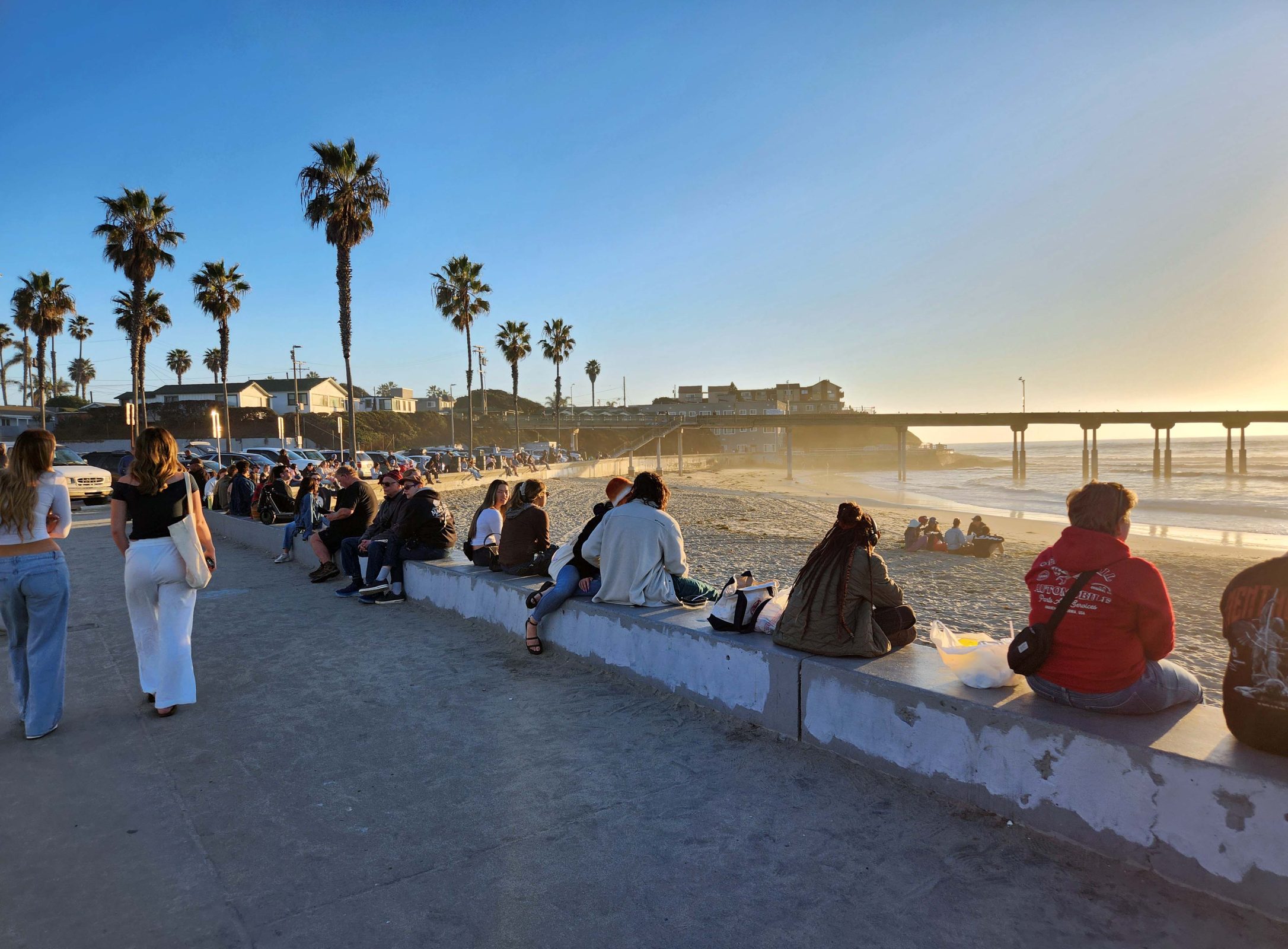
The most interesting thing at the beach was a grassy area filled with people who (apparently spontaneously) played music and did acrobatics. I took some videos of them. In this one, watch the woman in the center of the picture (wearing a pink leotard) as she flips above the man. You can hear the drums if you turn on the sound.
In this video, another woman holds a man’s hands and does a handstand over his head.
Finally, here’s a tightrope walker. Several people tried the tightrope; this guy did jumps and, at times, stood on one foot.
When we finished walking and watching on the beach, we headed for a nearby farmers’ market. The palm trees were a clue that we weren’t in cold (today) Missouri.
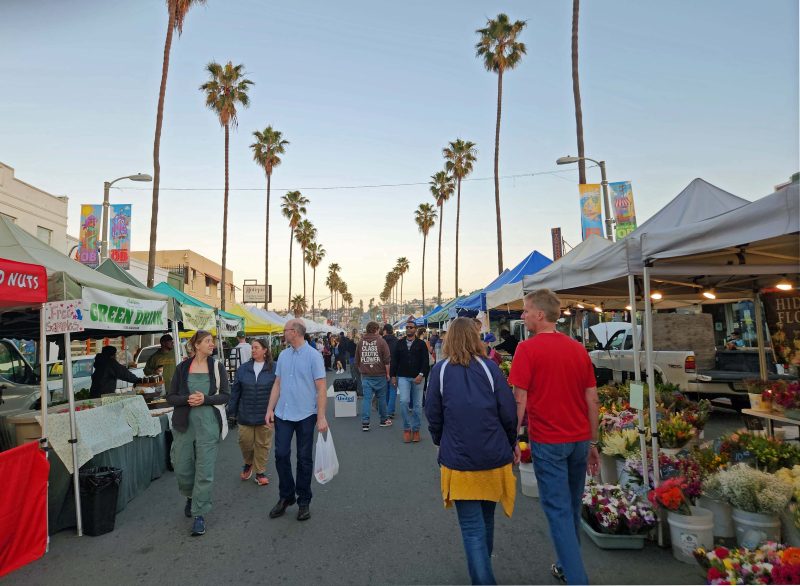
There were a lot of colorful vegetable, fruit, jewelry, and floral displays at the market.
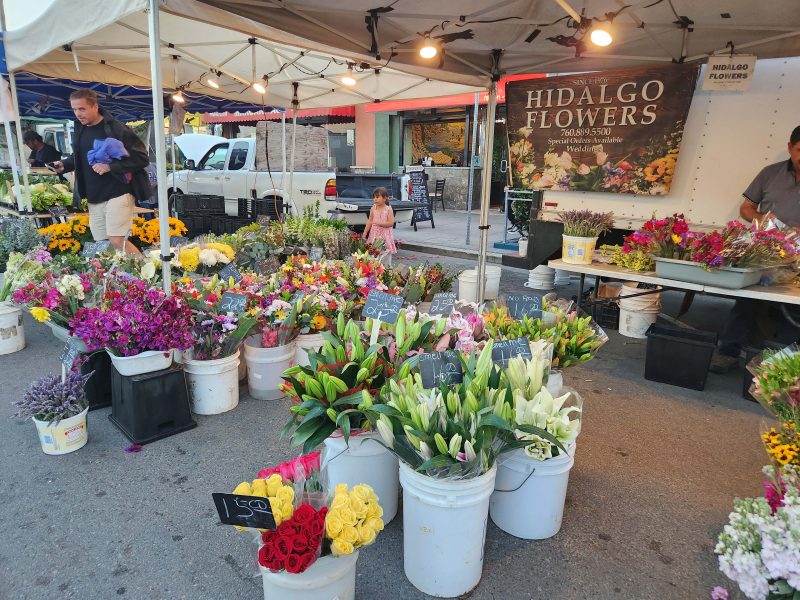
Then, it was time for lunch. We went to one of Jeff and La’s favorite San Diego restaurants: Hodad’s.

Hodad’s definitely has atmosphere. The walls are covered with license plates, and the benches are covered with stickers and more license plates. Each of us was given a souvenir sticker when we left the restaurant. Does the surfboard table say “California” to you?
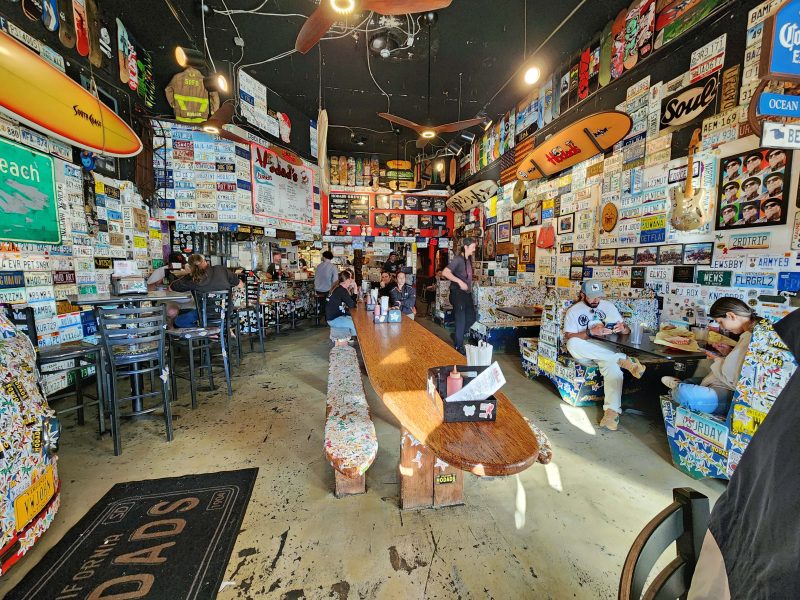
We found a Missouri license plate on one wall.
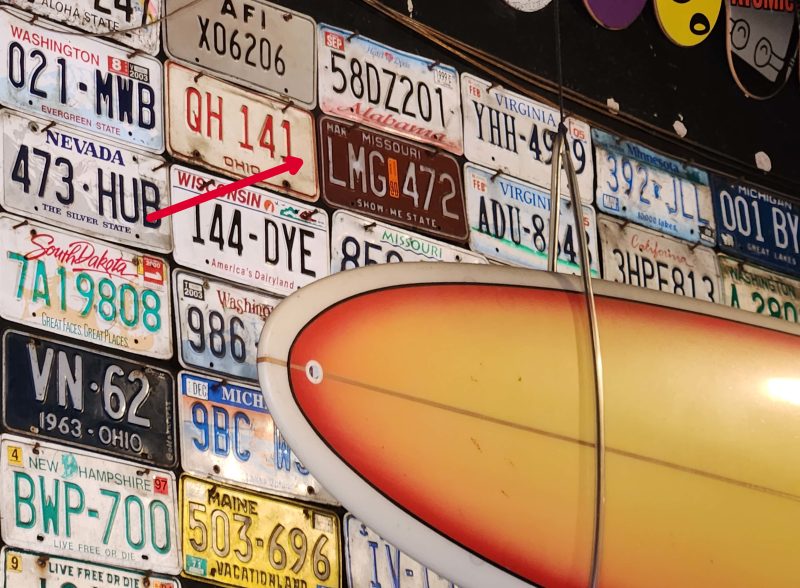
I’ll bet that you can find the “ELVIS” license plate without an arrow.

Here we are, waiting for our delicious food. We had burgers, fries, and shakes–an All-American Hodad’s lunch.

On our way back to the car, we saw these pretty bird of paradise flowers. Our first day with Jeff and La was fun. And warm!

In the reading I’ve done over the past several months, I’ve found some ideas that I found very thought-provoking. The first three are rather bleak; the last three are more positive.
This quotation is taken from FDR’s January 1937 Second Inaugural Address during the Dust Bowl years:
I see one-third of a nation ill-housed, ill-clad, ill-nourished. . . . The test of our progress is not whether we add more to the abundance of those who have much; it is whether we provide enough for those who have too little.
Franklin D. Roosevelt
In 2022, Louisiana had the highest state poverty level at 18.2 percent and our national poverty rate was 11.5 percent. We still have a long way to go to properly care for “those who have too little,” even while the wealthiest people become increasingly wealthy and legislators look for ways to decrease poverty-directed support programs such as Head Start, free school lunches, Medicaid, SNAP qualifications, etc.
~~~~~~~~~~~~
This paragraph comes from a Jodi Picoult book. I don’t remember which one, but I think it might have been Great Small Things.
Start with the sentence The unborn baby is a person. Replace the words unborn baby with the words Immigrant. African-American. Trans woman. Jew. Muslim.
Jodi Picoult
Ted and I have traveled in 36 countries and have been in all 50 of the United States. While each destination is unique, the one thing we have found that they all have in common is that people are the same wherever we go. Every individual is a person with whom we have more commonalities than differences.
This was made very clear to me when I worked with one of my professors as a graduate assistant. He was involved in a project to develop community schools in the poorest areas of St. Louis City. At those meetings, I heard people say that living in a poor neighborhood (most would call that area a ghetto) was an advantage because you could afford to buy a home. Combined with that, they wished their neighbors would keep their homes and yards neat so the neighborhood would look nicer. Parents were adamant that they didn’t want their teenage sons to be killed by or because of drugs, and they prayed their daughters would not become pregnant in high school. These values clearly align with those in the most expensive neighborhoods.
~~~~~~~~~~~~
In Percival Everett’s 2024 book, James, there is a paragraph where James discusses truth and lies. Pay attention to the last sentence.
, , , “But dey was stealin’ from dem folk. Tellin’ lies lak dey was. He weren’t neber no pirate.”
“Yes, but them people liked it, Jim. Did you see their faces? They had to know them was lies, but they wanted to believe. What do you make of that?”
“Folks be funny lak dat. Dey takes the lies dey want and throws away the truths dat scares ’em.”
Percivall Everett in his book “James.”
Yes, we all do that. Sometimes it doesn’t matter; sometimes it matters a lot.
~~~~~~~~~~~~
In her 1992 poem, “The Summer Day,” Mary Oliver says:
Tell me, what is it you plan to do / with your one wild and precious life?
Mary Oliver
I’ve never thought of my life as wild, but I love the way Oliver makes me feel like my life can make a difference and that I should not waste it.
~~~~~~~~~~~~
Gilbert K. Chesterton makes the same point.
The most extraordinary thing in the world is an ordinary man and an ordinary woman and their ordinary children.
Gilbert K. Chesterton
I think the majority of us feel there is nothing outstandingly special or important about our everyday lives, but Chesterton feels differently about us. When I think about it, he’s absolutely right.
~~~~~~~~~~~~
Finally, just to simplify your literary life, I’ll close with the words of John Gardener.
There are only two plots in all of literature: (1) A person goes on a journey; and (2) A stranger comes to town.
John Gardener
Now I’m wondering if our lives have only those same two plots. My journey through life has brought me much–love, family, friends, happiness, sadness, education, fun, skills, experiences, and so much more.
The strangers I’ve met have all been interesting in one way or another–sometimes positively, sometimes negatively. Some of them have been important to me for a relatively short period of time; others are lifelong friends. Nearly all of them have added to my experience and to my life’s journey.
I think Gardener is right: our lives and our stories are shaped by those two plots.
I have some wonderful friends, and I’m glad we express our feelings for each other. Recent friendship messages have warmed my heart.
Liz and I met at work and became friends in the middle 1990s. Our friendship has become more meaningful over the years because we know that we can trust each other with our deepest feelings and opinions and receive judgment-free support in return. As co-workers, we had adjoining offices, and because we worked in the same division, we often attended the same conferences at the Lake of the Ozarks–a three-hour drive away. We always looked forward to the drive time together because it was an uninterrupted block of three hours in each direction when we could share laughter, troubles, and everything in between. At Liz’s retirement party, I was talking with one of her friends and the lightbulb came on for her. She said, “Oh! You’re Liz’s Lake friend!” This is Liz and me. (Liz is the taller one.)

Last September, I was able to see my friend, Eileen. We had adjoining dorm rooms during our freshman and sophomore years in college and have been BFFs since then. I faint at the sight of blood, but Eileen, a nursing student, convinced me to give blood at a campus blood drive. I did it, and when I got back to the dorm, I knocked on Eileen’s door. When she opened the door, I proudly told her I had given blood without fainting–and fainted at her feet! Does that make us blood sisters? After our September 2024 visit–55 years later–Eileen sent me this message. (Note: we both look much younger–check the photo of us in the link–than these ladies.)
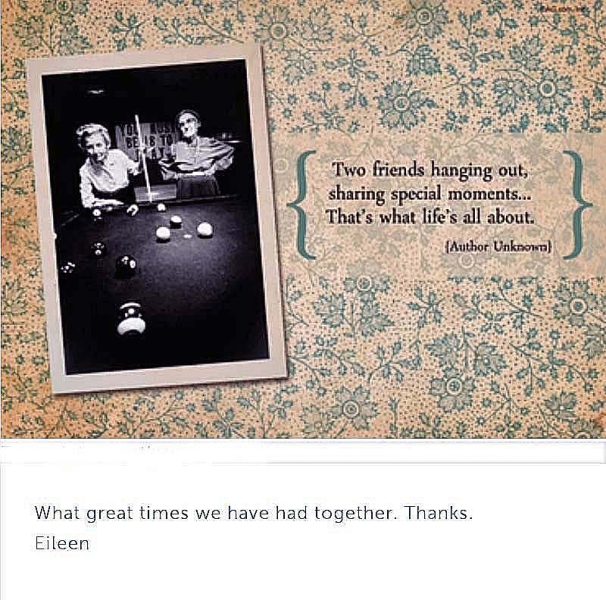
This sentiment describes me and these two friends–even though none of us has ever been in legal trouble.

English is a weird language. I enjoy the weirdness, so I’m taking this opportunity to present some of my favorite English weirdos.
I’ve posted this one before, but I thought it would be fun to include it with a set of other weird examples.
Brown’s son joined Brown’s company, so Brown decided to change the name of the company to “Brown and Son” and to have a new sign made for the shop. When the sign maker showed Brown the new sign, Brown complained, “It’s too crowded. There should be more space between Brown and and and and and Son.“
From Steve, who sent this to me
This one came from Jeff.
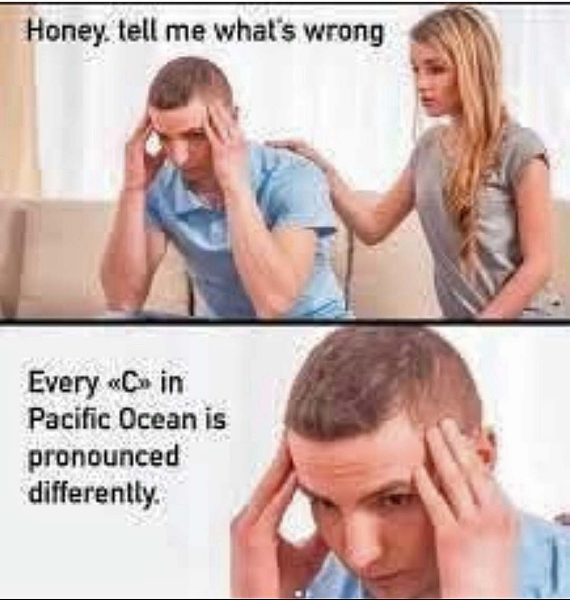
I don’t remember where I found this one. It will make sense if you read it correctly.
All the faith he had had had had no effect on him.
Unknown
Jeff also sent me this weird, but grammatically correct, sentence. I think you’ll agree that the correct use of a comma clarifies the meaning.

I posted this English spelling rule a long time ago. Mandy, one of my office co-workers back in the day before I retired, sent this to me. In case you’ve forgotten, the rule says “I before E, except after C, or when sounded like A, as in neighbor or weigh.” Mandy imagined this mug filled with beige caffeine. Weird.

Moving on from weird English grammar and spelling rules, let’s go to the trivia question of the day on a recent local news broadcast: Which English word has the most definitions? It’s not something I ever wondered about, so I didn’t have a clue. The answer on the program was “set.” I went to Professor Google to verify the information and got these responses.

Well! That was inconclusive! I dug a little deeper and found this.

How many definitions can you give for “run” and/or “set”?
If all of these weird English grammar and spelling examples are too confusing, just follow this advice.

Mike and Mary Jane like history and so do Ted and I, so we had an “historic” day together. We met for lunch at Blueberry Hill, a St. Louis landmark restaurant and music club that opened in 1972.
Blueberry Hill has rooms for eating, for parties, and for weekly live musical performances. One of the rooms is named the Elvis Room; another is named the Duck Room in honor of Chuck Berry’s duck walk. Chuck Berry, the first person inducted into the Rock & Roll Hall of Fame, inaugurated the Duck Room and played 209 consecutive monthly concerts there–doing his duck walk, of course. Many famous musicians have played at Blueberry Hill, and the walls have hundreds of framed pictures of the owner with each of them, as well as with four U.S. presidents.
The owner of Blueberry Hill started collecting things as a child and displays his collections in (again) hundreds of showcases throughout the building. His collections feature every kind of pop culture memorabilia imaginable, including Howdy Doody, the Simpsons, Chuck Berry, Star Wars, jukeboxes, lunch boxes, toys, and more.
Today, the four of us came to Blueberry Hill for lunch. We plan to come back on another day to explore the restaurant’s museum-like rooms and displays. You can’t always get a level photo with a selfie, but Mike managed to fit all of us in his picture.

These are the walls in one of the restaurant’s rooms.

Here’s a wall in the room where we were seated. In case you missed it, I added an arrow to the picture of Elvis for your convenience. 🙂

The St. Louis Walk of Fame honors people from the St. Louis area who were either born here or who spent their formative or creative years here. The more than 170 honorees are from all walks of life and areas of achievement and have made major contributions to the city’s cultural heritage. The Walk of Fame sidewalk passes Blueberry Hill, so we saw some of the stars as we entered and left the restaurant. Below are stars for Chuck Berry (musician), Bob Costas (sportscaster), and Stan Musial (baseball player).

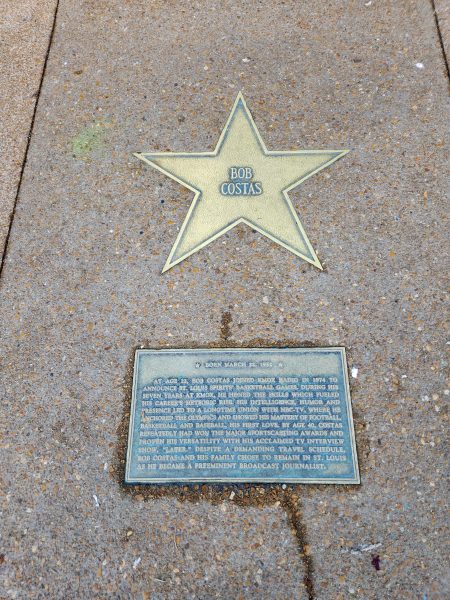

Our primary destination today was the Missouri History Museum, housed in the original 1913 Jefferson Memorial building. The memorial was constructed with proceeds from the 1904 St. Louis World’s Fair and stands at what was the main entrance to the fair. This was the first national monument to Jefferson. (Why would St. Louis build the first monument to Jefferson? Think Louisiana Purchase.)
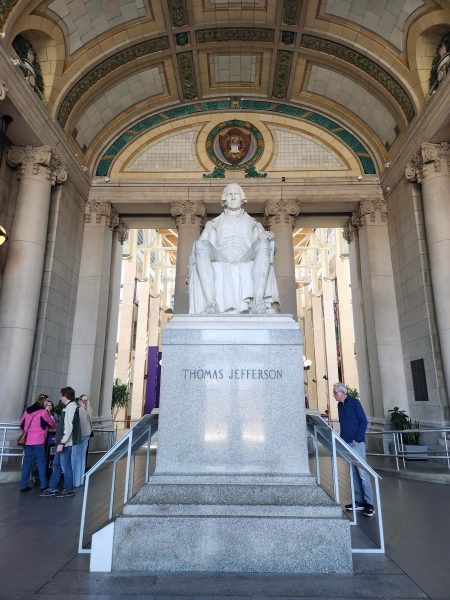
A replica of Charles Lindbergh’s Spirit of St. Louis airplane hangs over the atrium area. The original airplane is housed in the Smithsonian National Air and Space Museum in Washington, D.C. and is one of that museum’s most popular attractions.
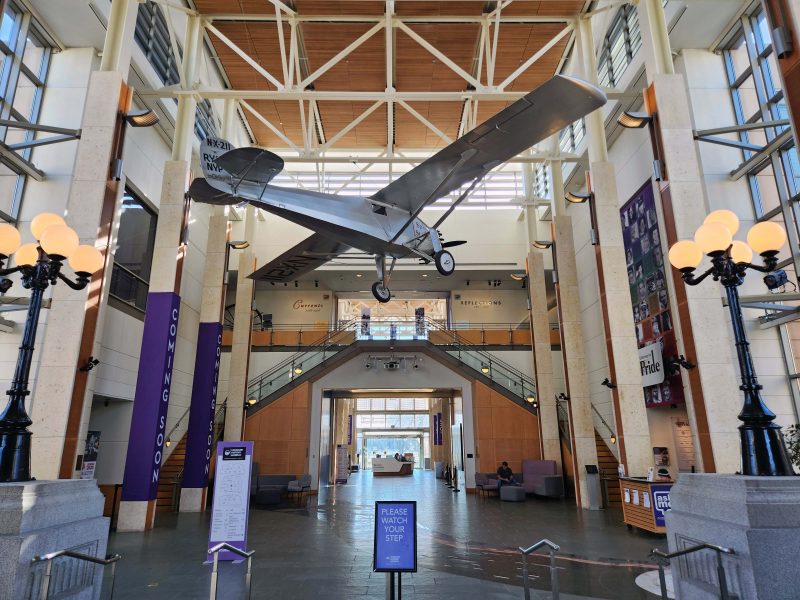
Our main interest at the museum today was the updated 1803 Louisiana Purchase Exposition, commonly referred to as the 1904 St. Louis World’s Fair exhibit. (The Exposition wasn’t finished in time for its scheduled 1903 opening.) The fair was held from April 30-December 1, 1904. The model of the fairgrounds in the photo below is built on a 1:400 scale. The fairgrounds covered 1,200 acres of the present-day 1,300-acre area of Forest Park, with the Palace of Agriculture alone covering approximately 20 acres. The fair featured over 1,500 buildings connected by 75 miles of roads and walkways. Over 19 million people attended the event.
Many of the fair exhibits focused on themes of racism and imperialism. This 2024 update of the museum’s exhibit includes information about those themes, rather than “sweeping them under the rug” and focusing only on the entertainment, new consumer goods, and architecture featured at the fair.
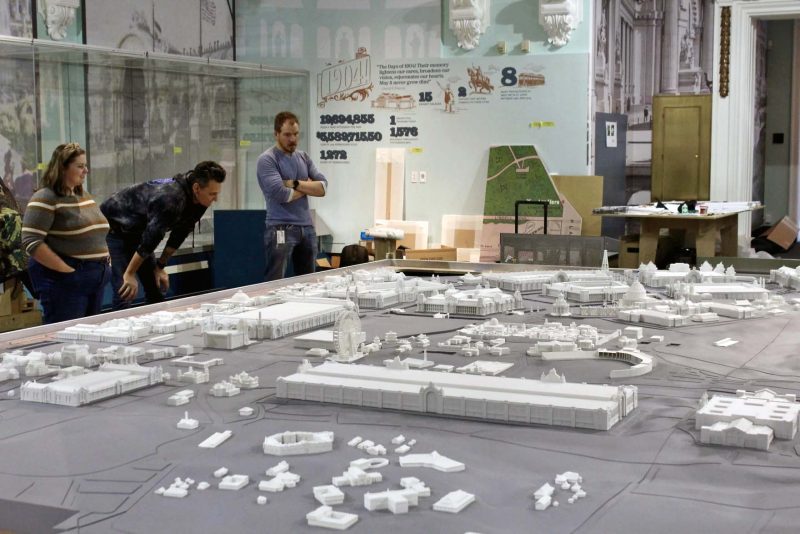
Here are some statistics about the 1904 World’s Fair.

There have been many claims that the ice cream cone was invented at the 1904 World’s Fair, but that’s not true. Several places claim that invention in the late 1800s, but the 1904 World’s Fair greatly contributed to the popularity of the ice cream cone.
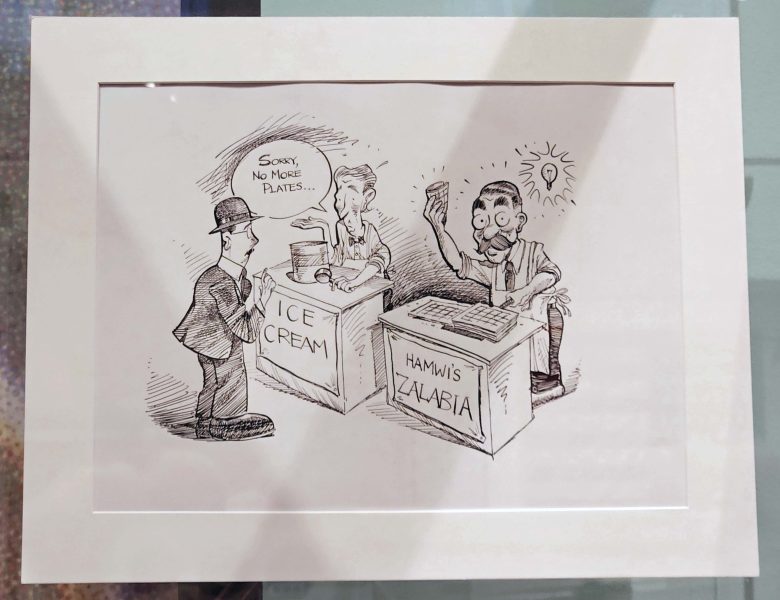
Ted and I saw a wall like this in North Dakota. Just as in North Dakota, these stories and comments were fun to read.
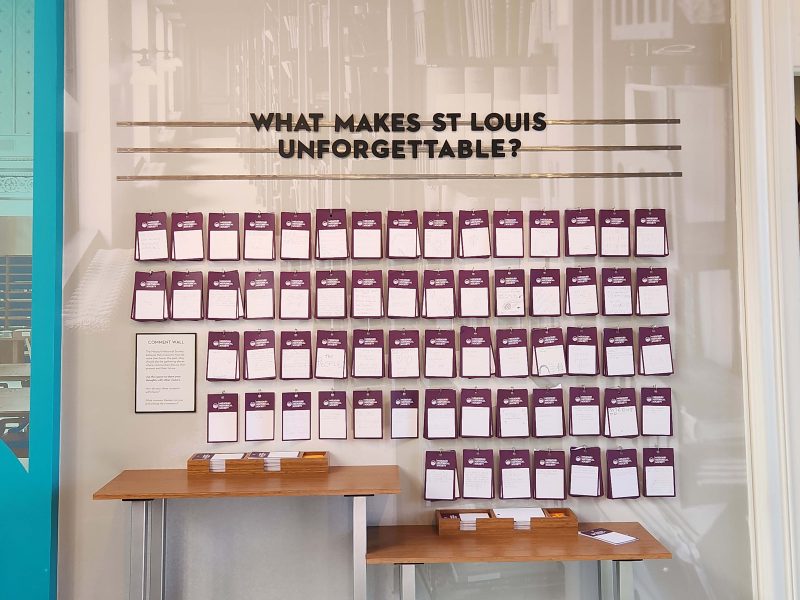
So what makes St. Louis unforgettable? Read on to discover four writers’ opinions.
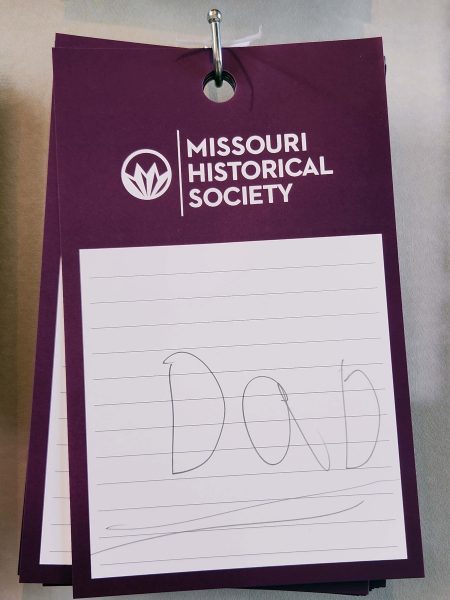



History can be fun. We all had a great time enjoying Blueberry Hill, a bit of the St. Louis Walk of Fame, and the Missouri History Museum.
Ted has been in a clean-up mood and has gone through all kinds of things in our storage room, including old photos. He found these two, and the memories they brought us were so-o-o-o good.
Kyra looks like she’s about three years old in this picture. I sent her a copy of the photo and she mentioned that she has some strange-looking bangs. I think it’s a rite of passage for toddlers to cut hair. Hopefully, they don’t run with the scissors.
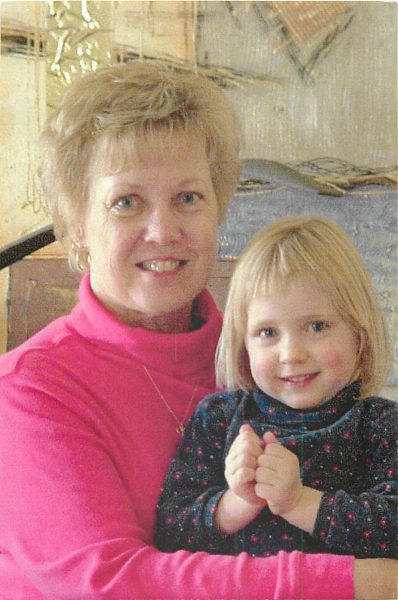
I think this picture was taken in 1995. Ted and I took Kathy and Kari on a road trip that included Sleeping Bear Dunes National Lakeshore in Michigan.
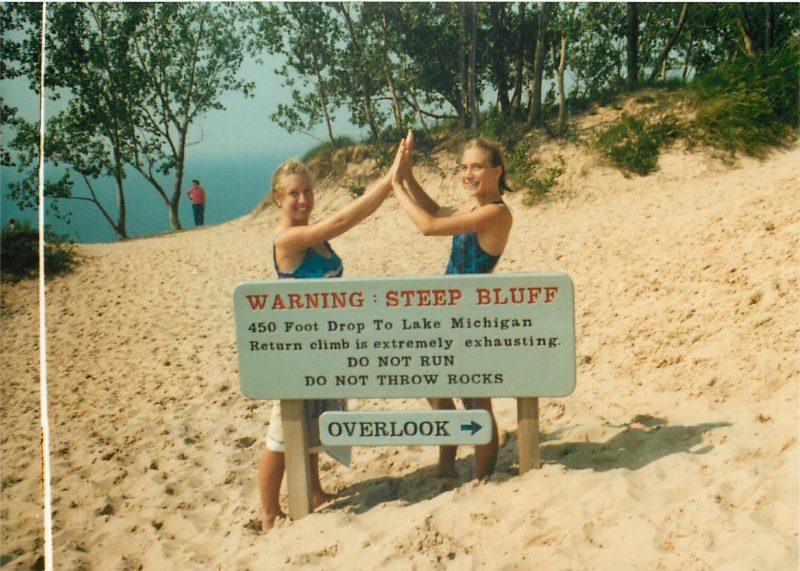
I don’t know where the other photos of that trip are, but maybe Ted will find them. I found these images online for any of my readers who have not been to Sleeping Bear. The lake is 450 feet below this sand dune. Look at the tiny people on the dune for a perspective of its size. The girls and I went down to swim in the lake.

This is how we went down to the lake. If you take long steps, the drop is so steep that each forward step + gravity = a lot of distance downward. The airborne time gives a sensation of flying, so getting to the lakeshore was a blast. Climbing back to the top was harder, although we saw some cross-country teams running up the dune for practice. I know we went other places on this trip, but Sleeping Bear is the only one I remember.
